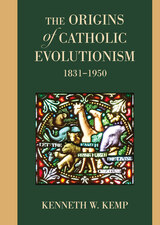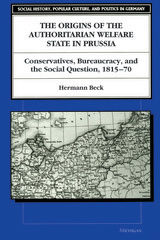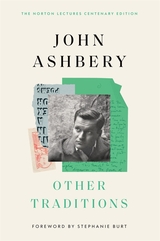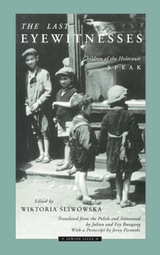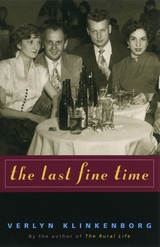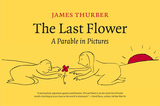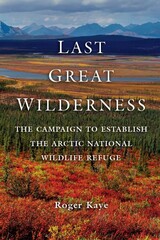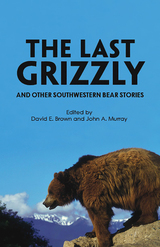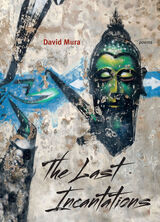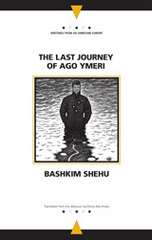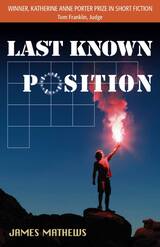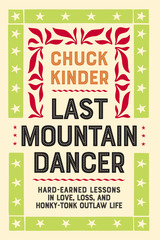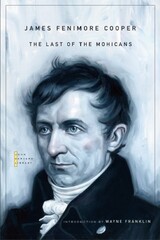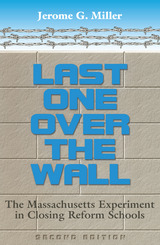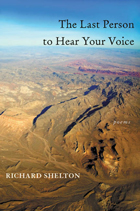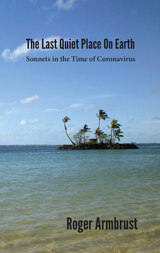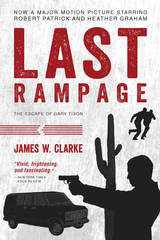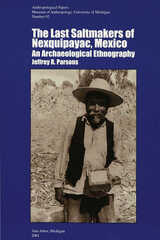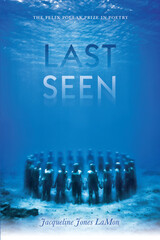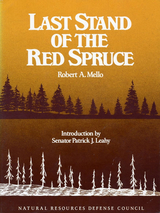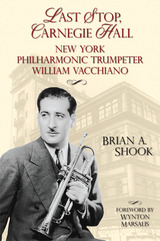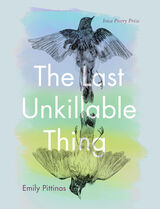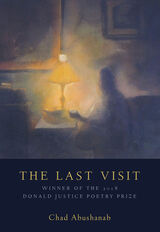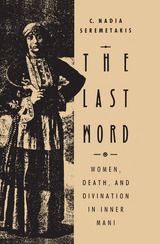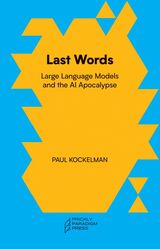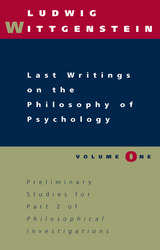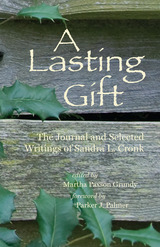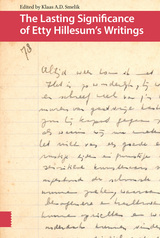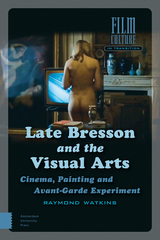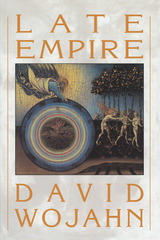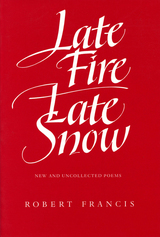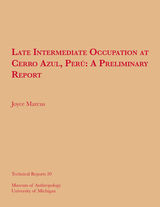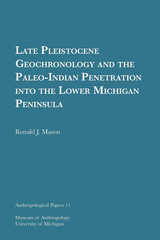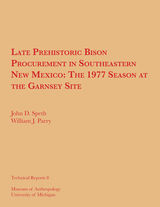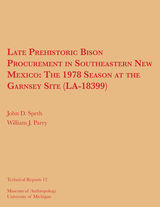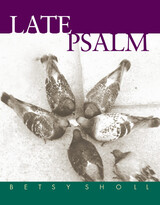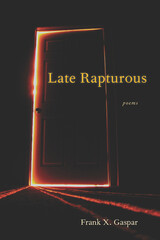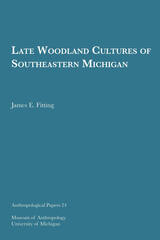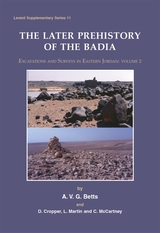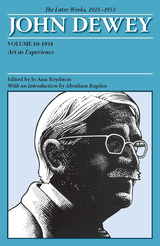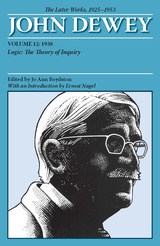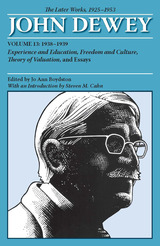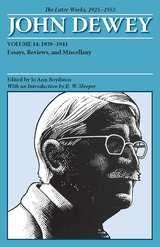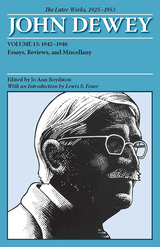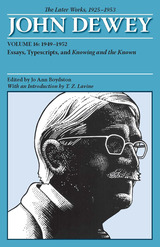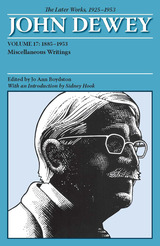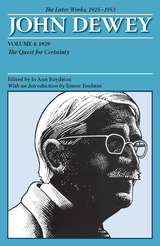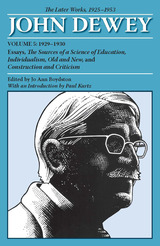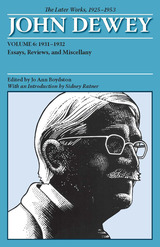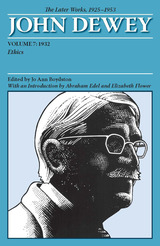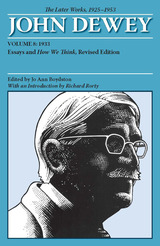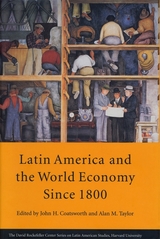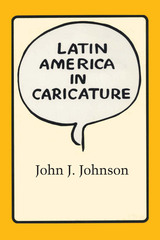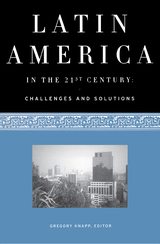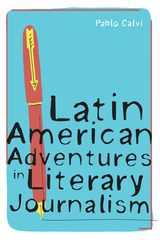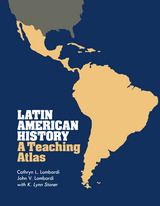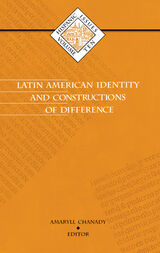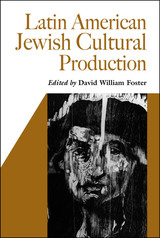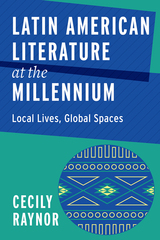 The Last Empire: Thirty Years of Portuguese Decolonization
António Costa Pinto
Intellect Books, 2003 This book is the result of a conference organised by the Contemporary Portuguese Political History Research Centre (CPHRC) and the University of Dundee that took place during September 2000. The purpose of this conference, and the resulting book, was to bring together various experts in the field to analyse and debate the process of Portuguese decolonisation, which was then 25 years old, and the effects of this on the Portuguese themselves. For over one century, the Portuguese state had defined its foreign policy on the basis of its vast empire &endash; this was the root of its 'Atlanticist' vision. The outbreak of war of liberation in its African territories, which were prompted by the new international support for self determination in colonised territories, was a serious threat that undermined the very foundations of the Portuguese state. This book examines the nature of this threat, how the Portuguese state initially attempted to overcome it by force, and how new pressures within Portuguese society were given space to emerge as a consequence of the colonial wars. This is the first book that takes a multidisciplinary look at both the causes and the consequences of Portuguese decolonisation &endash; and is the only one that places the loss of Portugal's Eastern Empire in the context of the loss of its African Empire. Furthermore, it is the only English language book that relates the process of Portuguese decolonisation with the search for a new Portuguese vision of its place in the world.
This book is intended for anyone who is interested in regime change, decolonisation, political revolutions and the growth and development of the European Union. It will also be useful for those who are interested in contemporary developments in civil society and state ideologies. Given that a large part of the book is dedicated to the process of change in the various countries of the former Portuguese Empire, it will also be of interest to students of Africa. It will be useful to those who study decolonisation processes within the other former European Empires, as it provides comparative detail. The book will be most useful to academic researchers and students of comparative politics and area studies.
The Last Eyewitnesses: Children of the Holocaust Speak
Wiktoria Sliwowska
Northwestern University Press, 1998 These testimonies, submitted by individual authors and not originally intended for publication, were assembled as a historical record by the Association of the Children of the Holocaust in Poland. While evil and brutal anti-Semitism are described, the accounts also reveal the great risks taken by courageous individuals in order to save Jewish children.
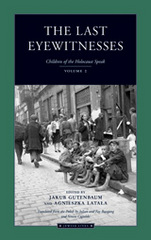 The Last Eyewitnesses, Volume 2: The Children of the Holocaust Speak
Jakub Gutenbaum and Agnieszka Latala
Northwestern University Press, 2005 The memoirs of Jews who were children during the Nazi occupation of Poland
This book serves as a memorial to loved ones who do not even have a grave, as well as a tribute to those who risked their lives and families to save a Jewish child. A wide variety of experiences during the Nazi occupation of Poland are related with wrenching simplicity and candor, experiences that illustrate horrors and deprivation, but also present examples of courage and compassion.
These recollections-whether of hiding in forests or camouflaged bunkers, fighting with groups of partisans, enduring the horrors of concentration camps, or living in fear under disguised identities-serve as eloquent testimony to the depth, diversity, and richness of humanity under siege and offer a powerful lesson for future generations. Written by people who remained in Poland after the war, these accounts convey a great immediacy; the authors are not removed from the environment in which these experiences took place. The psychological impact on these child survivors and the difficulties they encountered even after the war are very poignant. The passing years have brought urgency to the publication of these stories, as those who wrote them are the last surviving eyewitnesses of these tumultuous events.
The Last Fine Time
Verlyn Klinkenborg
University of Chicago Press, 2004 By turns, an elegy, a celebration, and a social history, The Last Fine Time is a tour de force of lyrical style. Verlyn Klinkenborg chronicles the life of a family-owned restaurant in Buffalo, New York, from its days as a prewar Polish tavern to its reincarnation as George & Eddie's, a swank nightspot serving highballs and French-fried shrimp to a generation of optimistic and prosperous Americans. In the inevitable dimming of the neon sign outside the restaurant, we see both the passing of an old world way of life and the end to the postwar exuberance that was Eddie Wenzek's "last fine time."
 Last Flight from Singapore
Arthur G. Donahue
Westholme Publishing, 2014 The First American Volunteer to Serve in the RAF During World War II Who Fought in the Battle of Britain and Then Defended Singapore Against the Japanese Invasion As one of the storied few who defeated the Nazi Luftwaffe during the Battle of Britain, American Arthur G. Donahue—Royal Air Force Flight Lieutenant and recipient of the Distinguished Flying Cross—wished to continue his service and requested overseas duty. In October 1941, he was sent to the British protectorate of Singapore as a precaution against a possible threat from Japan, which was already conducting a war in China. Within two months, all of Asia was thrown into turmoil as Japan simultaneously bombed Hawaii and invaded the Philippines and the Dutch East Indies. Japanese forces swiftly conquered much of Southeast Asia and began moving toward Burma and India. Standing in the face of this onslaught was the British stronghold of Singapore. Donahue and his squadron began around-the-clock sorties, reminiscent of their battle against Germany a little more than one year earlier. This time, however, the British forces were overwhelmed and they were forced to surrender the city to the Japanese in February 1942, an event Winston Churchill called “the worst disaster” in British history. During the final phase of the battle, Donahue was wounded while strafing Japanese transports unloading troops to storm Singapore. He managed to land, and was airlifted on the last flight from the city and ultimately to a hospital in India.
In Last Flight from Singapore, Donahue tells his dramatic story, accompanied by photographs he took himself, of the intense and futile battle against the Japanese for control of the gateway to the Malay Peninsula. He continues his story through his convalescence to his return to England, where he once again began patrols over Europe. The manuscript for Last Flight from Singapore was found among his effects after he did not return from a patrol in 1942 and was presumed lost.
The Last Flower: A Parable in Pictures
James Thurber
University of Iowa Press, 2007 Originally published in November 1939, two months after World War II officially began, James Thurber's parable in pictures-- a graphic novel ahead of its day--about eternal cycles of war, peace, love, and the resilience of one little flower remains as relevant today as it was then. The New York Times called it "at once one of the most serious and one of the most hilarious contributions on war."
Civilization has collapsed after World War XII, dogs have deserted their masters, all the groves and gardens have been destroyed, and love has vanished from the earth. Then one day, "a young girl who had never seen a flower chanced to come upon the last one in the world." Written among the sorrow and chaos of war, dedicated to this only child " in the wistful hope that her world will be better than mine." The new printing will feature new scans of Thurber's original 1939 drawings.
Last Flowers: A Translation of Moschus and Bion
Henry Harmon Chamberlin
Harvard University Press Mr. Chamberlin’s delightful translation of Theocritus, which we published a year ago with the title, Late Spring, is now followed by an equally fine rendering of Moschus and Bion, thus completing the work of the three outstanding bucolic poets of all time. As in the earlier volume, Mr. Chamberlin has adopted poetry as his medium. So far as possible, he has put himself in the place of the poets and their audience, and reproduced the effect they made upon their readers. Lovers of poetry and of classical antiquity will agree that once more Mr. Chamberlin has succeeded in a difficult task.
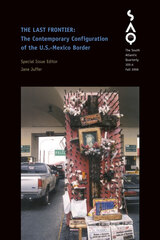 The Last Frontier: The Contemporary Configuration of the U.S.-Mexico Border, Volume 105
Jane Juffer, ed.
Duke University Press The Bush administration has designated the U.S.-Mexico border “the last frontier” against potential terrorists from Latin America. Analyzing the human costs, The Last Frontier explores the effects of neoliberal policies on the border. On the one hand, neoliberal economics depend on open borders for the free flow of trade and the maintenance of a low-wage labor force. On the other, both Mexico and the United States continue to heighten surveillance mechanisms and Border Patrol forces, especially in the wake of September 11, in an attempt to close those borders. Covering a range of disciplinary perspectives—geography, political science, anthropology, American studies, literary studies, and environmental studies—these essays contend that U.S. policies to curtail immigration and drug trafficking along the Mexican border are ineffective. George W. Bush’s call for a volunteer security force has legitimized a vigilante presence through the formation of Minutemen civilian border patrols, in addition to larger numbers of Border Patrol agents and expanded detention centers. One contributor argues that, due to the increasingly dangerous border-crossing conditions, more undocumented immigrants are remaining in the United States year-round rather than following the traditional seasonal pattern of work and returning to Mexico. Another contributor interviews drug smugglers and government officials, revealing the gap between reality and the claims of success by the U.S. government in the “war on drugs.” Focusing on the social justice movement Ni Una Mas (Not One More), one essay delves into the controversy over the unsolved murders of hundreds of young women in the border town of Ciudad Juárez and the refusal of the government to investigate these murders properly. Other essays consider instances of resistance and activism—ranging from political movements and protests by NGOs to artistic expression through alternative narratives, poetry, and photography—against the consequences of neoliberalism on the border and its populations. Contributors. Ana M. Manzanas Calvo, Alicia Schmidt Camacho, Arturo Dávila, Sarah Hill, Jane Juffer, Laura Lewis, Alejandro Lugo, Tony Payan, Claudia Sadowski-Smith, Santiago Vaquera, Melissa Wright
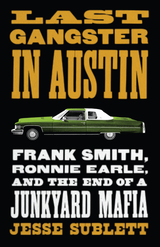 Last Gangster in Austin: Frank Smith, Ronnie Earle, and the End of a Junkyard Mafia
Jesse Sublett
University of Texas Press, 2021 Ronnie Earle was a Texas legend. During his three decades as the district attorney responsible for Austin and surrounding Travis County, he prosecuted corrupt corporate executives and state officials, including the notorious US congressman Tom DeLay. But Earle maintained that the biggest case of his career was the one involving Frank Hughey Smith, the ex-convict millionaire, alleged criminal mastermind, and Dixie Mafia figure. With the help of corrupt local authorities, Smith spent the 1970s building a criminal empire in auto salvage and bail bonds. But there was one problem: a rival in the salvage business threatened his dominance. Smith hired arsonists to destroy the rival; when they botched the job, he sent three gunmen, but the robbery they planned was a bloody fiasco. Investigators were convinced that Smith was guilty, but many were skeptical that the newly elected and inexperienced Earle could get a conviction. Amid the courtroom drama and underworld plots the book describes, Willie Nelson makes a cameo. So do the private eyes, hired guns, and madams who kept Austin not only weird but also riddled with vice. An extraordinary true story, Last Gangster in Austin paints an unusual picture of the Texas capital as a place that was wild, wonderful, and as crooked as the dirt road to paradise.
The Last Generation: Work and Life in the Textile Mills of Lowell, Massachusetts, 1910-1960
Mary H. Blewett
University of Massachusetts Press, 1990 Oral histories of many of the last generation of Lowell, MA, textile mill workers preceded by two introductory sections. The first presents the historic setting of economic development and subsequent decline of the textile industry in Lowell. The second is a brief explanation of the production process wherin the last generation of mill workers expended so many of their skills and so much of their energy.
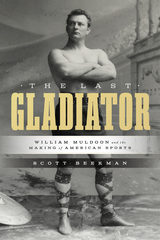 The Last Gladiator: William Muldoon and the Making of American Sports
Scott Beekman
University of Texas Press, 2025 The incredible career of the forgotten but foundational pro wrestler who shaped American sports culture. William Muldoon was an infamous athlete whose prowess, savvy, and chicanery across his six-decade career led him to wealth, cultural importance, and political power. Muldoon, the child of poor Irish immigrants, began wrestling in the 1870s and quickly became one of the most famous athletes of the post–Civil War era. He started acting and modeling as his popularity grew, making him one of the first sports stars to achieve crossover success. After a triumphant stint rehabilitating fallen boxing heavyweight champion John L. Sullivan in 1889, he retired from the ring and began a new career as a fitness impresario, founding an elite gymnasium and remaking himself as a health authority in the press. He became trainer to the rich, famous, and politically powerful, which led to his appointment as chair of the New York State Athletic Commission in the 1920s. From this position, Muldoon exerted his influence over the rules of boxing and wrestling and weaponized his power to maintain segregation in sport. The Last Gladiator is a deep, insightful dive into Muldoon’s life and impact, demonstrating the significance of this often-controversial figure in the development of American sports, professional wrestling, and physical and popular culture.
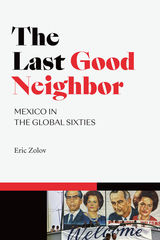 The Last Good Neighbor: Mexico in the Global Sixties
Eric Zolov
Duke University Press, 2020 In The Last Good Neighbor Eric Zolov presents a revisionist account of Mexican domestic politics and international relations during the long 1960s, tracing how Mexico emerged from the shadow of FDR's Good Neighbor policy to become a geopolitical player in its own right during the Cold War. Zolov shows how President Adolfo López Mateos (1958–1964) leveraged Mexico's historical ties with the United States while harnessing the left's passionate calls for solidarity with developing nations in a bold attempt to alter the course of global politics. During this period, Mexico forged relationships with the Soviet Bloc, took positions at odds with US interests, and entered the scene of Third World internationalism. Drawing on archival research from Mexico, the United States, and Britain, Zolov gives a broad perspective on the multitudinous, transnational forces that shaped Mexican political culture in ways that challenge standard histories of the period.
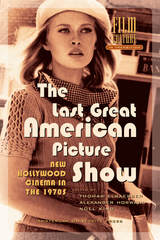 The Last Great American Picture Show: New Hollywood Cinema in the 1970s
Edited by Thomas Elsaesser, Noel King, and Alexander Horwath
Amsterdam University Press, 2004 The French Connection, The Last Picture Show, M.A.S.H., Harold and Maude—these are only a few of the iconic films made in the United States during the 1970s. Originally considered a "lost generation," the 1970s are increasingly recognized as a crucial turning point in American filmmaking, and many films from the era have resurfaced from oblivion to become a reference for new directorial talents. The Last Great American Picture Show explores this pivotal era in American film history with a collection of essays by scholars and writers that firmly situates the decade as the time of the emergence of "New Hollywood."
Sam Peckinpah, Arthur Penn, Peter Bogdanovich, Monte Hellman, Bob Rafelson, Hal Ashy, Robert Altman, and James Tobac: these legendary directors developed innovative techniques, gritty aesthetics, and a modern sensibility in American film. Here, contributors compellingly argue that the cinema of today's major directors—Steven Spielberg, James Cameron, Quentin Tarantino, Ridley Scott, Robert Zemeckis—could not have come into existence without the groundbreaking works produced by the directors of the 1970s. A wholly engaging and long-overdue investigation of this important era in American film, The Last Great American Picture Show reveals how the films of the 1970s transformed the American social consciousness and influenced filmmaking worldwide.
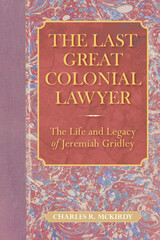 The Last Great Colonial Lawyer: The Life and Legacy of Jeremiah Gridley
Charles R. McKirdy
University of Massachusetts Press, 2018 Jeremiah Gridley (1702–1767) is considered "the greatest New England lawyer of his generation," yet we know little about him. Most of his renown is a product of the fame of his students, most notably John Adams. Gridley deserves more. He was an active participant in the Writs of Assistance trial and the Stamp Act controversy, and as a leader of the Boston bar, an editor, speculator, legislator, and politician, his life touched and was touched by much that was integral to eighteenth-century Massachusetts.
The Last Great Colonial Lawyer presents a portrait of Gridley against the background of his times. Religious controversies enter into this narrative, as do colonial wars and the increasing strains with Great Britain, but Charles R. McKirdy also rescues from the footnotes of time subjects such as the smallpox epidemic of 1721 and the currency crisis of the 1740s. Because Gridley was above all a lawyer, the primary focus is on his cases, which illuminate in a unique and very human way attitudes regarding race, status, commerce, property, and power.
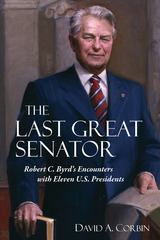 The Last Great Senator: Robert C. Byrd's Encounters with Eleven U.S. Presidents
David Corbin
West Virginia University Press, 2015 No person involved in so much history received so little attention as the late Robert C. Byrd, the longest-serving U.S. senator. In The Last Great Senator, David A. Corbin examines Byrd’s complex and fascinating relationships with eleven presidents of the United States, from Eisenhower to Obama. Furthermore, Byrd had an impact on nearly every significant event of the last half century, including the Cold War, the civil rights movement, the Vietnam War, Kennedy’s New Frontier, the Watergate scandal, the Reagan Revolution, the impeachment of President Clinton, and the Iraq War. Holding several Senate records, Byrd also cast more votes than any other U.S. senator. In his sweeping portrait of this eloquent and persuasive man’s epic life and career, Corbin describes Senator Byrd’s humble background in the coalfields of southern West Virginia (including his brief membership in the Ku Klux Klan). He covers Byrd’s encounters and personal relationship with each president and his effect on events during their administrations. Additionally, the book discusses Byrd’s interactions with other notable senators, including Lyndon B. Johnson, Richard Russell, Mike Mansfield, and especially Robert and Edward Kennedy. Going beyond the boundaries of West Virginia and Capitol Hill, The Last Great Senator presents Byrd in a larger historical context, where he rose to the height of power in America.
Last Great Wilderness: The Campaign to Establish the Arctic National Wildlife Refuge
Roger Kaye
University of Alaska Press, 2006 The Arctic National Wildlife Refuge is at the center of the conflict between America’s demand for oil and nature at its most pristine. Three decades before the battle over oil development began, a group of visionary conservationists launched a controversial campaign to preserve a remote corner of Alaska. Their goal was unprecedented—to protect an entire ecosystem for future generations. Among these conservationists were Olaus and Margaret Murie, who became icons of the wilderness movement.
Last Great Wilderness chronicles their fight and that of their compatriots, tracing the transformation of this little-known expanse of mountains, forest, and tundra into a symbolic landscape embodying the ideals and aspirations that led to passage of the Wilderness Act in 1964.
The Last Grizzly and Other Southwestern Bear Stories
Edited by David E. Brown and John A. Murray
University of Arizona Press, 1988 A collection of true stories about grizzly and black bears in the Greater Southwest—Arizona, New Mexico, Colorado, Utah, southern California, Chihuahua, and Sonora—from the 1820s to the present.
 The Last Half-Century: Societal Change and Politics in America
Morris Janowitz
University of Chicago Press, 1978 The Last Half-Century represents the culmination of a lifetime of scholarship by Morris Janowitz. In this comprehensive and systematic analysis of the major trends in American society during the past fifty years, he probes the weakening of popular party affiliations and the increased inability of elected representatives to rule. Centering his work on the crucial concept of social control, Janowitz orders and assesses a vast amount of empirical research to clarify the failure of basic social institutions to resolve our chronic conflicts.
For Janowitz, social control denotes a society's capacity to regulate itself within a moral framework that transcends simple self-interest. He poses urgent questions: Why has social control been so drastically weakened in our advanced industrial society? And what strategies can we use to strengthen it again?
The expanation rests in part on the changes in social structure which make it more and more complicated for citizens to calculate their political self-interest. At the same time, complex economic and defense problems also strain an already overburdened legislative system, making effective, responsive political rule increasingly difficult.
Janowitz concludes by assessing the response of the social sciences to the pressing problem of social control and asserts that new forms of citizen participation in the government must be found.
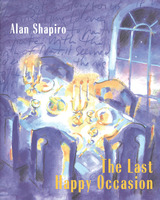 The Last Happy Occasion
Alan Shapiro
University of Chicago Press, 1996 The Last Happy Occasion is the coming-of-age story of an American Jew and aspiring writer in the sixties and seventies. In this memoir in six movements, Alan Shapiro recalls how poetry helped him make sense of his own and other people's lives. Events unfold, including his sister's death, that make him reconsider the transformative power of art and accept the limitations of poetry in confronting the untransformable pain of mortal loss.
A refreshingly honest, lovingly crafted work, The Last Happy Occasion is a treasure map for anyone interested in exploring the intersections of life and art.
Nominated for the 1996 National Book Critics Circle Award. "[Shapiro] seeks what lies at the deepest level of the human heart to mitigate his—and our—separateness from others."—Chase Collins, Chicago Tribune Books
"The Last Happy Occasion is touching and intelligent, emotionally satisfying and eloquent testimony to the power of poetry to instruct, heal and inspire."—Emily Barton, New York Times Book Review
"Shapiro, not unlike Auden, doses his wordplay with a certain sly irony. . . . We come away from Shapiro's book with an intimate appreciation of the little subversions that poetry can work in one's life."—Jonathan Kirsch, Los Angeles Times
"He is an acute observer of moments, people, art and language. And he packs even seemingly simple stories with many layers of meaning. . . . He shows us the power and importance of transformative art in life."—Publishers Weekly, starred review
"The literary criticism is sharp, but what enthralls the reader more is Shapiro's humorous but honest perspective on his younger self, a perspective that is critical without being condescending."—Heller McAlpin, Newsday
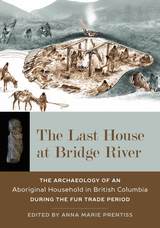 The Last House at Bridge River: The Archaeology of an Aboriginal Household in British Columbia during the Fur Trade Period
Anna M. Prentiss
University of Utah Press, 2017 The Last House at Bridge River offers a comprehensive archaeological study of a single-house floor and roof deposit dated to approximately 1835–1858 C.E. Although the Fur Trade period of the nineteenth century was a time of significant change for aboriginal peoples in the Pacific Northwest, it is a period that is poorly understood. These studies of Housepit 54 at the Bridge River site offer new insights, revealing that ancestors of today’s St’át’imc people were actively engaged in maintaining traditional lifestyles and making the best of new opportunities for trade and intergroup interaction.
Among its major contributions, the book includes a first-ever historical ecology of the Middle Fraser Canyon that places aboriginal and Euro-Canadian history in ecological context. It demonstrates that an integrated multidisciplinary approach to archaeological research can achieve insights well beyond what is known from the ethnographic and historical records. Because the project derives from a long-term partnership between the University of Montana and the Bridge River Indian Band, it illustrates the value of collaborations between archaeologists and First Nations. Together, contributors present a Fur Trade period aboriginal society at a level of intimacy unparalleled elsewhere.
 The Last House on the Block: Black Homeowners, White Homesteaders, and Failed Gentrification in Detroit
Sharon Cornelissen
University of Chicago Press, 2025 Gentrification is not inevitable, reveals Sharon Cornelissen, in this surprising, close look at the Detroit neighborhood of Brightmoor and the harsh reality of depopulation and urban decline.
In the minds of many, Detroit is undergoing a renaissance thanks to gentrifying urbanites who’ve been drawn to the city with the promise of cheap housing and thriving culture. But what happens when gentrification attempts to come to one of the most depopulated neighborhoods in the country—a place where every other property in the neighborhood was a vacant lot and every third house stood empty? To find out, Sharon Cornelissen moved to the Brightmoor neighborhood of Detroit for three years and became the owner of a $7,000 house.
The Last House on the Block takes us to Brightmoor to meet Cornelissen’s fellow residents. She introduces us to the long-time residents of the neighborhood who reveal their struggles to keep a home while keeping violence, tall grass, and yes—gentrification—at bay. We also meet the eclectic white newcomers of Brightmoor and learn about their real estate bargains, urban farms, and how they became the unlikely defenders of urban desolation. Where oldtimers take pride in neatly mowed lawns and hope for a return to residential density, newcomers love the open space and aim to buy more empty lots to raise chickens and goats. It is a story of gentrification, but not at all in the usual sense: it is a case of failed gentrification. We often think about gentrification as an unstoppable force—once the first white newcomers with yoga mats enter an often brown or Black community, the coffee shops and restaurants follow. But in Brightmoor, the dreams of white newcomers met the harsh reality of decade-long decline. Nearly a decade after Cornelissen’s fieldwork began, Brightmoor is even emptier than it was when she started.
Today, depopulation remains more common than gentrification in poor communities. Cornelissen’s story offers deep insights into what it is like to live in a declining neighborhood, and through the example of Brightmoor, Cornelissen reveals why depopulation continues and helps us imagine a more inclusive and equitable city turnaround.
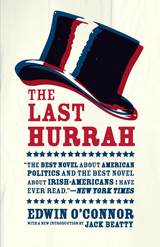 The Last Hurrah: A Novel
Edwin O'Connor
University of Chicago Press, 2016 “We’re living in a sensitive age, Cuke, and I’m not altogether sure you’re fully attuned to it.” So says Irish-American politician Frank Skeffington—a cynical, corrupt 1950s mayor, and also an old-school gentleman who looks after the constituents of his New England city and enjoys their unwavering loyalty in return. But in our age of dynasties, mercurial social sensitivities, and politicians making love to the camera, Skeffington might as well be talking to us.
Not quite a roman á clef of notorious Boston mayor James Michael Curley, The Last Hurrah tells the story of Skeffington’s final campaign as witnessed through the eyes of his nephew, who learns a great deal about politics as he follows his uncle to fundraisers, wakes, and into smoke-filled rooms, ultimately coming—almost against his will—to admire the man. Adapted into a 1958 film starring Spencer Tracy and directed by John Ford (and which Curley tried to keep from being made), Edwin O’Connor’s opus reveals politics as it really is, and big cities as they really were. An expansive, humorous novel offering deep insight into the Irish-American experience and the ever-changing nature of the political machine, The Last Hurrah reveals political truths still true today: what the cameras capture is just the smiling face of the sometimes sordid business of giving the people what they want.
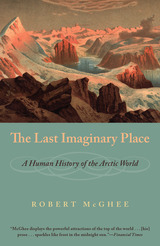 The Last Imaginary Place: A Human History of the Arctic World
Robert McGhee
University of Chicago Press, 2007 The Arctic of towering icebergs and midnight sun, of flaming auroras and endless winter nights, has long provoked flights of the imagination. Now, in The Last Imaginary Place, renowned archeologist Robert McGhee lifts the veil to reveal the true Arctic world. Based on thirty years of work with native peoples of the Arctic and travel in the region, McGhee’s account dispels notions of the frozen land as an exotic, remote world that exists apart from civilization.
Between the frigid reality and lurid fantasy lies McGhee’s true interest, the people who throughout human history have called the Arctic home. He paints a vivid portrait of Viking farmers, entrepreneurial Inuit, and Western explorers who have been seduced by the natural wealth and haunting beauty of this land. From lively accounts of fur trading, ivory hunting, and whaling to white-knuckle tales of the first, doomed expeditions, McGhee takes the reader on a whirlwind journey across this disorienting, dreamlike terrain that has fascinated mankind for centuries. “In prose infused by his position as curator of Arctic archaeology at the Canadian Museum of Civilization—which has taken him to sites in several countries—McGhee demolishes some persistent illusions about the white North . . . evocative.”—Times Literary Supplement “[A] compelling account . . . [McGhee] believes that the Arctic is not so much a region as a dream—what he sees as a dream of a unique, attractive world . . . An archaeologist who has spent thirty years there, the author lets his love for the region shine through on every page.—Booklist “McGhee displays the powerful attractions of the top of the world . . . [his] prose . . . sparkles like frost in the midnight sun.”—Financial Times “McGhee has written a sensitive, fascinating and extremely important book.”—Canadian Geographic
The Last Incantations: Poems
David Mura
Northwestern University Press, 2014 The personal, historical, and artistic are all in dialogue in David Mura’s daring collection, The Last Incantations. In a variety of poetic modes, Mura harmonizes and contrasts multiple voices to form a powerful meditation. Certain poems speak from his experiences as a third-generation Japanese American and his family’s struggles to prove their "Americanness." Others speak from the intersections of our multiracial society—an Asian teenager in love with a Somali Muslim girl, an apostrophe to Richard Pryor, poems about a Palestinian American friend, Abu Ghraib, the hapa sculptor Isamu Noguchi. The result is a sustained multifoliate poetry, bursting with elegance, heartache, and truth.
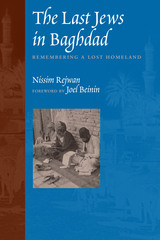 The Last Jews in Baghdad: Remembering a Lost Homeland
By Nissim Rejwan
University of Texas Press, 2004 Once upon a time, Baghdad was home to a flourishing Jewish community. More than a third of the city's people were Jews, and Jewish customs and holidays helped set the pattern of Baghdad's cultural and commercial life. On the city's streets and in the bazaars, Jews, Muslims, and Christians—all native-born Iraqis—intermingled, speaking virtually the same colloquial Arabic and sharing a common sense of national identity. And then, almost overnight it seemed, the state of Israel was born, and lines were drawn between Jews and Arabs. Over the next couple of years, nearly the entire Jewish population of Baghdad fled their Iraqi homeland, never to return. In this beautifully written memoir, Nissim Rejwan recalls the lost Jewish community of Baghdad, in which he was a child and young man from the 1920s through 1951. He paints a minutely detailed picture of growing up in a barely middle-class family, dealing with a motley assortment of neighbors and landlords, struggling through the local schools, and finally discovering the pleasures of self-education and sexual awakening. Rejwan intertwines his personal story with the story of the cultural renaissance that was flowering in Baghdad during the years of his young manhood, describing how his work as a bookshop manager and a staff writer for the Iraq Times brought him friendships with many of the country's leading intellectual and literary figures. He rounds off his story by remembering how the political and cultural upheavals that accompanied the founding of Israel, as well as broad hints sent back by the first arrivals in the new state, left him with a deep ambivalence as he bid a last farewell to a homeland that had become hostile to its native Jews.
The Last Journey of Ago Ymeri
Bashkim Shehu
Northwestern University Press, 2007 In a remote Albanian village, a place of banishment, a stranger appears, claiming to be Viktor Dragoti and looking for his long-lost love. That Viktor Dragoti has been dead for nine years, killed by the Albanian coast guard while trying to swim to freedom, only adds to the stranger's mystery--and to the suspense of this curiously real and yet otherworldly work by one of Albania's most distinguished writers. With echoes of The Return of Martin Guerre and Kafka's The Trial, with allusions to The Odyssey and the Albanian folktale of Ago Ymeri, a legendary hero released from the underworld for one day, Shehu's novel blends the autobiographical and the historical, the personal and the political into a powerful tale--a story that conveys the terrors, small and large, of a totalitarian state while capturing all that is surreal and even lyrical in life in such a deeply distorted world.
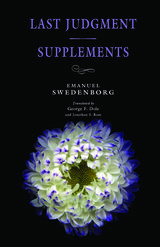 Last Judgment / Supplements
Emanuel Swedenborg
Swedenborg Foundation Publishers, 2018 One of the unique facets of Swedenborg’s theology is his assertion that the Last Judgment as foretold in the book of Revelation has already happened—that it took place in the spiritual world and would have lasting effects on earth.
This volume comprises two short works, originally published separately, which describe the Last Judgment as Swedenborg claims to have witnessed it over the course of many months in 1757. In Last Judgment, first published in 1758, Swedenborg lays out how and why the Last Judgment occurred, explaining that history can be divided into a series of spiritual ages or churches. At the end of each age, evil threatens to overwhelm both the physical and the spiritual worlds, and the Lord restores balance between good and evil with a “Last Judgment.” Thus the 1757 Last Judgment, Swedenborg says, applied only to the souls of people who had lived since the time of Christ, and the reformation of the spiritual world allowed humanity to enter the next age with a new understanding of religion. In the second half of Last Judgment, Swedenborg describes how various types of people were judged, a theme he continues in the 1763 short work Supplements.
The new spiritual age that Swedenborg saw emerging during his lifetime is one of the foundational themes in his theology (a theme he explores more deeply in his later work, Revelation Unveiled, which is a commentary on the book of Revelation). In Supplements, Swedenborg succinctly introduces his understanding of the connection between heaven and earth and of how that connection plays out over the course of human history.
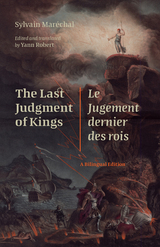 The Last Judgment of Kings / Le Jugement dernier des rois: A Bilingual Edition
Yann Robert
Bucknell University Press, 2025 First performed the day after Marie-Antoinette’s beheading, Le Jugement dernier des rois stages the burlesque trial of the remaining kings and queens of Europe—paraded in chains like animals, made to brawl over a barrel of crackers, and finally obliterated by a spectacular volcanic eruption. Such is the shocking context—at once tragic and farcical—of the most infamous play of the French Revolution, familiar to all specialists of the period. Until now, however, no standalone critical edition or English translation of this historic play existed. This bilingual edition revives Maréchal’s play and reveals its centrality to scholarly debates about Revolutionary notions of justice, religion, commemoration, comedy, and propaganda. Provocative, written in accessible prose, and short—perfect for students in a French or history seminar—Le Jugement dernier des rois offers an ideal introduction to the most important and contentious questions of the Revolutionary period.
Joué pour la première fois le lendemain de l’exécution de Marie-Antoinette, Le Jugement dernier des rois met en scène le procès burlesque des autres rois et reines d’Europe : exhibés et enchaînés tels des animaux, contraints de se battre pour un tonneau de biscuits, et finalement anéantis par l’éruption spectaculaire d’un volcan. Tel est le contexte scandaleux—tragédie et farce à la fois—de la pièce la plus célèbre de la Révolution française, bien connue de tous les spécialistes de cette période. Jusqu’à maintenant, pourtant, il n’existait ni édition critique ni traduction anglaise de cet ouvrage historique. Notre édition bilingue fait revivre la pièce de Maréchal et la replace au centre des plus grands débats chez les historiens de la Révolution, traitant de justice, religion, commémoration, comédie, et propagande. Provocateur, facile à lire, et concis—parfaitement adapté aux étudiants d’un cours de français ou d’histoire—Le Jugement dernier des rois propose ainsi une introduction idéale à la période révolutionnaire et à ses principales controverses.
Published by Bucknell University Press. Distributed worldwide by Rutgers University Press.
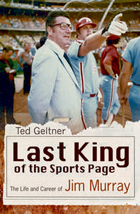 Last King of the Sports Page: The Life and Career of Jim Murray
Ted Geltner
University of Missouri Press, 2012 Part crusader, part comedian, Jim Murray was a once-in-a-generation literary talent who just happened to ply his trade on newsprint, right near the box scores and race results. During his lifetime, Murray rose through the ranks of journalism, from hard-bitten 1940s crime reporter, to national Hollywood correspondent, to the top sports columnist in the United States. In Last King of the Sports Page: The Life and Career of Jim Murray, Ted Geltner chronicles Jim Murray’s experiences with twentieth-century American sports, culture, and journalism. At the peak of his influence, Murray was published in more than 200 newspapers. From 1961 to 1998, Murray penned more than 10,000 columns from his home base at the Los Angeles Times. His offbeat humor and unique insight made his column a must-read for millions of sports fans. He was named Sportswriter of the Year an astounding fourteen times, and his legacy was cemented when he became one of only four writers to receive the prestigious Pulitzer Prize for coverage of sports. Geltner now gives readers a first look at Murray’s personal archives and dozens of fresh interviews with sports and journalism personalities, including Arnold Palmer, Mario Andretti, Kareem Abdul-Jabbar, Yogi Berra, Frank Deford, Rick Reilly, Dan Jenkins, Roy Firestone, and many more. Throughout his life, Murray chronicled seminal events and figures in American culture and history, and this biography details his encounters with major figures such as William Randolph Hearst, Henry Luce, Marilyn Monroe, Marlon Brando, John Wayne, Mickey Mantle, Muhammad Ali, and Tiger Woods. Charming and affecting moments in Murray’s career illustrate the sportswriter’s knack for being in on the big story. Richard Nixon, running for vice president on the Eisenhower ticket in 1952, revealed to Murray the contents of the “Checkers” speech so it could make the Time magazine press deadline. Media mogul Henry Luce handpicked Murray to lead a team that would develop Sports Illustrated for Time/Life in 1953, and when terrorists stormed the Olympic village at the 1972 Munich games, Murray was one of the first journalists to report from the scene. The words of sports journalist Roy Firestone emphasize the influence and importance of Jim Murray on journalism today: “I’ll say without question, I think Jim Murray was every bit as important of a sports writer—forget sport writer—every bit as important a writer to newspapers, as Mark Twain was to literature.” Readers will be entertained and awed by the stories, interviews, and papers of Jim Murray in Last King of the Sports Page.
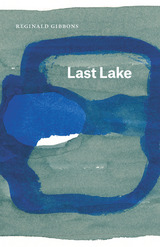 Last Lake
Reginald Gibbons
University of Chicago Press, 2016 From Ritual
A slow parade of old west enthusiasts,
camp song and hymn, came in along the winding
way where rural declined to suburban, slow
riders and wagoners passing a cow staked
to graze, some penned cattle looking vacantly
up—not in vacant lots the ancient icons
of wealth they had been in odes, prayers and epics,
in sacrifices and customs of bride-price
or dowry. (It’s good people no longer make
blood sacrifices, at gas stations and stores,
for example, and in the crunching gravel
parking lots of small churches—oh but we do.)
“The evening forgives the alleyway,” Reginald Gibbons writes in his tenth book of poems—but such startling simplicities are overwhelmed in us by the everyday and the epochal. Across the great range of Gibbons’s emblematic, vividly presented scenes, his language looks hard at and into experience and feeling. Words themselves have ideas, and have eyes—inwardly looking down through their own meanings, as the poet considers a lake in the Canadian north, a Chicago neighborhood, a horse caravan in Texas, a church choir, a bookshelf, or an archeological dig on the steppes near the Volga River. The last lake is the place of both awe and elegy.
 The Last Laugh: Folk Humor, Celebrity Culture, and Mass-Mediated Disasters in the Digital Age
Trevor J. Blank
University of Wisconsin Press, 2013 Widely publicized in mass media worldwide, high-profile tragedies and celebrity scandals—the untimely deaths of Michael Jackson and Princess Diana, the embarrassing affairs of Tiger Woods and President Clinton, the 9/11 attacks or the Challenger space shuttle explosion—often provoke nervous laughter and black humor. If in the past this snarky folklore may have been shared among friends and uttered behind closed doors, today the Internet's ubiquity and instant interactivity propels such humor across a much more extensive and digitally mediated discursive space. New media not only let more people "in on the joke," but they have also become the "go-to" formats for engaging in symbolic interaction, especially in times of anxiety or emotional suppression, by providing users an expansive forum for humorous, combative, or intellectual communication, including jokes that cross the line of propriety and good taste. Moving through engaging case studies of Internet-derived humor about momentous disasters in recent American popular culture and history, The Last Laugh chronicles how and why new media have become a predominant means of vernacular expression. Trevor J. Blank argues that computer-mediated communication has helped to compensate for users' sense of physical detachment in the "real" world, while generating newly meaningful and dynamic opportunities for the creation and dissemination of folklore. Drawing together recent developments in new media studies with the analytical tools of folklore studies, he makes a strong case for the significance to contemporary folklore of technologically driven trends in folk and mass culture.
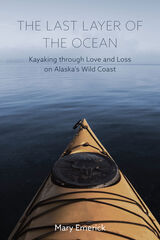 The Last Layer of the Ocean: Kayaking through Love and Loss on Alaska's Wild Coast
Mary Emerick
Oregon State University Press, 2021 There are five layers of the ocean, though most of us will only ever see one. The deepest layer is the midnight zone, where the only light comes from bioluminescence, created by animals who live there. In order to see, these creatures must create their own light. They move like solitary suns, encased in their own bubbles of freezing water. This is the most remote, unexplored zone on the planet. Though hostile to humans, it’s a source of rapt fascination for Mary Emerick, who would go there in a heartbeat if she could.
The year Emerick turned 38, the suicide of a stranger compelled her to uproot her life and strike out for Alaska, taking a chance on love and home. She learned how to travel in a small yellow kayak along the rugged coast, contending with gales, high seas, and bears. She pondered the different meanings of home from the perspectives of people who were born along Alaska’s coast, the first peoples who had been there for generations, newcomers who chose this place for themselves, and the many who would eventually, inevitably leave. When she married a man from another island, convinced that love would stick, she soon learned that marriage is just as difficult to navigate as the ocean.
Divided into sections detailing the main kayaking strokes, with each stroke serving as metaphor for the lives we all pass through and the tools needed to stay afloat, this eloquent memoir speaks to the human need for connection—connection to place and to our fellow travelers casting their bubbles of light in the depths.
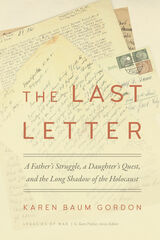 The Last Letter: A Father's Struggle, a Daughter's Quest, and the Long Shadow of the Holocaust
Karen Baum Gordon
University of Tennessee Press, 2021 A Good Morning America Pick of the Week!
Born a German Jew in 1915, Rudy Baum was eighty-six years old when he sealed the garage door of his Dallas home, turned on the car ignition, and tried to end his life. After confronting her father’s attempted suicide, Karen Baum Gordon, Rudy’s daughter, began a sincere effort to understand the sequence of events that led her father to that dreadful day in 2002. What she found were hidden scars of generational struggles reaching back to the camps and ghettos of the Third Reich. In The Last Letter: A Father’s Struggle, a Daughter’s Quest, and the Long Shadow of the Holocaust, Gordon explores not only her father’s life story, but also the stories and events that shaped the lives of her grandparents—two Holocaust victims that Rudy tried in vain to save in the late 1930s and early years of World War II. This investigation of her family’s history is grounded in eighty-eight letters written mostly by Julie Baum, Rudy’s mother and Karen’s grandmother, to Rudy between November 1936 and October 1941. In five parts, Gordon examines pieces of these well-worn, handwritten letters and other archival documents in order to discover what her family experienced during the Nazi period and the psychological impact that reverberated from it in the generations that followed. Part of the Legacies of War series, The Last Letter is a captivating family memoir that spans events from the 1930s and Hitler’s rise to power, through World War II and the Holocaust, to the present-day United States. In recreating the fatal journeys of her grandparents and tracing her father’s efforts to save them an ocean away in America, Gordon discovers the forgotten fragments of her family’s history and a vivid sense of her own Jewish identity. By inviting readers along on this journey, Gordon manages to honor victim and survivor alike and shows subsequent generations—now many years after the tragic events of World War II—what it means to remember.
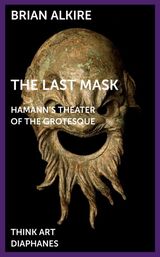 The Last Mask: Hamann's Theater of the Grotesque
Brian Alkire
Diaphanes, 2021 Johann Georg Hamann (1730–88) remains one of the most influential and yet least understood figures in the history of German thought and literature. Throughout his life, he had major influence on figures as diverse as Goethe, Schiller, Kant, Hegel, Hölderlin, Kierkegaard, and a host of others. Hamann is also one of the most difficult-to-read authors in the German language, writing in an ultracondensed, hyperallusive language for which he became infamous—and which his detractors constantly used to dismiss him. Today, Hamann has been picked up by literary theorists as a precursor of the linguistic turn.
The Last Mask focuses on Hamann’s final work, Entkleidung und Verklärung (1786), which was consciously conceived of as an “Abschluss” of his “kleine Autorschaft” and a final defense against his critics. Equally philological and theoretical, it identifies a number of previously unnoticed manuscript alterations that help answer some long-standing questions in Hamann scholarship as well as open new doors for inquiry.
Importantly, the manuscripts show that Hamann is one of the earliest theorists of the virtual in our sense of the word today, using the word “virtualiter” to describe his own theory. He links this theory with the concept of the mask or disguise, and conceives of texts as fabrics or textiles composed of threads and strings. The philological focus is on Hamann’s understanding of intertextuality, and on the basis of his dominant string images his notion of virtuality is brought into conversation with Deleuze’s idea of a plane of immanence through the image of a skein of immanence, a knotted bundle of thread which solidifies into a three-dimensional virtual space—a new perspective in contemporary discussions surrounding the nature of virtuality.
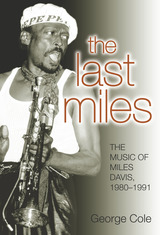 The Last Miles: The Music of Miles Davis, 1980-1991
George Cole
University of Michigan Press, 2007
“Cole does for Miles’s late work what Ian MacDonald’s Revolution in the Head does for the Beatles, examining each album in meticulous detail.”
—Time Out
“As with any good musical biography, Cole . . . made me think again about those albums such as Siesta, You’re Under Arrest, and The Man with the Horn that are now stashed in my attic.”
—London Times
“In the flurry of books since [Miles Davis’s] death, none has dealt in depth with the music of this period. Music writer George Cole fills this gap. . . . a rich and rewarding read.”
—Gazette (Montreal)
“A fascinating book.”
—Mojo
“A singular look into the last stage of Davis’s long, somewhat checkered career gained from various sources, which at the same time gives a picture of the modern music business.”
—Midwest Book Review
“There are large chunks of fresh material here. . . . Fill[s] in quite a few gaps and dismisses blanket condemnations of [Miles’s] pop phase.”
—Jazzwise
“Thank you for telling it like it was!”
—Randy Hall, singer and guitarist
“Very moving, emotional material.”
—Gordon Meltzer, Miles’s last road manager and executive producer of Doo-Bop
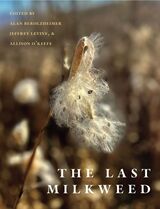 The Last Milkweed
Edited by Jeffrey Levine, Alan Berholzheimer, and Allison O'Keefe
Tupelo Press, 2025 Autumn is the inspiration behind this anthology, but not necessarily the destination. The destination is the discovery of the human condition, the discovery of the ways in which we respond to the natural world.
In this extraordinary anthology, forty-seven contemporary poets and one photographer respond to the myriad ways in which what we think and feel about the “autumnal” resonates through our lives and senses: spiritually, physically, and philosophically. Contributing poets were asked “to let their language rub up against any part or parts of the autumnal world that calls to them, whether from the outside in or the inside out.” In other words, these autumn poems and photographs need not so much as mention fallen leaves, milkweed, or even “autumn.” Autumn is the inspiration, but not necessarily the destination. The destination is as ever, the discovery of the human condition, the discovery of the ways in which we respond to the natural world.
The poems included in this anthology have all been written fresh in response to the autumnal prompt, with new work from luminaries such as Elise Paschen, Martha Ronk, G.C. Waldrep, Michael Chitwood, Gillian Cummings, Gibson Fay-LeBlanc, Rick Hilles, Eva Hooker, Luisa A. Igloria, and William Orem.
The photographs are by Jeffrey Levine, who, in addition to being executive director of Tupelo Press, is widely recognized for his work behind the camera. These images boast exceptional composition and color, but beyond technique, each photo offers up a penetrating resonance on the theme of autumn and the autumnal.
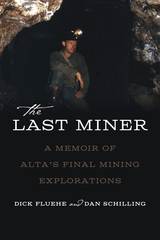 The Last Miner: A Memoir of Alta's Final Mining Expeditions
Dick Fluehe with Dan Schilling
University of Utah Press, 2025 Explore Utah’s legendary lost and hidden silver mines with the last miner
The Last Miner is a captivating memoir chronicling the final days of mining exploration in Utah’s legendary Little Cottonwood Canyon during the 1950s. Through the eyes of Dick Fluehe, the last living miner to traverse these haunted, silver-laden tunnels, readers are immersed in a forgotten world beneath the internationally renowned Alta and Snowbird ski areas. With a knowledge as deep as the mines themselves, Dick recounts tales of collapsed shafts, gloriously jeweled stopes, and colorful personalities, such as “Swingin’ Door,” “Slick,” and “The Bull,” who lived and died pursuing ore.
Edited by New York Times bestselling author Dan Schilling, The Last Miner offers a unique, firsthand account of the treacherous, adventurous, and humorous lives of mid-century miners. Both thrilling and insightful, this memoir is the mining equivalent of a float down the Mississippi with Mark Twain and an unprecedented insight into the history of American West mining.
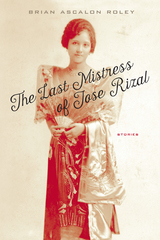 The Last Mistress of Jose Rizal: Stories
Brian Ascalon Roley
Northwestern University Press, 2016 The Last Mistress of Jose Rizal is a collection of stories that focuses on multigenerational tales of intertwined Filipino families. Set in the huge yet relatively overlooked and misunderstood Filipino diaspora in the United States, this book follows characters who live in the shadow of the histories of the United States and its former colony in Asia, the Philippines. The impact of immigration and separation filters through the stories as a way of communing with or creating distance between individuals and family, country, or history. Roley’s work has been praised by everyone from New York Times literary critics to APIA author Helen Zia for his bare, poetic style and raw emotionalism. In the collection’s title story, a woman living with her daughter and her daughter’s American husband fears the loss of Filipino tradition, especially Catholicism, as she tries to secretly permeate her granddaughter’s existence with elements of her ancestry. In "New Relations," an American-born son introduces his mother to his Caucasian bride and her family, only to experience his first marital discord around issues of politesse, the perception of culture, and post-colonial legacies. Roley’s delicately nuanced collection often leaves the audience with the awkwardness that comes from things lost in translation or entangled in generational divides.
 The Last Mixtape: Physical Media and Nostalgic Cycles
Seth Long
University of Chicago Press, 2025 A reflection on the evolution of physical media into metaphor, through the history of music curation.
Obsolescence makes the heart grow fonder, at least in the case of the mixtape. Not all technologies are so lucky. Some (say, wax cylinders) fade almost completely from cultural memory. A lucky few pass into metaphor: we still “hang up” our smartphones, “cut” film, and “patch” computer code. As digital streaming completes the obsolescence of physical media, what will become of the humble cassette?
In The Last Mixtape, Seth Long offers a microhistory of music curation, anchored by the cassette, from which he explores the meanings of obsolescence, ownership, nostalgia, and the speed of cultural change. A moving meditation on our relationship with music, memory, and curation in the digital century, Long ultimately calls for a return to the media ecology represented by the mixtape: a world in which media is cheap and abundant but tactile and meaningfully engaged.
Last Mountain Dancer: Hard-Earned Lessons in Love, Loss, and Honky-Tonk Outlaw Life
Chuck Kinder
West Virginia University Press, 2018 This gonzo-style metamemoir follows Chuck Kinder on a wild tour of the back roads of his home state of West Virginia, where he encounters Mountain State legends like Sid Hatfield, Dagmar, Robert C. Byrd, the Mothman, Chuck Yeager, Soupy Sales, Don Knotts, and Jesco White, the “Dancing Outlaw.”
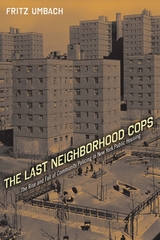 The Last Neighborhood Cops: The Rise and Fall of Community Policing in New York Public Housing
Umbach, Fritz
Rutgers University Press, 2011 In recent years, community policing has transformed American law enforcement by promising to build trust between citizens and officers. Today, three-quarters of American police departments claim to embrace the strategy. But decades before the phrase was coined, the New York City Housing Authority Police Department (HAPD) had pioneered community-based crime-fighting strategies.
The Last Neighborhood Cops reveals the forgotten history of the residents and cops who forged community policing in the public housing complexes of New York City during the second half of the twentieth century. Through a combination of poignant storytelling and historical analysis, Fritz Umbach draws on buried and confidential police records and voices of retired officers and older residents to help explore the rise and fall of the HAPD's community-based strategy, while questioning its tactical effectiveness. The result is a unique perspective on contemporary debates of community policing and historical developments chronicling the influence of poor and working-class populations on public policy making.
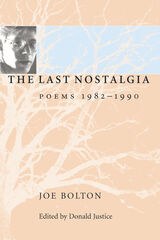 The Last Nostalgia: Poems, 1982–1990
Joe Bolton
University of Arkansas Press, 1999 Joe Bolton studied universal connections—the tension between the transitory beauty of the physical world and a yearning for the eternal. He turned his eye to the world, to the cultures and the people around him, and saw reflections of himself. In this collection, he works in both free verse and traditional forms, rendering scenes of exquisite detail that pry into the hearts of his characters and reveal the contradictions that bind father to son, lover to lover, and person to person. From the broken hills and drowsy river valleys around Paducah, Kentucky, to Houston diners and Gulf Coast shrimp boats, to the tropical cityscape of Miami, Bolton creates vivid scenes in which his characters confront the loneliness and the "little music" of their lives. With a richly musical voice and an ear for the cadences of everyday speech, Bolton gives his readers not the trappings of love and grief, but the very things themselves, rendered in lines that reverberate with the authority of sincerity and truth.
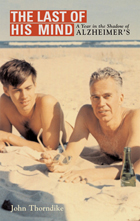 The Last of His Mind: A Year in the Shadow of Alzheimer’s
John Thorndike
Ohio University Press, 2011 NEW EDITIONS AVAILABLE: Paperback ISBN 978–0804012362 / Electronic ISBN 978–0804041201 Joe Thorndike was managing editor of Life at the height of its popularity immediately following World War II. He was the founder of American Heritage and Horizon magazines, the author of three books, and the editor of a dozen more. But at age 92, in the space of six months he stopped reading or writing or carrying on detailed conversations. He could no longer tell time or make a phone call. He was convinced that the governor of Massachusetts had come to visit and was in the refrigerator. Five million Americans suffer from Alzheimer’s, and like many of them, Joe Thorndike’s one great desire was to remain in his own house. To honor his wish, his son John left his own home and moved into his father’s upstairs bedroom on Cape Cod. For a year, in a house filled with file cabinets, photos, and letters, John explored his father’s mind, his parents’ divorce, and his mother’s secrets. The Last of His Mind is the bittersweet account of a son’s final year with his father, and a candid portrait of an implacable disease. It’s the ordeal of Alzheimer’s that draws father and son close, closer than they have been since John was a boy. At the end, when Joe’s heart stops beating, John’s hand is on his chest, and a story of painful decline has become a portrait of deep family ties, caregiving, and love.
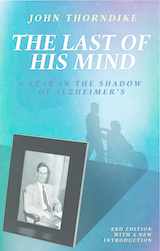 The Last of His Mind, Second Edition: A Year in the Shadow of Alzheimer’s
John Thorndike
Ohio University Press, 2021 The second, expanded edition of this acclaimed memoir by an Alzheimer’s caregiver living with his father during his final year includes a new introduction that illustrates the immense toll of the disease, important lessons from the author’s experience, and a readers' guide. Joe Thorndike was managing editor of Life at the height of its popularity immediately following World War II. He was the founder of American Heritage and Horizon magazines, the author of three books, and the editor of a dozen more. But at age ninety-two, in the space of six months he stopped reading or writing or carrying on detailed conversations. He could no longer tell time or make a phone call. He was convinced that the governor of Massachusetts had come to visit and was in the refrigerator. Over six million Americans suffer from Alzheimer’s, and like many of them, Joe Thorndike’s one great desire was to remain in his own house. To honor his wish, his son John left his own home and moved into his father’s upstairs bedroom on Cape Cod. For a year, in a house filled with file cabinets, photos, and letters, John explored his father’s mind, his parents’ divorce, and his mother’s secrets. The Last of His Mind is the bittersweet account of a son’s final year with his father and a candid portrait of an implacable disease. It’s the ordeal of Alzheimer’s that draws father and son close, closer than they have been since John was a boy. At the end, when Joe’s heart stops beating, John’s hand is on his chest, and a story of painful decline has become a portrait of deep family ties, caregiving, and love.
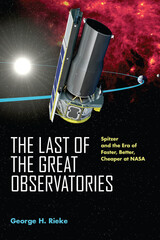 The Last of the Great Observatories: Spitzer and the Era of Faster, Better, Cheaper at NASA
George H. Rieke
University of Arizona Press, 2006 The Spitzer Space Observatory, originally known as the Space Infrared Telescope Facility (SIRTF), is the last of the four “Great Observatories”, which also include the Hubble Space Telescope, the Chandra X-ray Observatory, and the Compton Gamma Ray Observatory. Developed over twenty years and dubbed the “Infrared Hubble", Spitzer was launched in the summer of 2003 and has since contributed significantly to our understanding of the universe.
George Rieke played a key role in Spitzer and now relates the story of how that observatory was built and launched into space. Telling the story of this single mission within the context of NASA space science over two turbulent decades, he describes how, after a tortuous political trail to approval, Spitzer was started at the peak of NASA’s experiment with streamlining and downsizing its mission development process, termed “faster better cheaper.” Up to its official start and even afterward, Spitzer was significant not merely in terms of its scientific value but because it stood at the center of major changes in space science policy and politics. Through interviews with many of the project participants, Rieke reconstructs the political and managerial process by which space missions are conceived, approved, and developed. He reveals that by the time Spitzer had been completed, a number of mission failures had undermined faith in “faster-better-cheaper” and a more conservative approach was imposed. Rieke examines in detail the premises behind “faster better cheaper,” their strengths and weaknesses, and their ultimate impact within the context of NASA’s continuing search for the best way to build future missions.
Rieke’s participant’s perspective takes readers inside Congress and NASA to trace the progress of missions prior to the excitement of the launch, revealing the enormously complex and often disheartening political process that needs to be negotiated. He also shares some of the new observations and discoveries made by Spitzer in just its first year of operation. As the only book devoted to the Spitzer mission, The Last of the Great Observatories is a story at the nexus of politics and science, shedding new light on both spheres as it contemplates the future of mankind’s exploration of the universe.
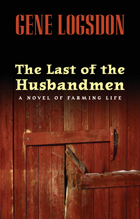 The Last of the Husbandmen: A Novel of Farming Life
Gene Logsdon
Ohio University Press, 2008 “Nan turned to see Ben’s face turn as hard and white as a sauerkraut crock. When he did not respond, Nan figured that he was just going to back off as he usually did, the shy and retiring husbandman. She did not know her history. She did not know that shy and retiring husbandmen have been known to revolt against oppression with pitchforks drawn.”
—The Last of the Husbandmen
In The Last of the Husbandmen, Gene Logsdon looks to his own roots in Ohio farming life to depict the personal triumphs and tragedies, clashes and compromises, and abiding human character of American farming families and communities. From the Great Depression, when farmers tilled the fields with plow horses, to the corporate farms and government subsidy programs of the present, this novel presents the complex transformation of a livelihood and of a way of life.
Two friends, one rich by local standards, and the other of more modest means, grow to manhood in a lifelong contest of will and character. In response to many of the same circumstances—war, love, moonshining, the Klan, weather, the economy—their different approaches and solutions to dealing with their situations put them at odds with each other, but we are left with a deeper understanding of the world that they have inherited and have chosen.
Part morality play and part personal recollection, The Last of the Husbandmen is both a lighthearted look at the past and a profound statement about the present state of farming life. It is also a novel that captures the spirit of those who have chosen to work the land they love.
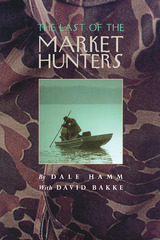 The Last of the Market Hunters
Dale Hamm with David Bakke
Southern Illinois University Press, 1996 Duck hunting has changed greatly since the days of unlimited duck kills, as the limit of fifty ducks a day established in 1902 has fallen to the present three. A legitimate hunter now, Dale Hamm learned the art of market hunting—taking waterfowl out of season and selling them to restaurants—from his father during the l920s. During the l930s and l940s, he kept his family alive by market hunting. At the peak of his career, Hamm poached every private hunting club along the Illinois River from Havana to Beardstown. After market hunting died out, Hamm became a legendary and almost respected—albeit controversial—character on the Illinois backwaters. He was eventually invited to hunt on the same clubs from which he had once been chased at the point of a shotgun. He hunted with judges, sheriffs, and the head of undercover operations for the Illinois Department of Conservation, all of whom knew of his reputation. He passed on to these hunting partners a lifetime of outdoor knowledge gained from slogging through mud, falling through ice, hunting ducks at three o’clock in the morning, dodging game wardens, and running the world’s only floating tavern. "I always said if anyone ever cut open one of us Hamms, all they’d find was duck or fish," Hamm once said of his family. Now in his eighties, Hamm still carries a pellet from a shotgun in his chin to remind him of a shotgun blast that ricocheted off the water and into his face. Bakke notes that it is appropriate that a man who spent his life with a shotgun in his hands should carry a bit of buckshot wherever he goes. Everyone who ever met Dale Hamm has a story about him. His own story is that of a one-of-a-kind character who, in his later years, used his considerable outdoor savvy to conserve the natural resources he once savaged. "His time and kind are gone," Bakke notes, "and there will never be another like him." This book will be of interest to anyone who has ever been hunting—or who enjoys reading about colorful people and times that exist no more.
The Last of the Mohicans
James Fenimore Cooper
Harvard University Press, 2011 Set in 1757 during the French and Indian War, as Britain and France fought for control of North America, The Last of the Mohicans is a historical novel and a rousing adventure story. It is also, Wayne Franklin argues in his introduction, a probing examination of the political and cultural contest taking shape more than half a century later in the author’s own day as European settlement continued to relentlessly push Native Americans westward. The John Harvard Library edition reproduces the authoritative text of the novel from The Writings of James Fenimore Cooper, published by the State University of New York Press.
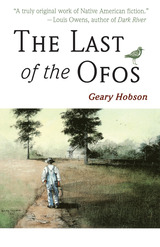 The Last of the Ofos
Geary Hobson
University of Arizona Press, 2000 Thomas Darko is a Mohican for the twentieth century, the last surviving member of the tiny Mosopelea Tribe of the Mississippi Delta, called Ofos by outsiders. Never numbering more than a few hundred people in recorded history, his kinsmen have died away until Thomas comes to think of himself as "a nation of one." Now an old man in the waning years of the century, Thomas tells the story of his rough-and-tumble life--one which saw many of the changes that Indian people have faced in modern America—and he emerges as one of the most endearing characters in contemporary Native American literature.
In this subtle but inventive novel, presented as Thomas's memoirs, Geary Hobson offers us a glimpse into a life filled with simple joys and sorrows. In relating his Louisiana childhood, Thomas recalls not just school-learning but being taught Indian ways by the small Ofo community. He tells of his life as a roustabout in the oil fields, of his courtship of the rambunctious Sally Fachette, and of his career as a bootlegger, which landed him in prison. We share Thomas's wartime stint with the Marines—where "for the first time in my life I was treated like a equal"—and his life as a farm laborer and a Hollywood extra portraying warbonneted Cheyennes. Then in his later years, when he truly has become the last of his kind, we find Thomas recruited by an anthropologist from the Smithsonian Institution to preserve his people's culture. In Washington, he is exposed to the vagaries of Indian policy and the emerging Native American movement.
Throughout Thomas's story, readers are introduced to a wide-ranging cast of characters, from the outlaws Bonnie and Clyde to a fellow Marine who is wary of Indians, to an uppity anthropologist who doesn't consider Thomas "expert" enough to handle an Ofo flute. Always poor in material wealth but rich in heritage, Thomas Darko is a Native American Everyman whose identity is shaped by family and homeland. His "autobiography" paints a realistic portrait of an Indian confronting the obstacles in his life and the dilemmas of his age as his story reveals the painful legacy of being the last of one's kind.
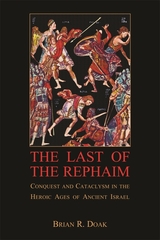 The Last of the Rephaim: Conquest and Cataclysm in the Heroic Ages of Ancient Israel
Brian R. Doak
Harvard University Press The figure of the giant has haunted the literatures of the ancient Mediterranean world, from the Greek Gigantomachy and other Aegean epic literatures to the biblical contexts of the ancient Near East. In The Last of the Rephaim, Brian Doak argues that the giants of the Hebrew Bible are a politically, theologically, and historiographically generative group, and through their oversized bodies, readers gain insight into central aspects of Israel’s symbolic universe. All that is overgrown or physically monstrous represents a connection to primeval chaos, and stands as a barrier to creation and right rule. Giants thus represent chaos-fear, and their eradication is a form of chaos maintenance by both human and divine agents. Doak argues that these biblical traditions participate in a broader Mediterranean conversation regarding giants and the end of the heroic age—a conversation that inevitably draws the biblical corpus into a discussion of the function of myth and epic in the ancient world, with profound implications for the politics of monotheism and monarchy in ancient Israel.
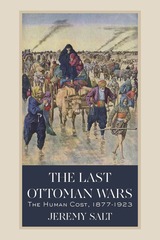 The Last Ottoman Wars: The Human Cost, 1877–1923
Jeremy Salt
University of Utah Press, 2019 During the last half century of its existence, the Ottoman Empire and the lands around its borders were places of constant political turmoil and unceasing military action. The enormous costs of war were paid not only by politicians and soldiers, but by the Ottoman civilian population as well. This book examines the hardships that ordinary people, Muslim and Christian alike, endured during decades of warfare.
Jeremy Salt brings to the surface previously ignored facts that disrupt the conventional narrative of an ethno-religious division between Muslim perpetrators and Christian victims of violence. Salt shows instead that all major ethno-religious groups—including Armenians, Turks, Kurds, and Greeks—were guilty of violent acts. The result is a more balanced picture of European involvement in the Ottoman Empire and the Balkans, one that highlights the destructive role of British Prime Minister David Lloyd George and other European leaders grabbing for Ottoman resources up to the end of World War I. The effects of these events are felt to the present day.
This extraordinary story centers not on military campaigns but on ordinary civilians whose lives were disrupted and in many cases destroyed by events over which they had no control. Disease, malnutrition, massacre and inter-communal fighting killed millions of people during the First World War alone. Until now this epic saga of human suffering has remained a story largely untold.
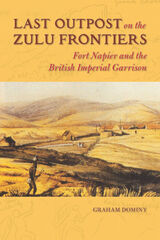 Last Outpost on the Zulu Frontiers: Fort Napier and the British Imperial Garrison
Graham Dominy
University of Illinois Press, 2016 Small and isolated in the Colony of Natal, Fort Napier was long treated like a temporary outpost of the expanding British Empire. Yet British troops manned this South African garrison for over seventy years. Tasked with protecting colonists, the fort became even more significant as an influence on, and reference point for, settler society. Graham Dominy's Last Outpost on the Zulu Frontier reveals the unexamined but pivotal role of Fort Napier in the peacetime public dramas of the colony. Its triumphalist colonial-themed pageantry belied colonists's worries about their own vulnerability. As Dominy shows, the cultural, political, and economic methods used by the garrison compensated for this perceived weakness. Settler elites married their daughters to soldiers to create and preserve an English-speaking oligarchy. At the same time, garrison troops formed the backbone of a consumer market that allowed colonists to form banking and property interests that consolidated their control.
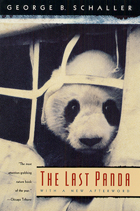 The Last Panda
George B. Schaller
University of Chicago Press, 1993 Dependent on a shrinking supply of bamboo, hunted mercilessly for its pelt, and hostage to profiteering schemes once in captivity, the panda is on the brink of extinction. Here, acclaimed naturalist George Schaller uses his great evocative powers, and the insight gained by four and a half years in the forests of the Wolong and Tangjiahe panda reserves, to document the plight of these mysterious creatures and to awaken the human compassion urgently needed to save them.
"No scientist is better at letting the rest of us in on just how the natural world works; no poet sees the world with greater clarity or writes about it with more grace. . . . Anyone who genuinely cares for wildlife cannot help being grateful to Schaller—both for his efforts to understand the panda and for the candor with which he reports what has gone so badly wrong in the struggle to save it from extinction."—Geoffrey C. Ward, New York Times Book Review
"Schaller's book is a unique mix of natural history and the politics of conservation, and it makes for compelling reading. . . . Having been in giant panda country myself, I found some of the descriptions of the animals and habitats breathtaking. Schaller describes the daily routines and personalities of the giant pandas he studied (as well as their fates thereafter) as though they were his blood relatives. . . . Schaller's brilliant presentation of the complexities of conservation makes his book a milestone for the conservation movement."—Devra G. Kleiman, Washington Post Book World
"George Schaller's most soulful work, written in journal style with many asides about a creature who evolved only two to three million years ago (about the same time as humans). . . . Here, conservation biology confronts an evil that grinds against hope and shatters the planet's diversity. Written with hope."—Whole Earth Catalog
"A nicely crafted blend of wildlife observation and political-cultural analysis. . . . The Last Panda is a sad chronicle of our failure, so far, to stem the decline of the animal that may be the most beloved on the planet."—Donald Dale Jackson, Smithsonian
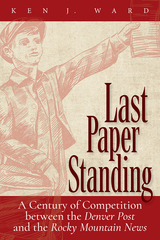 Last Paper Standing: A Century of Competition between the Denver Post and the Rocky Mountain News
Ken J. Ward
University Press of Colorado, 2023 Last Paper Standing chronicles the history of competition between the Denver Post and Rocky Mountain News—from both newspapers’ origins to their joint operating agreement in 2001 to the death of the News in 2009—to tell a broader story about the decline of newspaper readership in the United States. The papers fought for dominance in the lucrative Denver newspaper market for more than a century, enduring vigorous competition in pursuit of monopoly control.
This frequently sensational, sometimes outlandish, and occasionally bloody battle spanned numerous eras of journalism, embodying the rise and fall of the newspaper industry during the twentieth century in the lead up to the fall of American newspapering. Drawing on manuscript collections scattered across the United States as well as oral histories with executives, managers, and journalists from the papers, Ken J. Ward investigates the strategies employed in their competition with one another and against other challenges, such as widespread economic uncertainty and the deterioration of the newspaper industry. He follows this competition through the death of the Rocky Mountain News in 2009, which ended the country’s last great newspaper war and marked the close of the golden age of Denver journalism.
Fake news runs rampant in the absence of high-quality news sources like the News and the Post of the past. Neither canonizing nor vilifying key characters, Last Paper Standing offers insight into the historical context that led these papers’ managers to their changing strategies over time. It is of interest to media and business historians, as well as anyone interested in the general history of journalism, Denver, and Colorado.
The Last Person to Hear Your Voice
Richard Shelton
University of Pittsburgh Press, 2007 While Shelton has been known primarily for his poems dealing with the landscape of the Southwest and the destruction of that landscape, the poems in this book are much more far-ranging, including many poems dealing with soocial issues (the issue of illegal immigration on our southern border, homelessness), historical events (the war in Iraq, the events of 9/11) and attitudes concerning politics and the environment. The poems are filled with sensory images, engaged in the real world, often ironic or simply off-the-wall, and their tone ranges from deeply sad, as in a requiem for Glen Canyon on the Colorado River, to the wildly funny, as in Brief Communications from My widowed Mother.
The Last Pescadores of Chimalhuacán, Mexico: An Archaeological Ethnography
Jeffrey R. Parsons
University of Michigan Press, 2006 Based on his study of the nearly vanished aquatic economy of Chimalhuacán in the Valley of Mexico, Parsons describes the surviving vestiges of aquatic insect collection and fishing and considers their developmental and archaeological implications within a broad context of historical, ethnographic, biological, ecological, and archaeological information from Mexico, North and South America, the Near East, and Africa. Activities, implements, artifacts, and landscapes are richly illustrated, in many cases with the author’s own photos and a number of vintage photographs. The study concludes that aquatic resources were fully complementary with agricultural products during prehispanic times in Mesoamerica where a pastoral economy was absent.
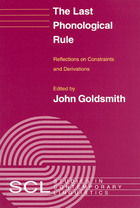 The Last Phonological Rule: Reflections on Constraints and Derivations
Edited by John A. Goldsmith
University of Chicago Press, 1993 Over the past three decades, phonological theory has advanced in many areas, but it has changed little in its foundational assumptions about how computational processes can serve as a basis for the theory. This volume suggests that it may be worthwhile to reconsider some of those assumptions. Is there an order to the rules in a phonological derivation? What kinds of links other than derivations are possible between the level of mental representation and the level of speech sounds? Since phonological representations are so much more sophisticated today than they were a few decads ago, do we need any phonological rules at all?
In this provocative book, leading linguists and computer scientists consider the challenges that computational innovations pose to current rule-based phonological theories and speculate about the advantages of phonological models based on artificial neural networks and other computer designs. The authors offer new conceptions of phonological theory for the 1990s, the most radical of which proposes that phonological processes cannot be characterized by rules at all, but arise from the dynamics of a system of phonological representations in a high-dimensional vector space of the sort that a neural network embodies. This new view of phonology is becoming increasingly attractive to linguists and others in the cognitive sciences because it answers some difficult questions about learning while drawing on recent results in philosophy, psychology, artificial intelligence, and neuroscience.
The contributors are John A. Goldsmith, Larry M. Hyman, George Lakoff, K. P. Mohanan, David S. Touretzky, and Deirdre W. Wheeler.
 The Last Physician: Walker Percy and the Moral Life of Medicine
Carl Elliott and John Lantos, eds.
Duke University Press, 1999 Walker Percy brought to his novels the perspective of both a doctor and a patient. Trained as a doctor at Columbia University, he contracted tuberculosis during his internship as a pathologist at Bellevue Hospital and spent the next three years recovering, primarily in TB sanitoriums. This collection of essays explores not only Percy’s connections to medicine but also the underappreciated impact his art has had—and can have—on medicine itself. The contributors—physicians, philosophers, and literary critics—examine the relevance of Percy’s work to current dilemmas in medical education and health policy. They reflect upon the role doctors and patients play in his novels, his family legacy of depression, how his medical background influenced his writing style, and his philosophy of psychiatry. They contemplate the private ways in which Percy’s work affected their own lives and analyze the author’s tendency to contrast the medical-scientific worldview with a more spiritual one. Assessing Percy’s stature as an author and elucidating the many ways that reading and writing can combine with diagnosing and treating to offer an antidote to despair, they ask what it means to be a doctor, a writer, and a seeker of cures and truths—not just for the body but for the malaise and diseased spirituality of modern times. This collection will appeal to lovers of literature as well as medical professionals—indeed, anyone concerned with medical ethics and the human side of doctoring.
Contributors. Robert Coles, Brock Eide, Carl Elliott, John D. Lantos, Ross McElwee, Richard Martinez, Martha Montello, David Schiedermayer, Jay Tolson, Bertram Wyatt-Brown, Laurie Zoloth-Dorfman
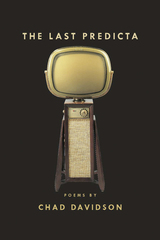 The Last Predicta
Chad Davidson
Southern Illinois University Press, 2008 The Last Predicta is Chad Davidson's searing collection of poetry dedicated to endings of all varieties. From odes to the corporate cornucopia of Target and the aggressive cheer of a Carnival cruise, to emotive examinations of Caravaggio's The Calling of St. Matthew or flies circling a putrescent bowl of forgotten fruit, Davidson weaves a lyrical web of apocalyptic scenarios and snapshots of pop culture. Throughout the volume appear cataclysms large and small, whether the finality of a minute passed or the deaths of a thousand swans at Seneca Lake in 1912. Images of King Kong, Starburst candies, and the Brady Bunch swim with mythological figures, Roman heroes, and dead animals as Davidson deftly explores the relationship between the mundane and the profound. At the center of the collection sits the Predicta television itself, "the lives blooming there in Technicolor," at once futuristic and nostalgic in its space age prophecy. Moving in their very simplicity, these poems resonate with discoveries that belie their seemingly ordinary wellsprings. Chad Davidson's stunning collection repeatedly explores the moment of revelation and all its accompanying aftermaths. The Last Predicta leads readers to ponder all manner of predictions, endings, and everything that follows.
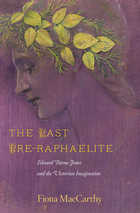 The Last Pre-Raphaelite: Edward Burne-Jones and the Victorian Imagination
Fiona MacCarthy
Harvard University Press, 2012 While still a student at Oxford, Edward Burne-Jones formed a friendship and made a renunciation that would shape art history. The friendship was with William Morris, with whom he would occupy the social and intellectual center of the era's cult of beauty. The renunciation was of his intention to enter the clergy, when he-together with Morris-vowed to throw over the Church in favor of art. In Fiona MacCarthy's riveting account of Burne-Jones's life, that exchange of faith for art places him at the intersection of the nineteenth century and the Modern, as he leads us forward from Victorian mores and attitudes to the psychological, sexual, and artistic audacity that would characterize the early twentieth century.
In MacCarthy's hands, Burne-Jones emerges as a great visionary painter, a master of mystic reverie, and a pivotal late nineteenth-century cultural and artistic figure. Lavishly illustrated with color plates, The Last Pre-Raphaelite shows that Burne-Jones's influence extended far beyond his own circle to Freudian Vienna and the delicately gilded erotic dream paintings of Gustav Klimt, the Swiss Symbolist painter Ferdinand Hodler, and the young Pablo Picasso and the Catalan painters.
Drawing on extensive research, MacCarthy offers a fresh perspective on the achievement of Burne-Jones, a precursor to the Modern, and tells the dramatic, fascinating story of this peculiarly captivating and elusive man.
The Last Quiet Place on Earth: Sonnets in the Time of Coronavirus
Roger Armbrust
Parkhurst Brothers, Inc., 2022 It’s 2020, the time of Coronavirus. The poet confronts it and his environment in these 104 sonnets. Armbrust writes sonnets on a variety of themes, primarily addressed to his muse and his lovers. Since 1979, when his first book of poetry went to press, he continues to write, as if he opens a vein to pour his own blood onto the page to do it.
Last Rampage: The Escape of Gary Tison
James W. Clarke
University of Arizona Press, 1999 In 1978 convicted murderer Gary Tison escaped from an Arizona prison with the help of his three sons. Over the following two weeks, Tison and his gang roamed the Southwest, murdering six people before confronting police in a bloody shootout near the Mexican border. Next to the Gunfight at the OK Corral, this is the most sensational crime story in Arizona history.
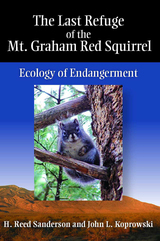 The Last Refuge of the Mt. Graham Red Squirrel: Ecology of Endangerment
H. Reed Sanderson and John L. Koprowski
University of Arizona Press, 2009 When the University of Arizona announced plans to build observatories on Mt. Graham, atop the Pinaleño Mountains, the construction was seen as a potential threat to an isolated species found only on this sky island. The Mt. Graham red squirrel was declared “endangered” by the US Fish and Wildlife Service. Legal action required the university to provide funds for research and monitoring the Mt. Graham red squirrel.
This book is derived from a symposium on the Mt. Graham red squirrel and offers a comprehensive picture of the ecology of this red squirrel and the impacts on its mountain home. Forty contributors detail studies conducted to understand the natural history of the creature and the challenges and changing ecological conditions on Mt. Graham.
Each chapter tells a unique story that contributes to the mosaic of natural history knowledge about the endangered Mt. Graham red squirrel. They reflect diverse viewpoints on the problems of conserving the habitats and populations of the squirrel, showing how it was complicated by perspectives ranging from Native Americans’ concern over traditional lands to astronomers’ hope for a better view of space, and by issues ranging from forestry practices to climate change. Studies of such factors as squirrel middens, seed hoarding, and nest sites provide definitive research on the animal.
Ongoing censuses continue to track the squirrel’s population trends, and both Forest Service and Arizona Department of Transportation activities continue to be scrutinized by interested parties to determine their impact. This book represents an authoritative overview of this still-endangered species and its habitat.
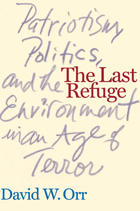 The Last Refuge: Patriotism, Politics, and the Environment in an Age of Terror
David W. Orr
Island Press, 2005 "Patriotism is the last refuge of scoundrels" -SAMUEL JOHNSON, 1775 Updated and revised following the 2004 elections, The Last Refuge describes the current state of American politics against the backdrop of mounting ecological and social problems, the corrosive influence of money, the corruption of language, and the misuse of terrorism as a political issue. Setting out an agenda that transcends conventional ideological labels, David Orr contends that partisan wrangling is only a symptom of a deeper dysfunction: The whole political machinery that connects Americans' fundamentally honorable ideals with public policy is broken. The book offers a withering critique of the failings of the Bush administration, supplemented by new essays that look at the national-level dominance of the Republican Party and examine the fallacy that the evangelical right represents a Christian majority. After analyzing the challenges of reforming the current system, Orr offers an empowering vision of a second American Revolution that peaceably achieves sustainability and charts a hopeful course for forward-looking citizens.
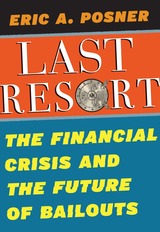 Last Resort: The Financial Crisis and the Future of Bailouts
Eric A. Posner
University of Chicago Press, 2018 The bailouts during the recent financial crisis enraged the public. They felt unfair—and counterproductive: people who take risks must be allowed to fail. If we reward firms that make irresponsible investments, costing taxpayers billions of dollars, aren’t we encouraging them to continue to act irresponsibly, setting the stage for future crises? And beyond the ethics of it was the question of whether the government even had the authority to bail out failing firms like Bear Stearns and AIG.
The answer, according to Eric A. Posner, is no. The federal government freely and frequently violated the law with the bailouts—but it did so in the public interest. An understandable lack of sympathy toward Wall Street has obscured the fact that bailouts have happened throughout economic history and are unavoidable in any modern, market-based economy. And they’re actually good. Contrary to popular belief, the financial system cannot operate properly unless the government stands ready to bail out banks and other firms. During the recent crisis, Posner agues, the law didn’t give federal agencies sufficient power to rescue the financial system. The legal constraints were damaging, but harm was limited because the agencies—with a few exceptions—violated or improvised elaborate evasions of the law. Yet the agencies also abused their power. If illegal actions were what it took to advance the public interest, Posner argues, we ought to change the law, but we need to do so in a way that also prevents agencies from misusing their authority. In the aftermath of the crisis, confusion about what agencies did do, should have done, and were allowed to do, has prevented a clear and realistic assessment and may hamper our response to future crises.
Taking up the common objections raised by both right and left, Posner argues that future bailouts will occur. Acknowledging that inevitability, we can and must look ahead and carefully assess our policy options before we need them.
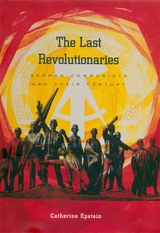 The Last Revolutionaries: German Communists and Their Century
Catherine Epstein
Harvard University Press, 2003 The Last Revolutionaries tells a story of unwavering political devotion: it follows the lives of German communists across the tumultuous twentieth century. Before 1945, German communists were political outcasts in the Weimar Republic and courageous resisters in Nazi Germany; they also suffered Stalin's Great Purges and struggled through emigration in countries hostile to communism. After World War II, they became leaders of East Germany, where they ran a dictatorial regime until they were swept out of power by the people's revolution of 1989.
In a compelling collective biography, Catherine Epstein conveys the hopes, fears, dreams, and disappointments of a generation that lived their political commitment. Focusing on eight individuals, The Last Revolutionaries shows how political ideology drove people's lives. Some of these communists, including the East German leaders Walter Ulbricht and Erich Honecker, enjoyed great personal success. But others, including the purge victims Franz Dahlem and Karl Schirdewan, experienced devastating losses. And, as the book demonstrates, female and Jewish communists faced their own sets of difficulties in the movement to which they had given their all.
Drawing on previously inaccessible sources as well as extensive personal interviews, Epstein offers an unparalleled portrait of the most enduring and influential generation of Central European communists. In the service of their party, these communists experienced solidarity and betrayal, power and persecution, sacrifice and reward, triumph and defeat. At once sordid and poignant, theirs is the story of European communism--from the heroic excitement of its youth, to the bureaucratic authoritarianism of its middle age, to the sorry debacle of its death.
 Last Rights: Revisiting *Four Theories of the Press*
Edited by John C. Nerone
University of Illinois Press, 1995 Though subjected to years of criticism, Four Theories of the Press remains a core text in communications. Its influence on the field, impact on generations of journalists, and ability to spark debate on why the press acts as it does continue to make it an oft-quoted source and classroom staple. In Last Rights, eight communications scholars critique and expand on the classic text. The authors argue that Four Theories spoke to and for a world beset by a cold war ended long ago. At the same time, they praise the book for offering an alternative view of the press and society and as a useful tool for helping scholars and citizens alike grapple with contradictions in classical liberalism. They also raise important questions about the Internet and other major changes in communications systems and society since the original publication of Four Theories. Contributors: William E. Berry, Sandra Braman, Clifford Christians, Thomas G. Guback, Steven J. Helle, Louis W. Liebovich, John C. Nerone, and Kim B. Rotzoll
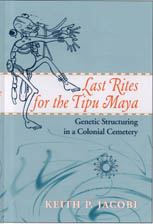 Last Rites for the Tipu Maya: Genetic Structuring in a Colonial Cemetery
Keith Jacobi
University of Alabama Press, 2000 Jacobi's groundbreaking osteology study uncovers the history of the Tipu Maya of Belize and their subsequent contact with the Spanish conquistadores and missionaries. Two cultures collided at Tipu, Belize, in the 1600s: that of the native Maya and that of the Spanish missionaries, who arrived with an agenda of religious subjugation and, ultimately, political control. Combining historical documentation with the results of an archaeological exploration of a Tipu cemetery, Keith Jacobi provides an account of the meshing of these two cultures and the assimilation of Catholic practices by the Tipu.
In particular, Jacobi focuses on the dental remains recovered at this site. A tooth may be the last tangible evidence of a living creature, so teeth can reveal information about an individual's health, diet, cosmetic alteration, trauma, and genetic structure. From the genetic structure the researcher can learn information about an individual's relationship to others in a particular population and between populations.
Jacobi's research reveals how these European and Spanish Catholic practices were assimilated by the Tipu Maya and enables the first description of the prevalent attitudes toward death and burial customs. Through this study of Tipu Maya dentition changes through time, Jacobi sheds light on Spanish intermarriage, Maya familial relationships, and the Tipu genetic affinity with other prehistoric, historic, and modern Maya.
 The Last River: Life Along Arkansas's Lower White
Turner Browne
University of Arkansas Press, 1993 With 68 compellingly beautiful photographs, Turner Browne documents a fast-disappearing way of life for the people who live on the lower White River and issues a plea to save the river from irreversible damage by the Army Corps of Engineers. By demonstrating that the endless dredging and flood control projects of the ever-active Corps are destroying the river's natural beauty and the livelihoods of those who make the river their only home - on houseboats and along its banks - he argues graphically and heroically for the preservation of a unique culture and of a great river. The black-and-white photographs, taken between Batesville, Arkansas, and the confluence with the Mississippi River, tell a story of loss, nostalgia, and fortitude as they portray the river's remarkable character and the exceptional lifestyles of acorn gatherers, sturgeon fishers, mussel divers, and others who extract a meager but satisfying existence from the river's resources. The damage the Corps of Engineers has wrought, including cleared forests, piles of debris, and "containment structures," certainly tolls a death knell for much of this natural waterway. The Last River is a journey, a journey probably never to be taken again.
The Last Saltmakers of Nexquipayac, Mexico: An Archaeological Ethnography
Jeffrey R. Parsons
University of Michigan Press, 2001 In the 1980s, a few traditional saltmakers were still manufacturing several kinds of salt in the eastern Valley of Mexico. This in-depth study of the methodology of this dying craft includes a comparative study of pre-industrial saltmaking around the world and considers the implications of this knowledge for future archaeological research.
Last Seen
Jacqueline Jones LaMon
University of Wisconsin Press, 2011 Inspired by actual case histories of long-term missing African American children, this provocative and heartrending collection of poems evokes the experience of what it means to be among the missing in contemporary America. This thought-provoking collection of persona poems looks at absence from the standpoint of the witnesses surrounding the void and offers an intimate depiction of those impossible moments of aftermath lived by those who remain accounted for and present. While enabling us to question our own sense of identity, this unique collection of poems reveals the blurred edges of separation between them and us and the impact that the missing have upon our present and future.
Finalist, NAACP Image Awards
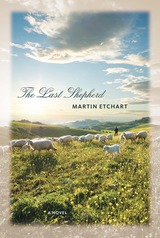 The Last Shepherd
Martin Etchart
University of Nevada Press, 2012 Mathieu Etchiberri wants nothing more than to leave his family’s Arizona sheep ranch and go to college, but his father insists that he take over the ranch instead. Then his father is killed in an accident, and Matt discovers that he is not the heir to the ranch. So he travels to the French Pyrenees from which his father and grandparents came to settle the questions about his legacy. Instead, he discovers a vast Basque family and a mystery that drove his father to America and still festers in the mountain village. As Matt resolves the mystery of his family, he also discovers his Basque roots and learns the nature of love of family, responsibility, and the tension between individual desires and the needs of a community.
Matt’s journey to manhood takes place in a vividly depicted landscape populated by lively, memorable characters. This is the powerful story of a young man’s search for an identity that encompasses two cultures and one complex, scattered family.
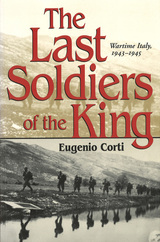 The Last Soldiers of the King: Life in Wartime Italy, 1943-1945
Eugenio Corti & Translated by Manuela Arundel
University of Missouri Press, 2003 In the sequel to the highly acclaimed Few Returned, Eugenio Corti, one of Italy’s most distinguished postwar writers, continues his poignant account of his experiences as an Italian soldier in the Second World War. In the earlier book, Corti, a twenty-one-year-old lieutenant of artillery, recounts the horrifying experience of the soldiers who were sent to Russia to fight alongside their German ally. On the River Don, the Red Army surrounded Corti and the other members of the Italian force. Of the 30,000 men in the Thirty-fifth Corps, Corti was one of only an estimated 4,000 soldiers to survive the ordeal. Mussolini’s dreams of empire were shattered, and his ill-fated Eighth Army no longer existed. In 1943, after recurrent military defeats, the Italian government and its king, Victor Emmanuel III, forced Mussolini to resign. Italy then signed an armistice with the Allies and ended its alliance with Germany. The Germans immediately occupied northern Italy, which the Axis still held, and reinstated Mussolini in the north. Some Italians remained loyal to fascism; many others aligned themselves with the Allies, who were now advancing in southern Italy. Corti’s sympathies were with the Allies, and after a harrowing escape from the German-occupied north, he rejoined the Italian Army fighting on the side of the king. The Last Soldiers of the King is Corti’s account of the Italian Army’s experiences fighting the Germans during the remainder of the war. In this unforgettable narrative, Corti depicts the war from the perspective of the average Italian soldier, capturing its boredom and absurdity along with brief periods of savagery, terror, and death. Painting vivid pictures of the sights, sounds, and smells of war, he shows how these men fought alongside the Allies against the Germans. They fought without hatred, driven by a sense of duty and love for their country and a desire to quickly put an end to a war that was destroying so many lives. Corti superbly relates the wandering of the remnant of Italian officers and men as they sought to reestablish themselves as Italian soldiers. The Last Soldiers of the King tells the story of a proud people forced to endure death, poverty, and the virtual destruction of their nation.
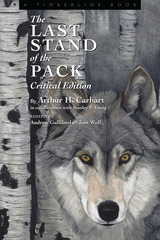 The Last Stand of the Pack: Critical Edition
Andrew Gulliford
University Press of Colorado, 2017 This critical edition explores the past and future of wolves in Colorado. Originally published in 1929, The Last Stand of the Pack is a historical account of the extermination of what were then believed to be the last wolves in Colorado. Arthur H. Carhart and Stanley P. Young describe the wolves’ extermination and extoll the bravery of the federal trappers hunting them down while simultaneously characterizing the wolves as cunning individuals and noble adversaries to the growth of the livestock industry and the settlement of the West. This is nature writing at its best, even if the worldview expressed is at times jarring to the twenty-first-century reader. Now, almost 100 years later, much has been learned about ecology and the role of top-tier predators within ecosystems. In this new edition, Carhart and Young’s original text is accompanied by an extensive introduction with biographical details on Arthur Carhart and an overview of the history of wolf eradication in the west; chapters by prominent wildlife biologists, environmentalists, wolf reintroduction activists, and ranchers Tom Compton, Bonnie Brown, Mike Phillips, Norman A. Bishop, and Cheney Gardner; and an epilogue considering current issues surrounding the reintroduction of wolves in Colorado. Presenting a balanced perspective, these additional chapters address views both in support of and opposed to wolf reintroduction. Coloradans are deeply interested in wilderness and the debate surrounding wolf reintroduction, but for wolves to have a future in Colorado we must first understand the past. The Last Stand of the Pack: Critical Edition presents both important historical scholarship and contemporary ecological ideas, offering a complete picture of the impact of wolves in Colorado.
Last Stand of the Red Spruce
Robert A. Mello
Island Press, 1988 Here is a vitally important book for anyone who is concerned with acid rain and the fate of our forests. In his fascinating investigation into the decline of the red spruce on Camel Hump in Vermont, Robert A. Mello explores an ecological mystery. He presents, in clear, concise, non-technical language, both sides of an issue which has split the scientific community.Last Stand of the Red Spruce tells us the the time is long past-due to take action on acid rain. Mello urges pressure for legislation to preserve our health and warns us that we can no longer be complacent.
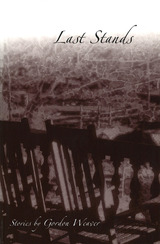 Last Stands: Stories
Stories by Gordon Weaver
University of Missouri Press, 2004
In a distinguished career that has yielded four novels, ten story collections, and a volume of poetry, Gordon Weaver has maintained a distinctive literary voice that, despite its always recognizable presence, never fails to surprise longtime readers of his work. His best stories somehow manage to be witty and deadly serious at the same time.
Last Stands presents people at crucial moments in their lives, the moments in which ultimate challenges are confronted, ultimate questions are asked, and definitive judgments are made. Weaver’s characters may flounder, and fail, but they are redeemed by their courage and their honesty.
A hired assassin ponders his self-worth, a bartender takes his only chance for worldly success, a man buries his mother, another talks with the dead, yet another attends his high school reunion determined on vindication, and a war-weary Vietnam vet finds a place he can call home. These are stories that do not shun the darker side of Weaver’s characters, but seek the illumination of the insights needed to make their lives meaningful, if only to themselves.
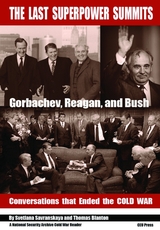 The Last Superpower Summits: Reagan, Gorbachev and Bush. Conversations that Ended the Cold War.
The National Security Archive Savranskaya
Central European University Press, 2017 This book publishes for the first time in print every word the American and Soviet leaders – Ronald Reagan, Mikhail Gorbachev, and George H.W. Bush – said to each other in their superpower summits from 1985 to 1991. Obtained by the authors through the Freedom of Information Act in the U.S., from the Gorbachev Foundation and the State Archive of the Russian Federation in Moscow, and from the personal donation of Anatoly Chernyaev, these previously Top Secret verbatim transcripts combine with key declassified preparatory and after-action documents from both sides to create a unique interactive documentary record of these historic highest-level talks – the conversations that ended the Cold War. The summits fueled a process of learning on both sides, as the authors argue in contextual essays on each summit and detailed headnotes on each document. Geneva 1985 and Reykjavik 1986 reduced Moscow's sense of threat and unleashed Reagan's inner abolitionist. Malta 1989 and Washington 1990 helped dampen any superpower sparks that might have flown in a time of revolutionary change in Eastern Europe, set off by Gorbachev and by Eastern Europeans (Solidarity, dissidents, reform Communists). The high level and scope of the dialogue between these world leaders was unprecedented, and is likely never to be repeated.
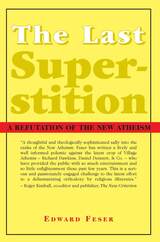 The Last Superstition: A Refutation of the New Atheism
Edward Feser
St. Augustine's Press, 2010 The central contention of the “New Atheism” of Richard Dawkins, Daniel Dennett, Sam Harris, and Christopher Hitchens is that there has for several centuries been a war between science and religion, that religion has been steadily losing that war, and that at this point in human history a completely secular scientific account of the world has been worked out in such thorough and convincing detail that there is no longer any reason why a rational and educated person should find the claims of any religion the least bit worthy of attention. But as Edward Feser argues inThe Last Superstition, in fact there is not, and never has been, any war between science and religion at all. There has instead been a conflict between two entirely philosophical conceptions of the natural order: on the one hand, the classical “teleological” vision of Plato, Aristotle, Augustine, and Aquinas, on which purpose or goal-directedness is as inherent a feature of the physical world as mass or electric charge; and the modern “mechanical” vision of Descartes, Hobbes, Locke, and Hume, according to which the physical world is comprised of nothing more than purposeless, meaningless particles in motion. As it happens, on the classical teleological picture, the existence of God, the immortality of the soul, and the natural-law conception of morality are rationally unavoidable. Modern atheism and secularism have thus always crucially depended for their rational credentials on the insinuation that the modern, mechanical picture of the world has somehow been established by science. Yet this modern “mechanical” picture has never been established by science, and cannot be, for it is not a scientific theory in the first place but merely a philosophical interpretation of science. Moreover, as Feser shows, the philosophical arguments in its favor given by the early modern philosophers were notable only for being surprisingly weak. The true reasons for its popularity were then, and are now, primarily political: It was a tool by which the intellectual foundations of ecclesiastical authority could be undermined and the way opened toward a new secular and liberal social order oriented toward commerce and technology. So as to further these political ends, it was simply stipulated, by fiat as it were, that no theory inconsistent with the mechanical picture of the world would be allowed to count as “scientific.” As the centuries have worn on and historical memory has dimmed, this act of dogmatic stipulation has falsely come to be remembered as a “discovery.” However, not only is this modern philosophical picture rationally unfounded, it is demonstrably false. For the “mechanical” conception of the natural world, when worked out consistently, absurdly entails that rationality, and indeed the human mind itself, are illusory. The so-called “scientific worldview” championed by the New Atheists thus inevitably undermines its own rational foundations; and into the bargain (and contrary to the moralistic posturing of the New Atheists) it undermines the foundations of any possible morality as well. By contrast, and as The Last Superstition demonstrates, the classical teleological picture of nature can be seen to find powerful confirmation in developments from contemporary philosophy, biology, and physics; moreover, morality and reason itself cannot possibly be made sense of apart from it. The teleological vision of the ancients and medievals is thereby rationally vindicated – and with it the religious worldview they based upon it.
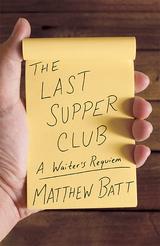 The Last Supper Club: A Waiter's Requiem
Matthew Batt
University of Minnesota Press, 2023 A witty and humble tribute to the sometimes profane, sometimes profound world of waiting tables
During a year on sabbatical from his university position, Matthew Batt realized he needed money—fast—and it just so happened that one of the biggest breweries in the Midwest was launching a restaurant and looking to hire. So it was that the forty-something tenured professor found himself waiting tables at a high-end restaurant situated in a Minneapolis brewery. And loving it. Telling the story of Batt’s early work in restaurants, from a red sauce joint possibly run by the mob to an ill-conceived fusion concept eatery, The Last Supper Club then details his experiences at the fine dining restaurant, a job that continued well past his sabbatical—that lasted, in fact, right up to the restaurant’s sudden and unceremonious closing three years later, shortly after it was named one of the best restaurants in the country by Food & Wine. Batt’s memoir conveys the challenge—and the satisfaction—of meeting the demands of a frenzied kitchen and an equally expectant crowd. Through training mishaps, disastrous encounters with confused diners, struggles to keep pace with far more experienced coworkers, mandatory memorizations of laundry lists of obscure ingredients, and the stress of balancing responsibilities at home and at work, The Last Supper Club reveals the ups and downs of a waiter’s workday and offers an insightful perspective on what makes a job good, bad, or great. For Batt, this job turns out to be considerably more fun, and possibly more rewarding, than his academic career, and his insider’s view of waiting tables extols the significance of our food and the places where we gather to enjoy it—or serve it. Told with sharp humor, humility, and a keen sense of what matters, The Last Supper Club is an ode to life in a high-pressure restaurant, the relationships that get you to the night’s close, and finding yourself through—or perhaps because of—the chaos of it all.
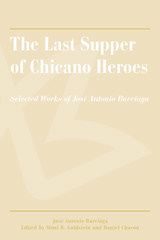 The Last Supper of Chicano Heroes: Selected Works of José Antonio Burciaga
José Antonio Burciaga; Edited by Mimi R. Goldstein and Daniel Chacón
University of Arizona Press, 2008 Widely considered one of the most important voices in the Chicano literary canon, José Antonio Burciaga was a pioneer who exposed inequities and cultural difficulties through humor, art, and deceptively simple prose. In this anthology and tribute, Mimi R. Gladstein and Daniel Chacón bring together dozens of remarkable examples of Burciaga’s work. His work never demonstrates machismo or sexism, as he believed strongly that all Chicano voices are equally valuable.
Best known for his books Weedee Peepo, Drink Cultura, and Undocumented Love, Burciaga was also a poet, cartoonist, founding member of the comedy troupe Cultura Clash, and a talented muralist whose well-known work The Last Supper of Chicano Heroes became almost more famous than the man. This first and only collection of Burciaga’s work features thirty-eight illustrations and incorporates previously unpublished essays and drawings, including selections from his manuscript “The Temple Gang,” a memoir he was writing at the time of his death. In addition, Gladstein and Chacón address Burciaga’s importance to Chicano letters.
A joy to read, this rich compendium is an important contribution not only to Chicano literature but also to the preservation of the creative, spiritual, and political voice of a talented and passionate man.
 The Last Syrian
Omar Youssef Souleimane
Seagull Books, 2024 A rare narrative of gay love in the Arab world that travels into the lives of a group of spirited youth during the Syrian Revolution.
Youssef’s mother has always told him that he is named after the biblical prophet Joseph who had the power of foresight. But when Youssef participated in the first demonstration in Damascus in 2011, he felt that the uprising against the Bashar al-Assad regime after forty years of silence and fear was “a miracle more powerful than that of the prophet.”
While Josephine, a charming young Alawite, gathers in her home a group of youth to fight for their visions of a promising future, a forbidden love story unfolds between two men, Youssef and Mohammad. Meanwhile, young Khalid’s love for Josephine is brutally interrupted by the agents of the oppressive regime. Homosexuality clashes with tradition, emancipation with persecution, and feelings with loyalties, leading to an upheaval that sweeps away the destinies of the young as well as that of an entire nation.
Omar Youssef Souleimane’s eloquent novel is not only a narrative of the Syrian Revolution; it is also a story about inter-generational conflicts, rebellion, and liberation. With intense, poetic prose, he brilliantly captures the indomitable yearning for freedom that, despite all obstacles and setbacks, always survives in a hopeful person’s heart until it’s attained.
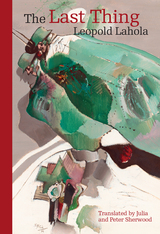 The Last Thing
Leopold Lahola
Karolinum Press, 2025 An English translation of Slovak Jewish writer Leopold Lahola’s collection of short stories that face the atrocities and paradoxes of World War II.
Slovak Jewish writer Leopold Lahola was able to escape deportation to a concentration camp and fight in the resistance only to find himself forced into exile by the postwar communist regime. He emerged from obscurity during the brief thaw of the Prague Spring, when he was able to return to his homeland and thrive as a playwright and film director. It was also in 1968 that his short story collection The Last Thing appeared in Slovakia. The collection’s title proved sadly prophetic with the author suffering a fatal heart attack in January 1968, just before his 50th birthday and as his short stories finally appeared in book form.
The nine stories which make up The Last Thing range from the prewar rise of fascism and its dangers for the Jewish community through the concentration camps and the partisan fight against the Germans, concluding in the devastating awareness of all that had been lost and destroyed in the war. Lahola is a master of writing outside of conventional tropes, exploring moral ambivalences where others work within the comforts of good versus evil. He punctures the standard historical image of the partisan fighters by depicting their heroism along with their cruelty and pettiness while also showing how often bravery and madness, kindness and stupidity can coexist. Lahola has written a World War II story collection whose translation will offer not only a compelling read but starkly new perspectives on the tragedy and grandeur of that momentous time in history.
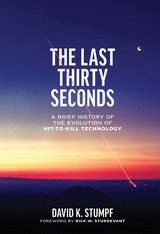 The Last Thirty Seconds: A Brief History of the Evolution of Hit-to-Kill Technology
David K. Stumpf
University of Arkansas Press, 2024 In March 1983, as the world’s superpowers continued aggressively stockpiling nuclear weapons, President Ronald Reagan described his vision for a world no longer confronted with the concept of mutually assured destruction. A year later the Strategic Defense Initiative was established, followed soon after by the creation of the Strategic Defense Initiative Organization (SDIO). The SDIO was tasked with the development and coordination of missile technologies designed for the strategic defense against civilization’s most dangerous invention, one that carried with it the threat of nuclear destruction—intercontinental ballistic missiles.
In The Last Thirty Seconds: A Brief History of the Evolution of Hit-to-Kill Technology, David K. Stumpf details the development of one of many possible solutions for ballistic missile defense commonly known as hit-to-kill. Hit-to-kill is a nonnuclear technique using kinetic energy, rather than explosives, to destroy reentry vehicles carrying chemical, biological, or nuclear warheads. It is the centerpiece of the United States’ current ballistic missile defense systems and has proven invaluable in the conflict between Ukraine and Russia as well as in the ongoing conflict with the Houthi rebels in the Red Sea. While much of the subject remains classified, this detailed study will be welcomed for its substantial references and the inclusion of newly declassified material.
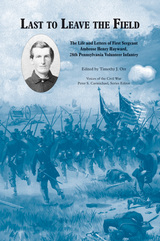 Last to Leave the Field: The Life and Letters of First Sergeant Ambrose Henry Hayward, 28th Pennsylvania Volunteers
Timothy J. Orr
University of Tennessee Press, 2010
Revealing the mind-set of a soldier seared by the horrors of combat even as he kept faith in his cause, Last to Leave the Field showcases the private letters of Ambrose Henry Hayward, a Massachusetts native who served in the 28th Pennsylvania Volunteer Infantry.
Hayward’s service, which began with his enlistment in the summer of 1861 and ended three years later following his mortal wounding at the Battle of Pine Knob in Georgia, took him through a variety of campaigns in both the Eastern and Western theaters of the war. He saw action in five states, participating in the battles of Antietam, Chancellorsville, and Gettysburg as well as in the Chattanooga and Atlanta campaigns. Through his letters to his parents and siblings, we observe the early idealism of the young recruit, and then, as one friend after another died beside him, we witness how the war gradually hardened him. Yet, despite the increasing brutality of what would become America’s costliest conflict, Hayward continually reaffirmed his faith in the Union cause, reenlisting for service late in 1863.
Hayward’s correspondence takes us through many of the war’s most significant developments,
including the collapse of slavery and the enforcement of Union policy toward Southern civilians. Also revealed are Hayward’s feelings about Confederates, his assessments of Union political and military leadership, and his attitudes toward desertion, conscription, forced marches, drilling, fighting, bravery, cowardice, and comradeship.
Ultimately, Hayward’s letters reveal the emotions—occasionally guarded but more often expressed with striking candor—of a soldier who at every battle resolved to be, as one comrade described him, “the first to spring forward and the last to leave the field.”
Timothy J. Orr is an assistant professor of military history at Old Dominion University in Norfolk, Virginia.
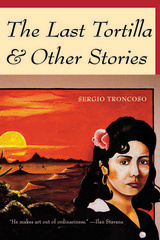 The Last Tortilla: and Other Stories
Sergio Troncoso
University of Arizona Press, 1999 "She asked me if I liked them. And what could I say? They were wonderful." From the very beginning of Sergio Troncoso's celebrated story "Angie Luna," we know we are in the hands of a gifted storyteller. Born of Mexican immigrants, raised in El Paso, and now living in New York City, Troncoso has a rare knack for celebrating life.
Writing in a straightforward, light-handed style reminiscent of Grace Paley and Raymond Carver, he spins charming tales that reflect his experiences in two worlds. Troncoso's El Paso is a normal town where common people who happen to be Mexican eat, sleep, fall in love, and undergo epiphanies just like everyone else. His tales are coming-of-age stories from the Mexican-American border, stories of the working class, stories of those coping with the trials of growing old in a rapidly changing society. He also explores New York with vignettes of life in the big city, capturing its loneliness and danger.
Beginning with Troncoso's widely acclaimed story "Angie Luna," the tale of a feverish love affair in which a young man rediscovers his Mexican heritage and learns how much love can hurt, these stories delve into the many dimensions of the human condition. We watch boys playing a game that begins innocently but takes a dangerous turn. We see an old Anglo woman befriending her Mexican gardener because both are lonely. We witness a man terrorized in his New York apartment, taking solace in memories of lost love. Two new stories will be welcomed by Troncoso's readers. "My Life in the City" relates a transplanted Texan's yearning for companionship in New York, while "The Last Tortilla" returns to the Southwest to explore family strains after a mother's death—and the secret behind that death. Each reflects an insight about the human heart that has already established the author's work in literary circles.
Troncoso sets aside the polemics about social discomfort sometimes found in contemporary Chicano writing and focuses instead on the moral and intellectual lives of his characters. The twelve stories gathered here form a richly textured tapestry that adds to our understanding of what it is to be human.
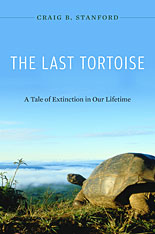 The Last Tortoise: A Tale of Extinction in Our Lifetime
Craig B. Stanford
Harvard University Press, 2010 Tortoises may be the first family of higher animals to become extinct in the coming decades. They are losing the survival race because of what distinguishes them, in particular their slow, steady pace of life and reproduction.
The Last Tortoise offers an introduction to these remarkable animals and the extraordinary adaptations that have allowed them to successfully populate a diverse range of habitats—from deserts to islands to tropical forests. The shields that protect their shoulders and ribs have helped them evade predators. They are also safeguarded by their extreme longevity and long period of fertility. Craig Stanford details how human predation has overcome these evolutionary advantages, extinguishing several species and threatening the remaining forty-five.
At the center of this beautifully written work is Stanford’s own research in the Mascarene and Galapagos Islands, where the plight of giant tortoise populations illustrates the threat faced by all tortoises. He addresses unique survival problems, from genetic issues to the costs and benefits of different reproductive strategies. Though the picture Stanford draws is bleak, he offers reason for hope in the face of seemingly inevitable tragedy. Like many intractable environmental problems, extinction is not manifest destiny. Focusing on tortoise nurseries and breeding facilities, the substitution of proxy species for extinct tortoises, and the introduction of species to new environments, Stanford’s work makes a persuasive case for the future of the tortoise in all its rich diversity.
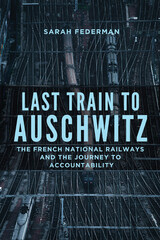 Last Train to Auschwitz: The French National Railways and the Journey to Accountability
Sarah Federman
University of Wisconsin Press, 2021 In the immediate decades after World War II, the French National Railways (SNCF) was celebrated for its acts of wartime heroism. However, recent debates and litigation have revealed the ways the SNCF worked as an accomplice to the Third Reich and was actively complicit in the deportation of 75,000 Jews and other civilians to death camps. Sarah Federman delves into the interconnected roles—perpetrator, victim, and hero—the company took on during the harrowing years of the Holocaust. Grounded in history and case law, Last Train to Auschwitz traces the SNCF’s journey toward accountability in France and the United States, culminating in a multimillion-dollar settlement paid by the French government on behalf of the railways.The poignant and informative testimonies of survivors illuminate the long-term effects of the railroad’s impact on individuals, leading the company to make overdue amends. In a time when corporations are increasingly granted the same rights as people, Federman’s detailed account demonstrates the obligations businesses have to atone for aiding and abetting governments in committing atrocities. This volume highlights the necessity of corporate integrity and will be essential reading for those called to engage in the difficult work of responding to past harms.
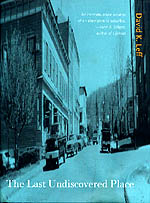 The Last Undiscovered Place
David K. Leff
University of Virginia Press, 2004 With warmth and a keen eye for the nuances of history and place, David K. Leff offers this affectionate, insightful portrait of his adopted home of Collinsville, Connecticut, a village that looked perfectly ordinary until he fell prey to its rhythms and charm. The town taught him a new way of seeing his environment, and through this process he discovered what many Americans long for amid the suburban sprawl decried in James H. Kunstler's The Geography of Nowhere and many other recent books: a sense of community.
When Leff began to look for a suitable place to raise a family, his criteria were familiar: an affordable fixer-upper with some historical character, pleasant neighbors, good schools, walkable streets, and attractive natural surroundings. The suburbs around Hartford were uninviting, so he settled sixteen miles away in Collinsville, a small village that grew up around--indeed was largely built by--The Collins Company, once the world's leading maker of edge tools.
Collins, which supplied the pikes for John Brown's raid on Harpers Ferry, went out of business in 1966, and Collinsville settled into the familiar decrepitude of many New England mill towns. In spite of its half-alive state, Leff found in its battered factory buildings and struggling main street an extraordinary place. Built before the restrictive zoning codes that today keep most Americans in their cars for hours on end, Collinsville's mixed-use center has been preserved by industrious residents and a hilly topography marked by the presence of the Farmington River, which once drove the mill. The landscape designer Frederick Law Olmsted Sr. lived here at a time when Samuel Collins, the socially minded founder of the company, was laying out his ideal village for workers and managers.
Leff feels Olmsted's presence as he walks the village's uneven streets, often in the company of his children, musing on its history, politics, and architecture. Living at the center of Collins's creation years later, Leff has come to believe, like Olmsted, that human beings are deeply affected by their experience of landscape, and that local interaction--between parents and teachers, store owners and customers, bar regulars and volunteer firefighters--matters. The Last Undiscovered Place argues quietly but forcefully for looking at our landscapes more carefully, as Leff strives for a metaphorical Collinsville that can serve as a way to rediscover other places, those that already exist and those that are still on the drawing boards of developers and planners.
--------------------------------------------------------------------------------
David K. Leff, author of numerous essays and stories for the Hartford Courant and other periodicals, is Deputy Commissioner, Connecticut Department of Environmental Protection. He has served as chairman of the Collinsville Historic District Commission, and as a volunteer firefighter, among other civic activities
The Last Unkillable Thing
Emily Pitinos
University of Iowa Press, 2021 This collection holds a mirror to the self and in its reflection we find the elegiac and the ecological, as in “how much of enjoying a place / is destroying it?”; the worlds both domestic and natural, as in “when the redbird strikes the window, it is me / who takes blame”; a daughter shattered, but not without humor—“I can feel it coming on, my season of lavish suffering, the why me why me why me why me / that leaves me snowblind in the asking”—and, certainly, not without tenderness. Shaped by both concision and unfolding sequences, The Last Unkillable Thing is a journey across landscapes of mourning.
 The Last Utopia: Human Rights in History
Samuel Moyn
Harvard University Press, 2010 Human rights offer a vision of international justice that today’s idealistic millions hold dear. Yet the very concept on which the movement is based became familiar only a few decades ago when it profoundly reshaped our hopes for an improved humanity. In this pioneering book, Samuel Moyn elevates that extraordinary transformation to center stage and asks what it reveals about the ideal’s troubled present and uncertain future.
For some, human rights stretch back to the dawn of Western civilization, the age of the American and French Revolutions, or the post–World War II moment when the Universal Declaration of Human Rights was framed. Revisiting these episodes in a dramatic tour of humanity’s moral history, The Last Utopia shows that it was in the decade after 1968 that human rights began to make sense to broad communities of people as the proper cause of justice. Across eastern and western Europe, as well as throughout the United States and Latin America, human rights crystallized in a few short years as social activism and political rhetoric moved it from the hallways of the United Nations to the global forefront.
It was on the ruins of earlier political utopias, Moyn argues, that human rights achieved contemporary prominence. The morality of individual rights substituted for the soiled political dreams of revolutionary communism and nationalism as international law became an alternative to popular struggle and bloody violence. But as the ideal of human rights enters into rival political agendas, it requires more vigilance and scrutiny than when it became the watchword of our hopes.
The Last Visit
Chad Abushanab
Autumn House Press, 2019 In Chad Abushanab’s debut poetry collection, The Last Visit, he carefully and compassionately explores a family broken by alcoholism and abuse. These poems trace the trajectory of an adolescent living with a violent father struggling with addiction, and recount both the abused child’s perspective and his attempts to reckon with his past as he reaches adulthood, chronicling his own struggles with substance abuse and the reverberations of trauma in his life. Amid the violence and hurt, Abushanab’s verse renders moments of compassion—even the least sympathetic figures are shown to be grappling with their flaws, and the narrator struggles to find compassion and move beyond the memories and habits that haunt him. These well-crafted poems explore how the past shapes us and how difficult it can be to leave behind.
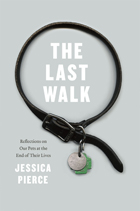 The Last Walk: Reflections on Our Pets at the End of Their Lives
Jessica Pierce
University of Chicago Press, 2012 From the moment when we first open our homes—and our hearts—to a new pet, we know that one day we will have to watch this beloved animal age and die. The pain of that eventual separation is the cruel corollary to the love we share with them, and most of us deal with it by simply ignoring its inevitability. With The Last Walk, Jessica Pierce makes a forceful case that our pets, and the love we bear them, deserve better. Drawing on the moving story of the last year of the life of her own treasured dog, Ody, she presents an in-depth exploration of the practical, medical, and moral issues that trouble pet owners confronted with the decline and death of their companion animals. Pierce combines heart-wrenching personal stories, interviews, and scientific research to consider a wide range of questions about animal aging, end-of-life care, and death. She tackles such vexing questions as whether animals are aware of death, whether they're feeling pain, and if and when euthanasia is appropriate. Given what we know and can learn, how should we best honor the lives of our pets, both while they live and after they have left us?
The product of a lifetime of loving pets, studying philosophy, and collaborating with scientists at the forefront of the study of animal behavior and cognition, The Last Walk asks—and answers—the toughest questions pet owners face. The result is informative, moving, and consoling in equal parts; no pet lover should miss it.
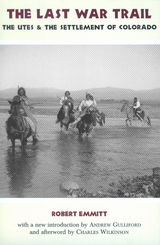 The Last War Trail: The Utes and the Settlement of Colorado
Robert Emmitt
University Press of Colorado, 2000 Robert Emmitt's The Last War Trail: The Utes and the Settlement of Colorado is one of the most important and innovative books written on Ute Indians from Colorado. Saponise Cuch, Chief of the White River Utes, said to Robert Emmitt in 1948, "I am an old man now, and I am the only one left who remembers this. I have known that someone would come to tell this story; now you will write it out, as I have told it to you." Drawing upon historical documents, transcripts, and letters as well as interviews with Northern Ute elders, Emmitt describes the tragedy of United States Indian Agent Nathan Meeker's plan to "civilize" the Utes, and the resulting military intervention in which fifty Ute warriors held off the U.S. cavalry and killed Meeker, Major Thomas Thornburgh, and others. Ute warriors sought only to defend their families and their way of life, but the price for that defense was forced removal from Colorado and the loss of over twelve million acres. "The Utes Must Go" became a rallying cry for white settlers who coveted the lands of peaceful Utes.
Written with the care and precision of a finely crafted novel, The Last War Trail was nominated for the Pulitzer Prize when it was first published in 1954. Long out of print and now brought back with new rare photographs and illustrations, The Last War Trail will be eagerly read by anyone trying to understand conflicts of the nineteenth century between Native American and encroaching settlers.
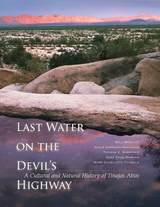 Last Water on the Devil's Highway: A Cultural and Natural History of Tinajas Altas
Bill Broyles, Gayle Harrison Hartmann, Thomas E. Sheridan, Gary Paul Nabhan, and Mary Charlotte Thurtle
University of Arizona Press, 2013 The Devil’s Highway—El Camino del Diablo—crosses hundreds of miles and thousands of years of Arizona and Southwest history. This heritage trail follows a torturous route along the U.S. Mexico border through a lonely landscape of cactus, desert flats, drifting sand dunes, ancient lava flows, and searing summer heat. The most famous waterhole along the way is Tinajas Altas, or High Tanks, a series of natural rock basins that are among the few reliable sources of water in this notoriously parched region.
Now an expert cast of authors describes, narrates, and explains the human and natural history of this special place in a thorough and readable account. Addressing the latest archaeological and historical findings, they reveal why Tinajas Altas was so important and how it related to other waterholes in the arid borderlands. Readers can feel like pioneers, following in the footsteps of early Native Americans, Spanish priests and soldiers, gold seekers and borderland explorers, tourists, and scholars.
Combining authoritative writing with a rich array of more than 180 illustrations and maps as well as detailed appendixes providing up-to-date information on the wildlife and plants that live in the area, Last Water on the Devil’s Highway allows readers to uncover the secrets of this fascinating place, revealing why it still attracts intrepid tourists and campers today.
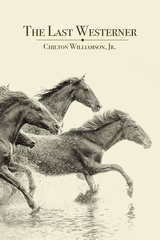 The Last Westerner
Chilton Williamson, Jr.
St. Augustine's Press, 2025 This is a tale of one man's road toward fulfillment that plays out in stages of encounters and abandonment instead of one glorious "last stand" expected in a Western romance. Williamson's story weaves the best elements of several genres and with masterful dialogue he illustrates the landscape of a heart cultivated and ravaged by the challenges that emerge in his path. The majestic setting of the rugged west and its horses is not the main aesthetical context, however. "For [us] women were the whole world and the promise of it, men being hardly more than rivals in love to be challenged and defeated." The Last Westerner is an ode to human happiness embodied in women, and "the kind that comes from a sense of the wholeness, the absolute rightness, of it all." Williamson seems to mean that without women (and horses) no such answers will ever be found. "People without hope don't write books, they say. Neither do men who love women––one woman in particular––lack hope." Jeb Stuart Ryder, at 51 a retired range detective from Wyoming, meets Jody James, a handsome widowed cowgirl at a horse show in Moab, Utah, where she is exhibiting her prize horse. They begin an idyllic life together until this horse is stolen, and he pledges to pursue the thieves and bring him back to her. Along the way he meets a 16-year-old Navajo boy, John-Wayne Bilagody, who joins the search but with the intention of offering this horse to his own woman. Jeb takes it upon himself to instruct John-Wayne in the proper chivalric attitude a man owes a woman. When they come to the camp of brigada who now possesses the horse, Jeb's world strains to accommodate the existence of Carmen, the beautiful and aristocratic woman who is preparing to lead those men back into Mexico. She has his horse, but his pledge to return it to Jody holds fast. His promise had been a sign of hope, but Jeb at long last arrives at a pass that he knows is the real path to his sunset.
The Last Word: Women, Death, and Divination in Inner Mani
C. Nadia Seremetakis
University of Chicago Press, 1991 Based on years of fieldwork in both rural and urban Greece, The Last Word explores women's cultural resistance as they weave together diverse social practices: improvised antiphonic laments, divinatory dreaming, the care and tending of olive trees and the dead, and the inscription of emotions and the senses on a landscape of persons, things, and places. These practices compose the empowering poetics of the cultural periphery. C. Nadia Seremetakis liberates the analysis of gender from reductive binary models and pioneers the alternative perspective of self-reflexive "native anthropology" in European ethnography.
Last Words: Large Language Models and the AI Apocalypse
Paul Kockelman
Prickly Paradigm Press, 2024 A critical exegesis of large language models, like ChatGPT, and recent advances in artificial intelligence.
If speech has long been an emblem of the human species, then talking machines seem to be harbingers of some kind of technological singularity. Indeed, if the brilliance—or at least eloquence—of large language models is any indication, we seem to be poised at the threshold of general AI, a form of artificial intelligence that will not only surpass human intelligence but maybe even replace humans altogether.
This slim text lays out a critical genealogy of the highly contested relation between human values, machinic parameters, and corporate powers. It also provides a theory of the reasons for, and effects of, our current social and technological horizon.
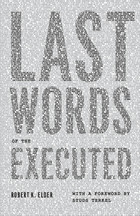 Last Words of the Executed
Robert K. Elder
University of Chicago Press, 2010 Some beg for forgiveness. Others claim innocence. At least three cheer for their favorite football teams. Death waits for us all, but only those sentenced to death know the day and the hour—and only they can be sure that their last words will be recorded for posterity. Last Words of the Executed presents an oral history of American capital punishment, as heard from the gallows, the chair, and the gurney. The product of seven years of extensive research by journalist Robert K. Elder, the book explores the cultural value of these final statements and asks what we can learn from them. We hear from both the famous—such as Nathan Hale, Joe Hill, Ted Bundy, and John Brown—and the forgotten, and their words give us unprecedented glimpses into their lives, their crimes, and the world they inhabited. Organized by era and method of execution, these final statements range from heartfelt to horrific. Some are calls for peace or cries against injustice; others are accepting, confessional, or consoling; still others are venomous, rage-fueled diatribes. Even the chills evoked by some of these last words are brought on in part by the shared humanity we can’t ignore, their reminder that we all come to the same end, regardless of how we arrive there. Last Words of the Executed is not a political book. Rather, Elder simply asks readers to listen closely to these voices that echo history. The result is a riveting, moving testament from the darkest corners of society.
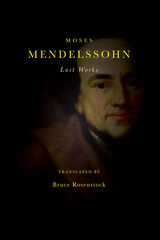 Last Works
Moses Mendelssohn. Translated by Bruce Rosenstock
University of Illinois Press, 2012 Moses Mendelssohn (1729–1786) was the central figure in the emancipation of European Jewry. His intellect, judgment, and tact won the admiration and friendship of contemporaries as illustrious as Johann Gottfried Herder, Gotthold Ephraim Lessing, and Immanuel Kant. His enormously influential Jerusalem (1783) made the case for religious tolerance, a cause he worked for all his life. Last Works includes, for the first time complete and in a single volume, the English translation of Morning Hours: Lectures on the Existence of God (1785) and To the Friends of Lessing (1786). Bruce Rosenstock has also provided an historical introduction and an extensive philosophical commentary to both texts. At the center of Mendelssohn's last works is his friendship with Lessing. Mendelssohn hoped to show that he, a Torah-observant Jew, and Lessing, Germany's leading dramatist, had forged a life-long friendship that held out the promise of a tolerant and enlightened culture in which religious strife would be a thing of the past. Lessing's death in 1781 was a severe blow to Mendelssohn. Mendelssohn wrote his last two works to commemorate Lessing and to carry on the work to which they had dedicated much of their lives. Morning Hours treats a range of major philosophical topics: the nature of truth, the foundations of human knowledge, the basis of our moral and aesthetic powers of judgment, the reality of the external world, and the grounds for a rational faith in a providential deity. It is also a key text for Mendelssohn's readings of Spinoza. In To the Friends of Lessing, Mendelssohn attempts to unmask the individual whom he believes to be the real enemy of the enlightened state: the Schwärmer, the religious fanatic who rejects reason in favor of belief in suprarational revelation.
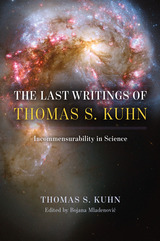 The Last Writings of Thomas S. Kuhn: Incommensurability in Science
Thomas S. Kuhn
University of Chicago Press, 2022 A must-read follow-up to The Structure of Scientific Revolutions, one of the most important books of the twentieth century.
This book contains the text of Thomas S. Kuhn’s unfinished book, The Plurality of Worlds: An Evolutionary Theory of Scientific Development, which Kuhn himself described as a return to the central claims of The Structure of Scientific Revolutions and the problems that it raised but did not resolve. The Plurality of Worlds is preceded by two related texts that Kuhn publicly delivered but never published in English: his paper “Scientific Knowledge as Historical Product” and his Shearman Memorial Lectures, “The Presence of Past Science.” An introduction by the editor describes the origins and structure of The Plurality of Worlds and sheds light on its central philosophical problems.
Kuhn’s aims in his last writings are bold. He sets out to develop an empirically grounded theory of meaning that would allow him to make sense of both the possibility of historical understanding and the inevitability of incommensurability between past and present science. In his view, incommensurability is fully compatible with a robust notion of the real world that science investigates, the rationality of scientific change, and the idea that scientific development is progressive.
Last Writings on the Philosophy of Psychology, Volume 1
Ludwig Wittgenstein
University of Chicago Press, 1996 This bilingual volume—English and German on facing pages—brings together the writings Wittgenstein composed during his stay in Dublin between October 1948 and March 1949, one of his most fruitful periods. He later drew more than half of his remarks for Part II of Philosophical Investigations from this Dublin manuscript. A direct continuation of the writing that makes up the two volumes of Remarks on the Philosophy of Psychology, this collection offers scholars a glimpse of Wittgenstein's preliminary thinking on one of his most important works.
G. H. von Wright and Heikki Nyman both teach at the University of Helsinki.
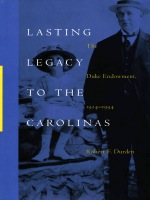 Lasting Legacy to the Carolinas: The Duke Endowment, 1924–1994
Robert F. Durden
Duke University Press, 1998 Like the majority of the founders of large philanthropic foundations in the United States, James B. Duke assumed that the Duke Endowment, which he established in 1924, would continue its charitable activity forever. Lasting Legacy to the Carolinas is an examination of the history of this foundation and the ways in which it has—and has not—followed Duke’s original design. In this volume, Robert F. Durden explores how the propriety of linking together a tax-free foundation and an investor-owned, profit-seeking business like the Duke Power Company has significantly changed over the course of the century. Explaining the implications of the Tax Reform Act of 1969 for J. B. Duke’s dream, Durden shows how the philanthropist’s plan to have the Duke Endowment virtually own and ultimately control Duke Power (which, in turn, would supply most of the Endowment’s income) dissolved after the death of daughter Doris Duke in 1993, when the trustees of the Endowment finally had the unanimous votes needed to sever that tie. Although the Endowment’s philanthropic projects—higher education (including Duke University), hospitals and health care, orphan and child care in both North and South Carolina, and the rural Methodist church in North Carolina—continue to be served, this study explains the impact of a century of political and social change on one man’s innovative charitable intentions. It is also a testimony to the many staff members and trustees who have invested their own time and creative energies into further benefiting these causes, despite decades of inevitable challenges to the Endowment. This third volume of Durden’s trilogy relating to the Dukes of Durham will inform not only those interested in the continuing legacy of this remarkable family but also those involved with philanthropic boards, charitable endowments, medical care, child-care institutions, the rural church, and higher education.
The Lasting Significance of Etty Hillesum's Writings
Klaas A.D. Smelik
Amsterdam University Press, 2019 The Lasting Significance of Etty Hillesum’s Writings contains the proceedings of the third international Etty Hillesum Conference, held in Middelburg in September 2018. It brings together the work of 33 experts from all over the world to shed new light on life, works, inspiration and vision of the Dutch Jewish writer Etty Hillesum (1914-1943), one of the victims of the Nazi regime. Hillesum’s diaries and letters illustrate her heroic struggle to come to terms with her personal life in the context of the Holocaust. This volume revives Hillesum research with a comprehensive rereading of her texts but also by introducing new sources about her life. With the current rise of interest in peace studies, Judaism, the Holocaust, inter-religious dialogue, gender studies and mysticism, this book will be invaluable to students and scholars in a range of disciplines.
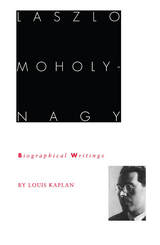 Laszlo Moholy-Nagy: Biographical Writings
Louis Kaplan
Duke University Press, 1995 Marking the centenary of the birth of Laszlo Moholy-Nagy (1895–1946), this book offers a new approach to the Bauhaus artist and theorist’s multifaceted life and work—an approach that redefines the very idea of biographical writing.
In Laszlo Moholy-Nagy, Louis Kaplan applies the Derridean deconstructivist model of the "signature effect" to an intellectual biography of a Constructivist artist. Inhabiting the borderline between life and work, the book demonstrates how the signature inscribed by "Moholy" operates in a double space, interweaving signified object and signifying matter, autobiography and auto-graphy. Through interpretative readings of over twenty key artistic and photographic works, Kaplan graphically illustrates Moholy’s signature effect in action. He shows how this effect plays itself out in the complex of relations between artistic originality and plagiarism, between authorial identity and anonymity, as well as in the problematic status of the work of art in the age of technical reproduction. In this way, the book reveals how Moholy’s artistic practice anticipates many of the issues of postmodernist debate and thus has particular relevance today. Consequently, Kaplan clarifies the relationship between avant-garde Constructivism and contemporary deconstruction.
This new and innovative configuration of biography catalyzed by the life writing of Moholy-Nagy will be of critical interest to artists and writers, literary theorists, and art historians.
Late Antiquity
Peter Brown
Harvard University Press, 1998 In this history of the late antique period, which appeared earlier in the five-volume series A History of Private Life, Peter Brown shows the slow shift from one form of public community to another--from the ancient city to the Christian church. In the four centuries between Marcus Aurelius (161-180) and Justinian (527-565), the Mediterranean world passed through a series of profound transmutations that affected the rhythms of life, the moral sensibilities, and the sense of the self of the inhabitants of its cities, and of the countryside around them.
 Late Antiquity: A Guide to the Postclassical World
G. W. Bowersock
Harvard University Press, 1999 The first book of its kind, this richly informative and comprehensive guide to the world of late antiquity offers the latest scholarship to the researcher along with great reading pleasure to the browser. In eleven comprehensive essays and in over 500 encyclopedic entries, an international cast of experts provides essential information and fresh perspectives on the history and culture of an era marked by the rise of two world religions, unprecedented political upheavals that remade the map of the known world, and the creation of art of enduring glory.
By extending the commonly accepted chronological and territorial boundaries of the period--to encompass Roman, Byzantine, Sassanian, and early Islamic cultures, from the middle of the third century to the end of the eighth--this guide makes new connections and permits revealing comparisons. Consult the article on "Angels" and discover their meaning in Islamic as well as classical and Judeo-Christian traditions. Refer to "Children," "Concubinage," and "Divorce" for a fascinating interweaving of information on the family. Read the essay on "Barbarians and Ethnicity" and see how a topic as current as the construction of identity played out in earlier times, from the Greeks and Romans to the Turks, Huns, and Saxons. Turn to "Empire Building" to learn how the empire of Constantine was supported by architecture and ceremony.
Or follow your own path through the broad range of entries on politics, manufacturing and commerce, the arts, philosophy, religion, geography, ethnicity, and domestic life. Each entry introduces readers to another facet of the postclassical world: historic figures and places, institutions, burial customs, food, money, public life, and amusements. A splendid selection of illustrations enhances the portrait.
The intriguing era of late antiquity emerges completely and clearly, viewed in a new light, in a guide that will be relished by scholars and general readers alike.
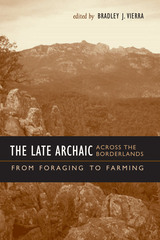 The Late Archaic across the Borderlands: From Foraging to Farming
Edited by Bradley J. Vierra
University of Texas Press, 2005 Why and when human societies shifted from nomadic hunting and gathering to settled agriculture engages the interest of scholars around the world. One of the most fruitful areas in which to study this issue is the North American Southwest, where Late Archaic inhabitants of the Sonoran and Chihuahuan Deserts of Mexico, Arizona, and New Mexico turned to farming while their counterparts in Trans-Pecos and South Texas continued to forage. By investigating the environmental, biological, and cultural factors that led to these differing patterns of development, we can identify some of the necessary conditions for the rise of agriculture and the corresponding evolution of village life. The twelve papers in this volume synthesize previous and ongoing research and offer new theoretical models to provide the most up-to-date picture of life during the Late Archaic (from 3,000 to 1,500 years ago) across the entire North American Borderlands. Some of the papers focus on specific research topics such as stone tool technology and mobility patterns. Others study the development of agriculture across whole regions within the Borderlands. The two concluding papers trace pan-regional patterns in the adoption of farming and also link them to the growth of agriculture in other parts of the world.
Late Bresson and the Visual Arts: Cinema, Painting and Avant-Garde Experiment
Raymond Watkins
Amsterdam University Press, 2019 Critics have largely neglected the colour films of French film director Robert Bresson (1901—99). To correct that oversight, this study presents a revised and revitalised Bresson, comparing his style to innovations in abstract painting after World War II, exploring his affinities with such avant-garde traditions as surrealism, constructivism, and minimalism, and illustrating how his embodied style leads to a complex form of intermediality. Through that analysis, Raymond Watkins shows clearly that Bresson still has a good deal to teach us about cinema’s distinctive ability to draw on painting, photography, sculpture, and the plastic arts in general.
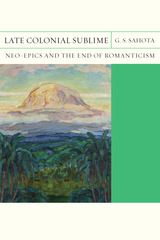 Late Colonial Sublime: Neo-Epics and the End of Romanticism
G. S. Sahota
Northwestern University Press, 2018 Taking cues from Walter Benjamin’s fragmentary writings on literary-historical method, Late Colonial Sublime reconstellates the dialectic of Enlightenment across a wide imperial geography, with special focus on the fashioning of neo-epics in Hindi and Urdu literary cultures in British India. Working through the limits of both Marxism and postcolonial critique, this book forges an innovative approach to the question of late romanticism and grounds categories such as the sublime within the dynamic of commodification. While G. S. Sahota takes canonical European critics such as Theodor Adorno and Max Horkheimer to the outskirts of empire, he reads Indian writers such as Muhammad Iqbal and Jayashankar Prasad in light of the expansion of instrumental rationality and the neotraditional critiques of the West it spurred at the onset of decolonization.
By bringing together distinct literary canons—both metropolitan and colonial, hegemonic and subaltern, Western and Eastern, all of which took shape upon the common realities of imperial capitalism—Late Colonial Sublime takes an original dialectical approach. It experiments with fragments, parallaxes, and constellational form to explore the aporias of modernity as well as the possible futures they may signal in our midst. A bold intervention into contemporary debates that synthesizes a wealth of sources, this book will interest readers and scholars in world literature, critical theory, postcolonial criticism, and South Asian studies.
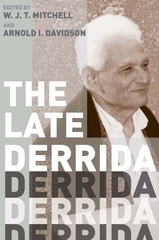 The Late Derrida
Edited by W. J. T. Mitchell and Arnold I. Davidson
University of Chicago Press, 2007 The rubric “The Late Derrida,” with all puns and ambiguities cheerfully intended, points to the late work of Jacques Derrida, the vast outpouring of new writing by and about him in the period roughly from 1994 to 2004. In this period Derrida published more than he had produced during his entire career up to that point. At the same time, this volume deconstructs the whole question of lateness and the usefulness of periodization. It calls into question the “fact” of his turn to politics, law, and ethics and highlights continuities throughout his oeuvre.
The scholars included here write of their understandings of Derrida’s newest work and how it impacts their earlier understandings of such classic texts as Glas and Of Grammatology. Some have been closely associated with Derrida since the beginning—both in France and in the United States—but none are Derrideans. That is, this volume is a work of critique and a deep and continued engagement with the thought of one of the most significant philosophers of our time. It represents a recognition that Derrida’s work has yet to be addressed—and perhaps can never be addressed—in its totality.
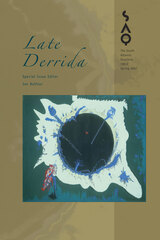 Late Derrida, Volume 106
Ian Balfour , ed.
Duke University Press This special issue of SAQ commemorates and interrogates—with varying measures of appreciation and critique—the late work of the philosopher Jacques Derrida. Resisting simple memorialization of Derrida since his death in 2004, this collection contends that the late work of this prolific theorist remains to be better understood. The contributors explore the peculiar intensity—a combined sense of both patience and urgency—that characterizes Derrida’s late writing, suggestive, among other things, of his preoccupation with mortality, of time running out, and of so many pressing things to be done. The essays address a wide array of Derrida’s concerns: human rights, justice, religion, the performative, “the gift of death,” mourning, and sovereignty. They often put Derrida’s texts in conjunction with the works of others—Wordsworth, Agamben, Schelling, and Benjamin, to name a few—that resonate with and on occasion resist Derrida’s own thinking and writing. One essay offers a reading of Wordsworth’s elegy “Distressful gift!” as a dialogue with questions posed by Derrida, using as its frame the kind of nonnormative mourning that Derrida advocated, together with a haunting analysis of the character of survival. Other essays look at Derrida’s theory of performativity as advanced in his late works, continuing his emphasis on the power of language, and in general they emulate his vigilance in attending to force and violence everywhere. Contributors. Ian Balfour, David L. Clark, Mary Jacobus, David E. Johnson, David Lloyd, J. Hillis Miller, Marc Redfield, Rei Terada, Elisabeth Weber
Late Empire
David Wojahn
University of Pittsburgh Press, 1994 Late Empire, David Wojahn’s most wide-ranging collection of poetry, affirms his status as one of the most compelling and original voices of his generation. In these poems, private history and public history mingle and merge in a way that is by turns deeply personal and elegiac. Centered around tow masterful elegies for the writers parents, the poems also treat an array of subjects familiar to us from news events but rarely examined by contemporary poetry.
 Late Enlightenment: Emergence of the Modern 'National Idea'
Marius Turda
Central European University Press, 2006 This volume represents the first in a four-volume series, a daring project by CEU Press which presents the most important texts that triggered and shaped the processes of nation-building in the many countries of Central and Southeast Europe. The series brings together scholars from Austria, Albania, Bosnia-Herzegovina, Bulgaria, Croatia, the Czech Republic, Greece, Hungary, the Republic of Macedonia, Poland, Romania, Serbia and Montenegro, Slovakia, Slovenia and Turkey. The editors have created a new interpretative synthesis that challenges the self-centered and "isolationist" historical narratives and educational canons prevalent in the region, in the spirit of of "coming to terms with the past." The main aim of the venture is to confront 'mainstream' and seemingly successful national discourses with each other, thus creating a space for analyzing those narratives of identity which became institutionalized as "national canons." The series will broaden the field of possible comparisons of the respective national cultures.
Late Fire, Late Snow: New and Uncollected Poems
Robert Francis
University of Massachusetts Press, 1992 The poems offered here were gathered from what Robert Francis wrote in the last decade of his life and from earlier work not available either in his seven previous books or his Collected Poems, 1936-1976. While aging is a recurring theme, the later poems converse with the earlier ones in an engaging mixture of subject and tone, mingling the pastoral with the political, the contemplative with the Chaplinesque. Recipient of the Shelly Memorial Award, Prix de Rome, and Academy of American Poets Fellowship, Francis lived in Amherst, Massachusetts, until his death in 1987 at age eighty-five.
 The Late Great Johnny Ace and the Transition from R&B to Rock 'n' Roll
James M. Salem
University of Illinois Press, 1999 Johnny Ace's crooning style and stirring ballads made him the first postwar African American artist to cross over to a white audience. After a string of R&B hits, Ace released the million-selling "Pledging My Love," a song headed to the top of the charts when the singer accidentally shot himself in his dressing room between sets at a show. James M. Salem captures the enigmatic, captivating, and influential R&B legend. Venturing from raucous Beale Street to Houston's vibrant Fourth Ward, Salem places Johnny Ace within a multifaceted world of postwar rhythm and blues that included B. B. King, Johnny Otis, Big Mama Thornton, and Gatemouth Brown. Salem also examines how entrepreneur Don D. Robey and his wife Evelyn Johnson promoted Ace to the top of the charts. Yet fame, as always, had a price. Ace's tours on the Chitlin' Circuit meant endless one-night stands and a grueling schedule that kept him on the road 340 days per year. Comprehensive and filled with anecdotes, The Late Great Johnny Ace and the Transition from R&B to Rock 'n' Roll tells the story of the star who fused black and white styles and changed American popular music forever.
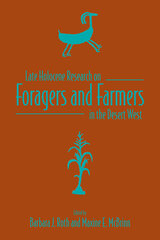 Late Holocene Research on Foragers and Farmers in the Desert West
Barbara J. Roth and Maxine E. McBrinn
University of Utah Press, 2015 This book brings together the work of archaeologists investigating prehistoric hunter-gatherers (foragers) and early farmers in both the Southwest and the Great Basin. Most previous work on this topic has been regionally specific, with researchers from each area favoring a different theoretical approach and little shared dialogue. Here the studies of archaeologists working in both the Southwest and the Great Basin are presented side by side to illustrate the similarities in environmental challenges and cultural practices of the prehistoric peoples who lived in these areas and to explore common research questions addressed by both regions.
Three main themes link these papers: the role of the environment in shaping prehistoric behavior, flexibility in foraging and farming adaptations, and diversity in settlement strategies. Contributors cover a range of topics including the varied ways hunter-gatherers adapted to arid environments, the transition from hunting and gathering to farming and the reasons for it, the variation in early farmers across the Southwest and Great Basin, and the differing paths followed as they developed settled villages.
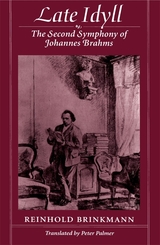 Late Idyll: The Second Symphony of Johannes Brahms
Reinhold Brinkmann
Harvard University Press Though central to our concert and recording repertory, and crucial to the history of the symphony, the four symphonies of Johannes Brahms have proved surprisingly resistant to critical analysis. In this brief, elegant book, a premier musicologist conducts us through the Second Symphony to show us what is unique and remarkable about this particular work and what it reveals about the composer and his time.
Reinhold Brinkmann guides us through the symphony movement by movement, examining musical ideas in all their compositional facets and placing them in the context of major trends in the intellectual history of late nineteenth-century Europe. He delineates connections between this symphony and the composer's other works and traces its relation to the music of Brahms's predecessors, particularly Beethoven. The product of a long and deep engagement with the music of Brahms, Late Idyll captures the spirit of the composer, probes the impulses behind his revisions of the original manuscript, and explores the meaning of the disparity between the first two movements of the symphony and the last. The result is a penetrating reading of a perplexing and important composition, clearly placed within its biographical, historical, and artistic context. It will engage and enlighten students and concertgoers alike.
Late Intermediate Occupation at Cerro Azul, Perú, A Preliminary Report
Joyce Marcus
University of Michigan Press, 1987 Cerro Azul was a late prehistoric fishing community on the south-central coast of Peru. It was one of several communities that belonged to the region of Huarco before falling to the Inca. This volume is the preliminary report of an interdisciplinary project carried out at the site from 1982 to 1986. The remains of many buildings exist on the site. During this project, crews excavated four of these, as well as middens and burials.
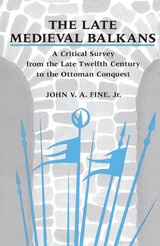 The Late Medieval Balkans: A Critical Survey from the Late Twelfth Century to the Ottoman Conquest
John V. A. Fine
University of Michigan Press, 1994 "Any further advances in scholarship on the late medieval Balkans will have to begin with this book."
---George Majeska, University of Maryland The Late Medieval Balkans is the first comprehensive examination of the events of the late medieval Balkan history---events that were as important as they were fascinating. The period that John Fine examines was an era of significant demographic, political, and religious change in the region. During this time, native populations were supplemented or replaced by the Bulgars and various Slavic tribes, who were to become the Bulgarians, Serbs, and Croats---ethnic identities whose historical conflicts have persisted to this day. The Late Medieval Balkans is an important source for those who wish to expand their knowledge of this turbulent period and who wish to broaden their understanding of the region. John V. A. Fine, Jr., is Professor of History, University of Michigan.
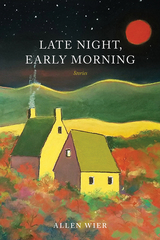 Late Night, Early Morning: Stories
Allen Wier
University of Tennessee Press, 2017 “This is a powerful, evocative book filled with the contradictions of loving things you will one day have to leave behind: a place, a person, a mood, a memory, a word. It is full of all things that we look for and return to in our literature: subtle fire, poignant humor, clear-eyed sadness, and layered love.”—Scott Blackwood
While Allen Wier is perhaps best known as a prizewinning novelist, he is also a master of the short story, an art he has perfected over four decades. Late Night, Early Morning contains twenty-two of Wier’s tales: the stories in his first collection (Things About to Disappear), six uncollected stories, and seven stories that became part of his four novels. Richly textured and often lyrical, with intense images and diverse subjects, these stories feature indelible characters who imprint themselves onto readers’ minds. A man with no family finds the abandoned corpse of an infant and adopts the dead baby as his son. A Texas laborer, while repairing hen houses, learns that the stench of the egg ranch is the smell of money. In 1862 Louisiana, a runaway slave comes face to face with a white sharecropper’s wife who may turn him in, but something unexpected momentarily unites them. An American widow in Mexico as a photographer meets a florist from Texas who widens her angle of view. After discovering an underground cavern, a man lives his entire life in an imagined world shaped from stalactites and stalagmites.
Allen Wier’s skillfully written and compassionate stories reveal the shimmering moments in day-to-day life
Allen Wier has received an NEA grant, Guggenheim and Dobie-Paisano Fellowships, the Fellowship of Southern Writers’ Robert Penn Warren Award, and the John Dos Passos Prize for Literature. He’s taught at Carnegie-Mellon, Hollins, the University of Alabama, University of New Orleans’s Edinburg Workshop, Florida International, the University of Texas, and the University of Tennessee. Currently the visiting writer at Murray State University, Allen Wier lives with his artist wife, Donnie, overlooking Lake Guntersville in Alabama.
Late Prehistoric Bison Procurement in Southeastern New Mexico: The 1978 Season at the Garnsey Site (LA-18399)
John D. Speth and William J. Parry
University of Michigan Press, 1980 The Garnsey site is a late prehistoric-protohistoric bison kill site in southeastern New Mexico. During the 1978 excavation, the crew clarified the stratigraphy and chronology of the site and increased the number of bison remains. In this data-rich monograph, the authors present the results of their fieldwork and analyze their findings. In addition to bison remains, researchers found lithics, ceramics, and fire-cracked rock.
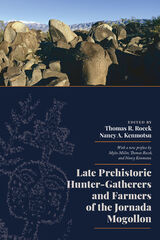 Late Prehistoric Hunter-Gatherers and Farmers of the Jornada Mogollon
Thomas R. Rocek
University Press of Colorado, 2023 Often seen as geographically marginal and of limited research interest to archaeologists, the Jornada Mogollon region of the southwestern United States and northern Mexico deserves broader attention. Late Prehistoric Hunter-Gatherers and Farmers of the Jornada Mogollon presents the major issues being addressed in Jornada research and reveals the complex, dynamic nature of Jornada prehistory.
The Jornada branch of the Mogollon culture and its inhabitants played a significant economic, political, and social role at multiple scales. This volume draws together results from recent large-scale CRM work that has amassed among the largest data sets in the Southwest with up-to-date chronological, architectural, faunal, ceramic, obsidian sourcing, and other specialized studies. Chapters by some of the most active researchers in the area address topics that reach beyond the American Southwest, such as mobility, forager adaptations, the transition to farming, responses to environmental challenges, and patterns of social interaction.
Late Prehistoric Hunter-Gatherers and Farmers of the Jornada Mogollon is an up-to-date summary of the major developments in the region and their implications for Southwest archaeology in particular and anthropological archaeological research more generally.
The publication of this book is supported in part by the Arizona Archaeological and Historical Society and the Center for Material Culture Studies at the University of Delaware.
Contributors: Rafael Cruz Antillón, Douglas H. M. Boggess, Peter C. Condon, Linda Scott Cummings, Moira Ernst, Tim Graves, David V. Hill, Nancy A. Kenmotsu, Shaun M. Lynch, Arthur C. MacWilliams, Mary Malainey, Timothy D. Maxwell, Myles R. Miller, John Montgomery, Jim A. Railey, Thomas R. Rocek, Matt Swanson, Christopher A. Turnbow, Javier Vasquez, Regge N. Wiseman, Chad L. Yost
Late Psalm
Betshy Sholl
University of Wisconsin Press, 2004 Late Psalm takes themes from those ancient songs of joy and grief and transposes them into the language of contemporary life.
 Late Quaternary Environments of the United States: Volume 2
H.E. Wright Jr., Editor
University of Minnesota Press, 1983 Late Quaternary Environments of the United States was first published in 1983. Minnesota Archive Editions uses digital technology to make long-unavailable books once again accessible, and are published unaltered from the original University of Minnesota Press editions. In the late 1970s American and Russian scientists met twice in conferences on Quaternary paleoclimates sponsored by the U.S.-U.S.S.R. Bilateral Agreement on the Environment. The conferees agreed to prepare volumes summarizing the current status of research in the two countries. Late-Quaternary Environments of the United States provides a two-volume overview of new and significant information on research of the last fifteen years, since the 1965 publication of Quaternary of the United States,edited by H E. Wright, Jr., and D. G. Frey. The volume on the late Quaternary in the Soviet Union will also be published by the University of Minnesota Press. Volume 1 of Late-Quaternary Environments of the United States covers the Late Pleistocene, the interval between 25,000 and 10,000 years ago—a time of extreme environmental stress as the world passed from full-glacial conditions of the last ice age into the present interglacial age. The interval of geologic time since the last glacial period—termed the Holocene—is the subject of Volume 2. The complexity of the natural changes occurring in the late Quaternary, and their interrelationships, make it impossible for a single scientific discipline to encompass them. Thus the papers in both volumes come from authors in many research fields—geology, ecology, physical geography, archaeology, geochemistry, geophysics, limnology, soil science, paleontology, and climatology. Many of the hypotheses presented—especially on the dynamic Late Pleistocene environments—are still hotly debated and will require additional testing as scientists strive to reconstruct the changing world of the glacial and postglacial ages.
Late Rapturous
Frank X. Gaspar
Autumn House Press, 2012 In his fifth poetry collection, Gaspar's poems are spacious and awake, in touch with faith and anxiety, and unafraid to wander. These poems are multi-layered with Judeo-Christian allusions and metaphysical images of faith.
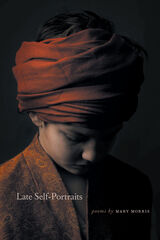 Late Self-Portraits
Mary Morris
Michigan State University Press, 2022 A compelling collection of poems, Late Self-Portraits conveys an intimate description of lives through a collage of portraits and affliction. Weaving history and the sacred, both intimate and worldly, one encounters a blind Jorge Luis Borges with his mother, a glass confessional in the of Notre Dame Cathedral, Frida Kahlo in Mexico, ghosts, a neurosurgeon’s prognosis, and Marie Laveau in New Orleans. Whether in a field with Joan of Arc, encountering the artist Jean-Michel Basquiat, or having dinner with Hades, these are haunting poems of loss and unearthing, equally bold, personal, and tender.
From “Dinner with Hades”:
He shows me a birthday cake, candled. My name is written in pomegranate
seeds. It’s like vertigo. Just before he seeks to devour, he halts to birdsong—
sound of goldfinch, bluebird, hawk, lilting of sparrows. Of whippoorwill
and dove. Wings flap, so many wings, a cool breeze as leaves unfurl into a
once forgotten green and I am back on earth, held in my mother’s arms.
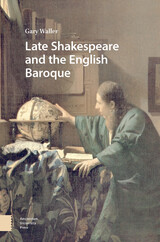 Late Shakespeare and the English Baroque
Gary Waller
Amsterdam University Press, 2024 Late Shakespeare and the English Baroque focuses mainly on Shakespeare’s late (or later) works, those written from around 1607. It sets both poetry and plays within the emerging culture of the baroque, the term defined not merely by stylistic features but by the underlying ideological ‘structure of feeling’ of baroque culture in early modern England. The book extends the mode of analysis of The Female Baroque (Amsterdam University Press, 2020) and draws on theoretical work by José Antonio Maravall, Raymond Williams, and Julia Kristeva. It analyzes recurring Baroque characteristics – hyperbole and melancholy, theatricality, gender, and ‘plateauing’. Attention is given to the sonnets and other poems, as well as the tragedies from Hamlet on, and argues that increasingly, tragi-comedy emerges as a distinctively baroque Shakespearean characteristic. In the final chapter, primarily on The Tempest, the late Shakespeare is shown to have philosophical insights parallel to Montaigne or Bruno, and to provide anticipatory connections with later baroque artists like Vermeer.
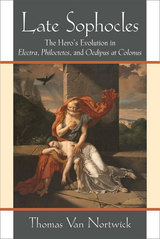 Late Sophocles: The Hero’s Evolution in Electra, Philoctetes, and Oedipus at Colonus
Thomas Van Nortwick
University of Michigan Press, 2015 Only a few plays by Sophocles—one of the great tragic playwrights from Classical Athens—have survived, and each of them dramatizes events from the rich store of myths that framed literature and art. Sophocles’ treatment evokes issues that were vividly contemporary for Athenian audiences of the Periclean age: How could the Athenians incorporate older, aristocratic ideas about human excellence into their new democratic society? Could citizens learn to be morally excellent, or were these qualities only inherited? What did it mean to be a creature who knows that he or she must die? Late Sophocles traces the evolution of the Sophoclean hero through the final three plays, Electra, Philoctetes, and Oedipus at Colonus. The book’s main thesis, that Sophocles reimagined the nature of the tragic hero in his last three works, is developed inductively through readings of the plays. This balanced approach, in which a detailed argument about the plays is offered in a format accessible to nonspecialists, is unusual—perhaps unique—in contemporary Classical scholarship on Sophocles. This book will appeal to nonspecialist readers of serious literature as well as scholars of classical and other literatures. While including ample guidance for those not familiar with the plays, Late Sophocles goes beyond a generalized description of “what happens” in the plays to offer a clear, jargon-free argument for the enduring importance of Sophocles’ plays. The argument’s implications for longstanding interpretational issues will be of interest to specialists. All Greek is translated.
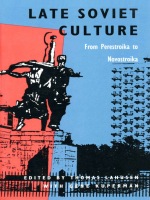 Late Soviet Culture from Perestroika to Novostroika
Thomas Lahusen, with Gene Kuperman, ed.
Duke University Press, 1993 As the Soviet Union dissolved, so did the visions of past and future that informed Soviet culture. With Dystopia left behind and Utopia forsaken, where do the writers, artists, and critics who once inhabited them stand? In an "advancing present," answers editor Thomas Lahusen. Just what that present might be--in literature and film, criticism and theory, philosophy and psychoanalysis, and in the politics that somehow speaks to all of these—is the subject of this collection of essays. Leading scholars from the former Soviet Union and the West gather here to consider the fate of the people and institutions that constituted Soviet culture. Whether the speculative glance goes back (to czarist Russia or Soviet Freudianism, to the history of aesthetics or the sociology of cinema in the 1930s) or forward (to the "market Stalinism" one writer predicts or the "open text of history" another advocates), a sense of immediacy, or history-in-the-making animates this volume. Will social and cultural institutions now develop organically, the authors ask, or is the society faced with the prospect of even more radical reforms? Does the present rupture mark the real moment of Russia's encounter with modernity? The options explored by literary historians, film scholars, novelists, and political scientists make this book a heady tour of cultural possibilities. An expanded version of a special issue of South Atlantic Quarterly (Spring 1991), with seven new essays, Late Soviet Culture will stimulate scholar and general reader alike. Contributors. Katerina Clark, Paul Debreczeny, Evgeny Dobrenko, Mikhail Epstein, Renata Galtseva, Helena Goscilo, Michael Holquist, Boris Kagarlitsky, Mikhail Kuraev, Thomas Lahusen, Valery Leibin, Sidney Monas, Valery Podoroga, Donald Raleigh, Irina Rodnyanskaya, Maya Turovskaya
Late Spring: A Translation of Theocritus
Henry Harmon Chamberlin
Harvard University Press Throughout the poems of Theocritus there breathes the freshness of a spring morning, but it was a very late spring. His times were much like our own, marked by the turmoil of great cities, the invigorating quiet of the country side, the industry, the commerce, the wars and rumors of war, the spirit of unrest, the shifting of old ideals and beliefs, the pathos of the individual who finds himself confronted with a strange world. His interpretation of this varied scene gives to his poems a more modern tone than that possessed by much of our own contemporary poetry. To make the present-day reader comprehend this fact and all it implies, has been the translator’s task in this version. Henry Chamberlin has succeeded; he has taken Theocritus out of the shadow of academic tradition and placed him in the tingling sunlight of modern life.
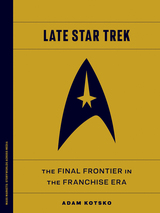 Late Star Trek: The Final Frontier in the Franchise Era
Adam Kotsko
University of Minnesota Press, 2025 How Star Trek’s twenty-first-century reinventions illuminate the unique challenges and opportunities of franchise-style corporate storytelling Late Star Trek explores the beloved science fiction franchise’s repeated attempts to reinvent itself after the end of its 1990s golden age. Beginning with the prequel series Enterprise, Adam Kotsko analyzes the wealth of content set within Star Trek’s sprawling continuity—including authorized books, the three “Kelvin Timeline” films, and the streaming series Discovery, Picard, Lower Decks, Prodigy, and Strange New Worlds—along with fan discourse, to reflect on the perils and promise of the franchise as a unique form of storytelling. Significantly including the licensed novels and comic books that fill out the Star Trek universe for its fans, Kotsko brings the multiple productions of the early twenty-first century together as a unified whole rather than analyzing them in their current stratified view. He argues that the variety of styles and approaches in this tumultuous era of Star Trek history provides the perfect opportunity to reflect on the nature of the franchise storyworlds that now dominate popular culture. By taking the spin-offs and tie-ins seriously as creative attempts to tell a new story within an established universe, Late Star Trek highlights creative triumphs as well as the tendency for franchise faithfulness to get in the way of creating engaging characters and ideas. Arguing forcefully against the prevailing consensus that franchises are a sign of cultural decay, Kotsko contends that the Star Trek universe exemplifies an approach to storytelling that has been perennial across cultures. Instead, he finds that what limits creativity within franchises is not their reliance on the familiar but their status as modern myths, held not as common cultural heritage but rather owned as corporate intellectual property. Retail e-book files for this title are screen-reader friendly with images accompanied by short alt text and/or extended descriptions.
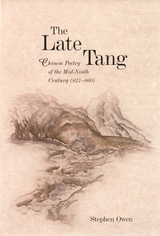 The Late Tang: Chinese Poetry of the Mid-Ninth Century (827–860)
Stephen Owen
Harvard University Press, 2006 The poetry of the Late Tang often looked backward, and many poets of the period distinguished themselves through the intensity of their retrospective gaze. Chinese poets had always looked backward to some degree, but for many Late Tang poets the echoes and the traces of the past had a singular aura.
In this work, Stephen Owen resumes telling the literary history of the Tang that he began in his works on the Early and High Tang. Focusing in particular on Du Mu, Li Shangyin, and Wen Tingyun, he analyzes the redirection of poetry that followed the deaths of the major poets of the High and Mid-Tang and the rejection of their poetic styles. The Late Tang, Owen argues, forces us to change our very notion of the history of poetry. Poets had always drawn on past poetry, but in the Late Tang, the poetic past was beginning to assume the form it would have for the next millennium; it was becoming a repertoire of available choices—styles, genres, the voices of past poets. It was this repertoire that would endure.
Late Woodland Cultures of Southeastern Michigan
James E. Fitting
University of Michigan Press, 1965 James E. Fitting provides an overview of archaeological material from sites in southeastern Michigan. His primary focus is the Riviere au Vase site (also called the Graham site, the Greene School site, and the Mud Creek site), in Macomb County, which was excavated by Emerson Greenman and others in 1936 and 1937. At this Woodland site, the investigators found burials, ceramic and lithic artifacts, and faunal remains. Fitting also writes about the Fuller sites and the Verchave sites.
Late-career Risks in Changing Welfare States: Comparing Germany and the United States since the 1980s
Jan Paul Heisig
Amsterdam University Press, 2015 Motivated by ongoing debates over welfare state retrenchment and growing economic insecurity, this book compares the situation of older workers in Germany and the United States over the past three decades. Both nations are seeing a rise in insecurity for older workers, but the differences in support programs, pensions, and retirement options have led to differing outcomes for workers faced with early retirement or job loss.
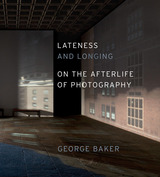 Lateness and Longing: On the Afterlife of Photography
George Baker
University of Chicago Press, 2023 How a generation of women artists is transforming photography with analogue techniques.
Beginning in the 1990s, a series of major artists imagined the expansion of photography, intensifying its ideas and effects while abandoning many of its former medium constraints. Simultaneous with this development in contemporary art, however, photography was moving toward total digitalization.
Lateness and Longing presents the first account of a generation of artists—focused on the work of Zoe Leonard, Tacita Dean, Sharon Lockhart, and Moyra Davey—who have collectively transformed the practice of photography, using analogue technologies in a dissident way and radicalizing signifiers of older models of feminist art. All these artists have resisted the transition to the digital in their work. Instead—in what amounts to a series of feminist polemics—they return to earlier, incomplete, or unrealized moments in photography’s history, gravitating toward the analogue basis of photographic mediums. Their work announces that photography has become—not obsolete—but “late,” opened up by the potentially critical forces of anachronism.
Through a strategy of return—of refusing to let go—the work of these artists proposes an afterlife and survival of the photographic in contemporary art, a formal lateness wherein photography finds its way forward through resistance to the contemporary itself.
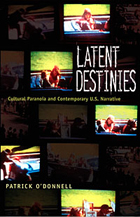 Latent Destinies: Cultural Paranoia and Contemporary U.S. Narrative
Patrick O Donnell
Duke University Press, 2000 Latent Destinies examines the formation of postmodern sensibilities and their relationship to varieties of paranoia that have been seen as widespread in this century. Despite the fact that the Cold War has ended and the threat of nuclear annihilation has been dramatically lessened by most estimates, the paranoia that has characterized the period has not gone away. Indeed, it is as if—as O’Donnell suggests—this paranoia has been internalized, scattered, and reiterated at a multitude of sites: Oklahoma City, Waco, Ruby Ridge, Bosnia, the White House, the United Nations, and numerous other places.
O’Donnell argues that paranoia on the broadly cultural level is essentially a narrative process in which history and postmodern identity are negotiated simultaneously. The result is an erasure of historical temporality—the past and future become the all-consuming, self-aware present. To explain and exemplify this, O’Donnell looks at such books and films as Libra, JFK, The Crying of Lot 49, The Truman Show, Reservoir Dogs, Empire of the Senseless, Oswald’s Tale, The Executioner’s Song, Underworld, The Killer Inside Me, and Groundhog Day. Organized around the topics of nationalism, gender, criminality, and construction of history, Latent Destinies establishes cultural paranoia as consonant with our contradictory need for multiplicity and certainty, for openness and secrecy, and for mobility and historical stability.
Demonstrating how imaginative works of novels and films can be used to understand the postmodern historical condition, this book will interest students and scholars of American literature and cultural studies, postmodern theory, and film studies.
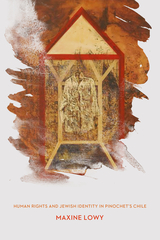 Latent Memory: Human Rights and Jewish Identity in Chile
Maxine Lowy
University of Wisconsin Press, 2022 In the first half of the twentieth century, Jewish immigrants and refugees sought to rebuild their lives in Chile. Despite their personal histories of marginalization in Europe, many of these people or their descendants did not take a stand against the 1973 military coup, nor the political persecution that followed. Chilean Jews' collective failure to repudiate systematic human rights violations and their tacit support for the military dictatorship reflected a complicated moral calculus that weighed expediency over ethical considerations and ignored individual acts of moral courage.
Maxine Lowy draws upon hundreds of first-person testimonials and archival resources to explore Chilean Jewish identity in the wake of Pinochet's coup, exposing the complex and sometimes contradictory development of collective traumatic memory and political sensibilities in an oppressive new context. Latent Memory points to processes of community gestures of moral reparation and signals the pathways to justice and healing associated with Shoah and the Jewish experience. Lowy asks how individuals and institutions may overcome fear, indifference, and convenience to take a stand even under intense political duress, posing questions applicable to any nation emerging from state repression.
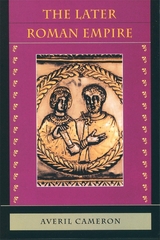 The Later Roman Empire: AD 284–430
Averil Cameron
Harvard University Press, 1993 Marked by the shift of power from Rome to Constantinople and the Christianization of the Empire, this pivotal era requires a narrative and interpretative history of its own. Averil Cameron, an authority on later Roman and early Byzantine history and culture, captures the vigor and variety of the fourth century, doing full justice to the enormous explosion of recent scholarship.
After a hundred years of political turmoil, civil war, and invasion, the Roman Empire that Diocletian inherited in AD 284 desperately needed the radical restructuring he gave its government and defenses. His successor, Constantine, continued the revolution by adopting—for himself and the Empire—a vibrant new religion: Christianity. The fourth century is an era of wide cultural diversity, represented by figures as different as Julian the Apostate and St. Augustine. Cameron provides a vivid narrative of its events and explores central questions about the economy, social structure, urban life, and cultural multiplicity of the extended empire. Examining the transformation of the Roman world into a Christian culture, she takes note of the competition between Christianity and Neoplatonism. And she paints a lively picture of the new imperial city of Constantinople. By combining literary, artistic, and archaeological evidence. Cameron has produced an exciting record of social change. The Later Roman Empire is a compelling guide for anyone interested in the cultural development of late antiquity.
 Later Travels
Cyriac of AnconaEdited and translated by Edward W. Bodnarwith Clive Foss
Harvard University Press, 2003 Early Renaissance humanists discovered the culture of ancient Greece and Rome mostly through the study of classical manuscripts. Cyriac of Ancona (Ciriaco de' Pizzecolli, 1391-1452), a merchant and diplomat as well as a scholar, was among the first to study the physical remains of the ancient world in person and for that reason is sometimes regarded as the father of classical archaeology. His travel diaries and letters are filled with descriptions of classical sites, drawings of buildings and statues, and copies of hundreds of Latin and Greek inscriptions. Cyriac came to see it as his calling to record the current state of the remains of antiquity and to lobby with local authorities for their preservation, recognizing that archaeological evidence was an irreplaceable complement to the written record.
This volume presents letters and diaries from 1443 to 1449, the period of his final voyages, which took him from Italy to the eastern shore of the Adriatic, the Greek mainland, the Aegean islands, Anatolia and Thrace, Mount Athos, Constantinople, the Cyclades, and Crete. Cyriac's accounts of his travels, with their commentary reflecting his wide-ranging antiquarian, political, religious, and commercial interests, provide a fascinating record of the encounter of the Renaissance world with the legacy of classical antiquity. The Latin texts assembled for this edition have been newly edited and most of them appear here for the first time in English. The edition is enhanced with reproductions of Cyriac's sketches and a map of his travels.
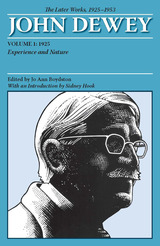 The Later Works of John Dewey, Volume 1, 1925 - 1953: 1925, Experience and Nature
John Dewey. Edited by Jo Ann Boydston
Southern Illinois University Press, 2008 John Dewey’s Experience and Nature has been considered the fullest expression of his mature philosophy since its eagerly awaited publication in 1925.Irwin Edman wrote at that time that “with monumental care, detail and completeness, Professor Dewey has in this volume revealed the metaphysical heart that beats its unvarying alert tempo through all his writings, whatever their explicit themes.” In his introduction to this volume, Sidney Hook points out that “Dewey’s Experience and Nature is both the most suggestive and most difficult of his writings.” The meticulously edited text published here as the first volume in the series The Later Works of John Dewey, 1925–1953spans that entire period in Dewey’s thought by including two important and previously unpublished documents from the book’s history: Dewey’s unfinished new introduction written between 1947and 1949,edited by the late Joseph Ratner, and Dewey’s unedited final draft of that introduction written the year before his death. In the intervening years Dewey realized the impossibility of making his use of the word “experience” understood. He wrote in his 1951draft for a new introduction: “Were I to write (or rewrite) Experience and Nature today I would entitle the book Culture and Nature and the treatment of specific subject-matters would be correspondingly modified. I would abandon the term ‘experience’ because of my growing realization that the historical obstacles which prevented understanding of my use of ‘experience’ are, for all practical purposes, insurmountable. I would substitute the term ‘culture’ because with its meanings as now firmly established it can fully and freely carry my philosophy of experience.”
The Later Works of John Dewey, Volume 10, 1925 - 1953: 1934, Art as Experience
John Dewey. Edited by Jo Ann Boydston
Southern Illinois University Press, 2008 Art as Experience evolved from John Dewey’s Willam James Lectures, delivered at Harvard University from February to May 1931. In his Introduction, Abraham Kaplan places Dewey’s philosophy of art within the context of his pragmatism. Kaplan demonstrates in Dewey’s esthetic theory his traditional “movement from a dualism to a monism” and discusses whether Dewey’s viewpoint is that of the artist, the respondent, or the critic.
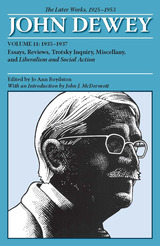 The Later Works of John Dewey, Volume 11, 1925 - 1953: Essays, Reviews, Trotsky Inquiry, Miscellany, and Liberalism and Social Action
John Dewey. Edited by Jo Ann Boydston
Southern Illinois University Press, 2008 This volume includes ninety-two items from 1935, 1936, and 1937, including Dewey’s 1935 Page-Barbour Lectures at the University of Virginia, published as Liberalism and Social Action. In essay after essay Dewey analyzed, criticized, and reevaluated liberalism. When his controversial Liberalism and Social Action appeared, asking whether it was still possible to be a liberal, Horace M. Kallen wrote that Dewey “restates in the language and under the conditions of his times what Jefferson’s Declaration of Independence affirmed in the language and under the conditions of his.” The diverse nature of the writings belies their underlying unity: some are technical philosophy; other philosophical articles shade into social and political themes; social and political issues permeate the educational articles, which in turn involve Dewey’s philosophical ideas.
The Later Works of John Dewey, Volume 12, 1925 - 1953: 1938, Logic: The Theory of Inquiry
John Dewey. Edited by Jo Ann Boydston
Southern Illinois University Press, 2008 Heralded as “the crowning work of a great career,” Logic: The Theory of Inquiry was widely reviewed. To Evander Bradley McGilvary, the work assured Dewey “a place among the world’s great logicians.”
William Gruen thought “No treatise on logic ever written has had as direct and vital an impact on social life as Dewey’s will have.” Paul Weiss called it “the source and inspiration of a new and powerful movement.” Irwin Edman said of it, “Most philosophers write postscripts; Dewey has made a program. His Logic is a new charter for liberal intelligence.” Ernest Nagel called the Logic an impressive work. Its unique virtue is to bring fresh illumination to its subject by stressing the roles logical principles and concepts have in achieving the objectives of scientific inquiry.”
The Later Works of John Dewey, Volume 13, 1925 - 1953: 1938-1939, Experience and Education, Freedom and Culture, Theory of Valuation, and Essays
John Dewey. Edited by Jo Ann Boydston
Southern Illinois University Press, 2008 This volume includes all Dewey’s writings for 1938 except for Logic: The Theory of Inquiry (Volume 12 of The Later Works), as well as his 1939 Freedom and Culture, Theory of Valuation, and two items from Intelligence in the Modern World. Freedom and Culture presents, as Steven M. Cahn points out, “the essence of his philosophical position: a commitment to a free society, critical intelligence, and the education required for their advance.”
The Later Works of John Dewey, Volume 14, 1925 - 1953: 1939 - 1941, Essays, Reviews, and Miscellany
John Dewey. Edited by Jo Ann Boydston
Southern Illinois University Press, 2008 This volume republishes forty-four essays, reviews, and miscellaneous pieces from 1939, 1940, and 1941. In his Introduction, R. W. Sleeper characterizes the contents of this volume as “vintage Dewey. Ranging widely over problems of theory and practice, they reveal him commencing his ninth decade at the peak of his intellectual powers.” “Nature in Experience,” Dewey’s reply to Morris R. Cohen and William Ernest Hocking, “is a model of clarity and responsiveness,” writes Sleeper, “perhaps his clearest statement of why it is that metaphysics does not play the fundamental role for him that it had regularly played for his predecessors.”
The Later Works of John Dewey, Volume 15, 1925 - 1953: 1942 - 1948, Essays, Reviews, and Miscellany
John Dewey. Edited by Jo Ann Boydston
Southern Illinois University Press, 2008 This volume republishes sixty-two of Dewey’s writings from the years 1942 to 1948; four other items are published here for the first time. A focal point of this volume is Dewey’s introduction to his collective volume Problems of Men. Exchanges in the Journal of Philosophy with Donald C. Mackay, Philip Blair Rice, and with Alexander Meiklejohn in Fortune appear here, along with Dewey’s letters to editors of various publications and his forewords to colleagues’ books. Because 1942 was the centenary of the birth of William James, four articles about James are also included in this volume.
The Later Works of John Dewey, Volume 16, 1925 - 1953: 1949 - 1952, Essays, Typescripts, and Knowing and the Known
John Dewey. Edited by Jo Ann Boydston
Southern Illinois University Press, 2008 Typescripts, essays, and an authoritative edition of Knowing and the Known, Dewey’s collaborative work with Arthur F. Bentley. In an illuminating Introduction T. Z. Lavine defines the collaboration's three goals—the "construction of a new language for behavioral inquiry," "a critique of formal logicians, in defense of Dewey’s Logic," and "a critique of logical positivism." In Dewey’s words: "Largely due to Bentley, I’ve finally got the nerve inside of me to do what I should have done years ago." "What Is It to Be a Linguistic Sign or Name?" and "Values, Valuations, and Social Facts,’ both written in 1945, are published here for the first time.
The Later Works of John Dewey, Volume 17, 1925 - 1953: 1885 - 1953, Miscellaneous Writings
John Dewey. Edited by Jo Ann Boydston
Southern Illinois University Press, 2008 This is the final textual volume in The Collected Works of John Dewey, 1882–1953, published in 3 series comprising 37 volumes: The Early Works, 1882–1898 (5 vols.); The Middle Works, 1899–1924 (15 vols.); The Later Works, 1925–1953 (17 vols.). Volume 17 contains Dewey’s writings discovered after publication of the appropriate volume of The Collected Works and spans most of Dewey’s publishing life. There are 83 items in this volume, 24 of which have not been previously published. Among works highlighted in this volume are 10 “Educational Lectures before Brigham Young Academy,” early essays “War’s Social Results” and “The Problem of Secondary Education after the War,” and the previously unpublished “The Russian School System.”
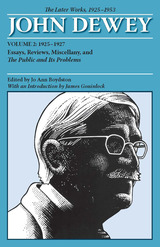 The Later Works of John Dewey, Volume 2, 1925 - 1953: 1925-1927, Essays, Reviews, Miscellany, and The Public and Its Problems
John Dewey. Edited by Jo Ann Boydston
Southern Illinois University Press, 2008 With the exception of Experience and Nature, (Volume 1 of the Later Works), this volume contains all of Dewey’s writings for 1925 and 1926, as well as his 1927 book, The Public and Its Problems. A Modern Language Association’s Committee on Scholarly Editions textual edition. The first essay in this volume, “The Development of American Pragmatism,” is perhaps Dewey’s best-known article of these years, emphasizing the uniquely American origins of his own philosophical innovations. Other essays focus on Dewey’s continuing investigation of the “nature of intelligent conduct,” as, for example, his debate with David Wight Prall on the underpinnings of value, his study of sense-perception, and his support for outlawing of war. Also appearing here are Dewey’s final articles on the culture of the developing world, written for the New Republic after his travels to China, Turkey, and Mexico.
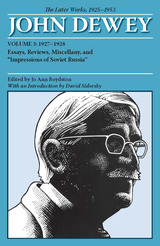 The Later Works of John Dewey, Volume 3, 1925 - 1953: 1927-1928, Essays, Reviews, Miscellany, and "Impressions of Soviet Russia"
John Dewey. Edited by Jo Ann Boydston
Southern Illinois University Press, 2008 All of Dewey’s writings for 1927 and 1928 with the exception of The Public and Its Problems, which appears in Volume 2, A Modern Language Association’s Committee on Scholarly Editions textual edition. These essays are, as Sidorsky says in his Introduction, “framed, in great measure, by those two poles of his philosophical interest: looking backward, in a sense, to the defense of naturalistic metaphysics and moving forward to the justification and to the implications for practice of an empirical theory.” Dewey’s five essays on education are evidence of his continued interest in that field. Among them is the frequently quoted “Why I Am a Member of the Teachers Union,” which is still used by the American Federation of Teachers in its recruiting efforts. Other highlights of this volume include the famous exchange between George Santayana and Dewey on Experience and Nature; an impassioned condemnation of the miscarriage of justice Dewey saw in the Sacco-Vanzetti trial; and a series of six articles on the Soviet Union based on Dewey’s trip to that country in 1928.
The Later Works of John Dewey, Volume 4, 1925 - 1953: 1929: The Quest for Certainty
John Dewey. Edited by Jo Ann Boydston
Southern Illinois University Press, 2008 This volume provides an authoritative edition of Dewey’s The Quest for Certainty: A Study of the Relation Between Knowledge and Action. The book is made up of the Gifford Lectures delivered April–May 1929 at the University of Edinburgh. Writing to Sidney Hook, Dewey described this work as “a criticism of philosophy as attempting to attain theoretical certainty.” In the Philosophical Review Max C. Otto later elaborated: “Mr. Dewey wanted, so far as lay in his power, to crumble into dust, once and for all, ‘the chief fortress of the classic philosophical tradition.”
The Later Works of John Dewey, Volume 5, 1925 - 1953: 1929-1930, Essays, The Sources of a Science of Education, Individualism, Old and New, and Construction and Criticism
John Dewey. Edited by Jo Ann Boydston
Southern Illinois University Press, 2008 With the exception of The Quest for Certainty (Volume 4) this fifth volume brings together Dewey’s writings for the 1929–1930 period. During this time Dewey published 4 books and 50 articles on philosophical, educational, political, and social issues. His philosophical essays include “What Humanism Means to Me” and “What I Believe,” both of which express Dewey’s faith in man’s potentialities and intelligence, and a lively Journal of Philosophy exchange with Ernest Nagel, William Ernest Hocking, C. I. Lewis, and F. J. E. Woodbridge. Educational writings include The Sources of a Science of Education. The contents of this volume reflect Dewey’s increasing involvement in social and political problems.
The Later Works of John Dewey, Volume 6, 1925 - 1953: 1931-1932, Essays, Reviews, and Miscellany
John Dewey. Edited by Jo Ann Boydston
Southern Illinois University Press, 2008 Except for Dewey’s and James H. Tufts’ 1932 Ethics (Volume 7 of The Later Works), this volume brings together Dewey’s writings for 1931–1932. The Great Depression presented John Dewey and the American people with a series of economic, political, and social crises in 1931 and 1932 that are reflected in most of the 86 items in this volume, even in philosophical essays such as “Human Nature.” As Sidney Ratner points out in his Introduction, Dewey’s interest in international peace is featured in the writings in this volume.
The Later Works of John Dewey, Volume 7, 1925 - 1953: 1932, Ethics
John Dewey. Edited by Jo Ann Boydston
Southern Illinois University Press, 2008 Introduction by Abraham Edel and Elizabeth Flower This seventh volume provides an authoritative edition of Dewey and James H. Tufts’ 1932 Ethics. Dewey and Tufts state that the book’s aim is: “To induce a habit of thoughtful consideration, of envisaging the full meaning and consequences of individual conduct and social policies,” insisting throughout that ethics must be constantly concerned with the changing problems of daily life.
The Later Works of John Dewey, Volume 8, 1925 - 1953: 1933, Essays and How We Think, Revised Edition
John Dewey. Edited by Jo Ann Boydston
Southern Illinois University Press, 2008 This volume also includes a collection of essays entitled The Educational Frontier, Dewey’s articles on logic, the outlawry of war, and philosophy for the Encyclopedia of the Social Sciences, and his reviews of Alfred North Whitehead’s Adventures of Ideas, Martin Schutze’s Academic Illusions in the Field of Letters and the Arts, and Rexford G. Tugwell’s Industrial Discipline and the Governmental Arts.
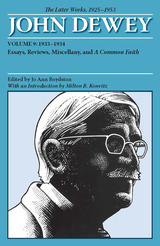 The Later Works of John Dewey, Volume 9, 1925 - 1953: 1933-1934, Essays, Reviews, Miscellany, and A Common Faith
John Dewey. Edited by Jo Ann Boydston
Southern Illinois University Press, 2008 This ninth volume in The Later Works of John Dewey, 1925—1953, brings together sixty items from 1933 and 1934, including Dewey’s Terry Lectures at Yale University, published as A Common Faith. In his introduction, Milton R. Konvitz concludes that A Common Faith remains a provocative book, an intellectual ‘teaser,’ an essay at religious philosophy which no philosopher can wholly bypass.” Dewey concentrated much of his writing in 1933 and 1934 on issues arising from the economic crises of the Great Depression. In the early 1930s Communist activity in the New York Teachers Union increased. The Report of the Special Grievance Committee of the Teachers Union is published in this volume, as is Dewey’s impromptu address, “On the Grievance Committee’s Report,” made when he presented that report. Rounding out the volume are eighteen articles from the People’s Lobby Bulletin.
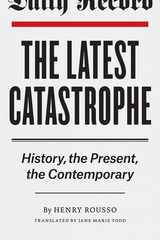 The Latest Catastrophe: History, the Present, the Contemporary
Henry Rousso
University of Chicago Press, 2016 The writing of recent history tends to be deeply marked by conflict, by personal and collective struggles rooted in horrific traumas and bitter controversies. Frequently, today’s historians can find themselves researching the same events that they themselves lived through. This book reflects on the concept and practices of what is called “contemporary history,” a history of the present time, and identifies special tensions in the field between knowledge and experience, distance and proximity, and objectivity and subjectivity.
Henry Rousso addresses the rise of contemporary history and the relations of present-day societies to their past, especially their legacies of political violence. Focusing on France, Germany, the United Kingdom, and the United States, he shows that for contemporary historians, the recent past has become a problem to be solved. No longer unfolding as a series of traditions to be respected or a set of knowledge to be transmitted and built upon, history today is treated as a constant act of mourning or memory, an attempt to atone. Historians must also negotiate with strife within this field, as older scholars who may have lived through events clash with younger historians who also claim to understand the experiences. Ultimately, The Latest Catastrophe shows how historians, at times against their will, have themselves become actors in a history still being made.
 Latin America and the Transports of Opera: Fragments of a Transatlantic Discourse
Roberto Ignacio Díaz
Vanderbilt University Press, 2023 Latin America and the Transports of Opera studies a series of episodes in the historical and textual convergence of a hallowed art form and a part of the world often regarded as peripheral. Perhaps unexpectedly, the archives of opera generate new arguments about several issues at the heart of the established discussion about Latin America: the allure of European cultural models; the ambivalence of exoticism; the claims of nationalism and cosmopolitanism; and, ultimately, the place of the region in the global circulation of the arts. Opera’s transports concern literal and imagined journeys as well as the emotions that its stories and sounds trigger as they travel back and forth between Europe—the United States, too—and Latin America.
Focusing mostly on librettos and other literary forms, this book analyzes Calderón de la Barca’s baroque play on the myth of Venus and Adonis, set to music by a Spanish composer at Lima’s viceregal court; Alejo Carpentier’s neobaroque novella on Vivaldi’s opera about Moctezuma; the entanglements of opera with class, gender, and ethnicity throughout Cuban history; music dramas about enslaved persons by Carlos Gomes and Hans Werner Henze, staged in Rio de Janeiro and Copenhagen; the uses of Latin American poetry and magical realism in works by John Adams and Daniel Catán; and a novel by Manuel Mujica Lainez set in Buenos Aires’s Teatro Colón, plus a chamber opera about Victoria Ocampo with a libretto by Beatriz Sarlo. Close readings of these texts underscore the import and meanings of opera in Latin American cultural history.
Latin America and the World Economy since 1800
John H. Coatsworth
Harvard University Press The fifteen essays in this volume apply the methods of the new economic history to the history of the Latin American economies since 1800. The authors combine the historian's sensitivity to context and contingency with modern or "neoclassical" economic theory and quantitative methods.
The essays shed new light on the economic history of all the major economies from Mexico and Cuba to Brazil and Argentina. Some focus on comparing macroeconomic policies and performance, others analyze key sectors such as foreign trade, finance, transportation, and industry, and still others focus on the impact of property rights, government regulation, and political upheaval.
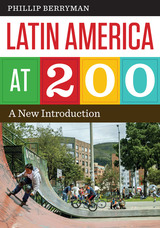 Latin America at 200: A New Introduction
By Phillip Berryman
University of Texas Press, 2016 Between 2010 and 2025, most of the countries of Latin America will commemorate two centuries of independence, and Latin Americans have much to celebrate at this milestone. Most countries have enjoyed periods of sustained growth, while inequality is showing modest declines and the middle class is expanding. Dictatorships have been left behind, and all major political actors seem to have accepted the democratic process and the rule of law. Latin Americans have entered the digital world, routinely using the Internet and social media. These new realities in Latin America call for a new introduction to its history and culture, which Latin America at 200 amply provides. Taking a reader-friendly approach that focuses on the big picture and uses concrete examples, Phillip Berryman highlights what Latin Americans are doing to overcome extreme poverty and underdevelopment. He starts with issues facing cities, then considers agriculture and farming, business, the environment, inequality and class, race and ethnicity, gender, and religion. His survey of Latin American history leads into current issues in economics, politics and governance, and globalization. Berryman also acknowledges the ongoing challenges facing Latin Americans, especially crime and corruption, and the efforts being made to combat them. Based on decades of experience, research, and travel, as well as recent studies from the World Bank and other agencies, Latin America at 200 will be essential both as a classroom text and as an introduction for general readers.
Latin America in Caricature
By John J. Johnson
University of Texas Press, 1993 “Not many readers will thank the author as he deserves, for he has told us more about ourselves than we perhaps wish to know,” predicted Latin America in Books of Latin America in Caricature—an exploration of more than one hundred years of hemispheric relations through political cartoons collected from leading U.S. periodicals from the 1860s through 1980. The cartoons are grouped according to recurring themes in diplomacy and complementing visual imagery. Each one is accompanied by a lengthy explanation of the incident portrayed, relating the drawing to public opinion of the day. Johnson’s thoughtful introduction and the comments that precede the individual chapters provide essential background for understanding U.S. attitudes and policies toward Latin America.
 Latin America in Debate: Indigeneity, Development, Dependency, Populism
Maristella Svampa
Duke University Press, 2025 In Latin America in Debate, eminent Argentine social theorist, novelist, and activist Maristella Svampa provides a broad and accessible overview of the key political and intellectual debates in Latin America from the early twentieth century to the present. She examines four main topics: the place of indigenous peoples in postcolonial nation-states; the impact of development on the Latin American political imagination; the impact of being economically dependent within a global capitalist order; and the turn to populism as a particular political response to these various challenges. Svampa traces each debate’s genealogy, contextualizes them over the course of the twentieth century, and demonstrates how intellectual and sociological currents have redefined and reshaped them in the twenty-first. Svampa also maps the tensions in each and shows how they influence contemporary Latin American politics. By focusing on indigeneity, development, dependency, and populism, Svampa provides a clear entry point to understand the most pressing issues confronting Latin America while showcasing how the region’s intellectuals have been thinking about and debating these issues in ways that generate social theory with global implications.
Latin America in the 21st Century: Challenges and Solutions
Edited by Gregory Knapp
University of Texas Press, 2002 This book showcases the achievements of geographers in helping understand and solve major problems facing Latin America. Chapters cover a variety of topics from conservation to transportation to gender. Each chapter is written by an expert in the geography of Latin America. The chapters include case studies of recent problems or issues in Latin America and provide examples of geographic research that has helped illuminate or solve these problems.
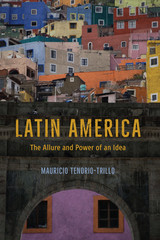 Latin America: The Allure and Power of an Idea
Mauricio Tenorio-Trillo
University of Chicago Press, 2017 “Latin America” is a concept firmly entrenched in its philosophical, moral, and historical meanings. And yet, Mauricio Tenorio-Trillo argues in this landmark book, it is an obsolescent racial-cultural idea that ought to have vanished long ago with the banishment of racial theory. Latin America: The Allure and Power of an Idea makes this case persuasively.
Tenorio-Trillo builds the book on three interlocking steps: first, an intellectual history of the concept of Latin America in its natural historical habitat—mid-nineteenth-century redefinitions of empire and the cultural, political, and economic intellectualism; second, a serious and uncompromising critique of the current “Latin Americanism”—which circulates in United States–based humanities and social sciences; and, third, accepting that we might actually be stuck with “Latin America,” Tenorio-Trillo charts a path forward for the writing and teaching of Latin American history. Accessible and forceful, rich in historical research and specificity, the book offers a distinctive, conceptual history of Latin America and its many connections and intersections of political and intellectual significance. Tenorio-Trillo’s book is a masterpiece of interdisciplinary scholarship.
Latin American Adventures in Literary Journalism
Pablo Calvi
University of Pittsburgh Press, 2019 Latin American Adventures in Literary Journalismexplores the central role of narrative journalism in the formation of national identities in Latin America, and the concomitant role the genre had in the consolidation of the idea of Latin America as a supra-national entity. This work discusses the impact that the form had in the creation of an original Latin American literature during six historical moments. Beginning in the 1840s and ending in the 1970s, Calvi connects the evolution of literary journalism with the consolidation of Latin America’s literary sphere, the professional practice of journalism, the development of the modern mass media, and the establishment of nation-states in the region.
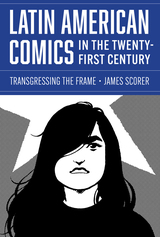 Latin American Comics in the Twenty-First Century: Transgressing the Frame
James Scorer
University of Texas Press, 2024 How twenty-first-century Latin American comics transgress social, political, and cultural frontiers. Given comics’ ability to cross borders, Latin American creators have used the form to transgress the political, social, spatial, and cultural borders that shape the region. A groundbreaking and comprehensive study of twenty-first-century Latin American comics, Latin American Comics in the Twenty-First Century documents how these works move beyond national boundaries and explores new aspects of the form, its subjects, and its creators. Latin American comics production is arguably more interconnected and more networked across national borders than ever before. Analyzing works from Argentina, Chile, Colombia, Mexico, Peru, and Uruguay, James Scorer organizes his study around forms of “transgression,” such as transnationalism, border crossings, transfeminisms, punk bodies, and encounters in the neoliberal city. Scorer examines the feminist comics collective Chicks on Comics; the DIY comics zine world; nonfiction and journalistic comics; contagion and zombie narratives; and more. Drawing from archives across the United States, Europe, and Latin America, Latin American Comics in the Twenty-First Century posits that these comics produce micronarratives of everyday life that speak to sites of social struggle shared across nation states.
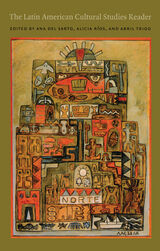 The Latin American Cultural Studies Reader
Ana Del Sarto, Alicia Ríos and Abril Trigo, eds.
Duke University Press, 2004 The Latin American Cultural Studies Reader brings together thirty-six field-defining essays by the most prominent theorists of Latin American cultural studies. Written over the past several decades, these essays provide an assessment of Latin American cultural studies, an account of the field’s historical formation, and an outline of its significant ideological and methodological trends and theoretical controversies. With many essays appearing in English for the first time, the collection offers a comprehensive view of the specific problems, topics, and methodologies that characterize Latin American cultural studies vis-à-vis British and U.S. cultural studies. Divided into sections preceded by brief introductory essays, this volume traces the complex development of Latin American cultural studies from its roots in literary criticism and the economic, social, political, and cultural transformations wrought by neoliberal policies in the 1970s. It tracks the impassioned debates within the field during the early 1990s; explores different theoretical trends, including studies of postcolonialism, the subaltern, and globalization; and reflects on the significance of Latin American cultural studies for cultural studies projects outside Latin America. Considering literature, nationalism, soccer, cinema, postcolonialism, the Zapatistas, community radio, and much more, The Latin American Cultural Studies Reader is an invaluable resource for all those who want to understand the past, present, and future of Latin American cultural studies. Contributors. Hugo Achugar, Eduardo Archetti, John Beverley, José Joaquín Brunner, Antonio Candido, Debra A. Castillo, Antonio Cornejo Polar, Román de la Campa, Ana Del Sarto, Roberto Fernández Retamar, Juan Flores, Jean Franco, Néstor García Canclini, María Gudelia Rangel Gómez, Adrián Gorelik, John Kraniauskas, Neil Larsen, Ana López, Jesús Martín-Barbero, Francine Masiello, Daniel Mato, Walter D. Mignolo, Carlos Monsiváis, Mabel Moraña, Alberto Moreiras, Renato Ortiz, José Rabasa, Angel Rama, Gustavo A. Remedi, Darcy Ribeiro, Nelly Richard, Alicia Ríos, Beatriz Sarlo, Roberto Schwarz, Irene Silverblatt, Graciela Silvestri, Armando Rosas Solís, Beatriz González Stephan, Abril Trigo, George Yúdice
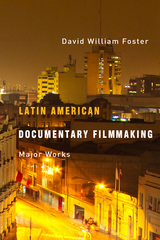 Latin American Documentary Filmmaking: Major Works
David William Foster
University of Arizona Press, 2013 Latin American Documentary Filmmaking is the first volume written in English to explore Latin American documentary filmmaking with extensive and intelligent analysis. David William Foster, the leading authority on Latin American urban cultural production, provides rich, new interpretations on the production of gender, political persecution, historical conflicts, and exclusion from the mainstream in many of Latin America’s most important documentary films.
Foster provides a series of detailed examinations of major texts of Latin American filmmaking, discussing their textual production and processes of meaning. His analysis delves deeply into the world of Latin American film and brings forth a discourse of structure that has previously been absent from the fields of filmmaking and Latin American studies. This volume provides perspective on diverse and methodological approaches, pulling from a wide scope of cinematic traditions. Using his own critical readings and research, Foster presents his findings in terms that are accessible to non-Spanish speakers and Latin American film enthusiasts.
A much-needed contribution to the field of Latin American documentary film, Foster’s research and perspective will be a valuable source for those interested in film studies, gender studies, and culture.
 The Latin American Ecocultural Reader
Edited by Jennifer French and Gisela Heffes
Northwestern University Press, 2021 The Latin American Ecocultural Reader is a comprehensive anthology of literary and cultural texts about the natural world. The selections, drawn from throughout the Spanish-speaking countries and Brazil, span from the early colonial period to the present. Editors Jennifer French and Gisela Heffes present work by canonical figures, including José Martí, Bartolomé de las Casas, Rubén Darío, and Alfonsina Storni, in the context of our current state of environmental crisis, prompting new interpretations of their celebrated writings. They also present contemporary work that illuminates the marginalized environmental cultures of women, indigenous, and Afro-Latin American populations. Each selection is introduced with a short essay on the author and the salience of their work; the selections are arranged into eight parts, each of which begins with an introductory essay that speaks to the political, economic, and environmental history of the time and provides interpretative cues for the selections that follow. The editors also include a general introduction with a concise overview of the field of ecocriticism as it has developed since the 1990s. They argue that various strands of environmental thought—recognizable today as extractivism, eco-feminism, Amerindian ontologies, and so forth—can be traced back through the centuries to the earliest colonial period, when Europeans first described the Americas as an edenic “New World” and appropriated the bodies of enslaved Indians and Africans to exploit its natural bounty.
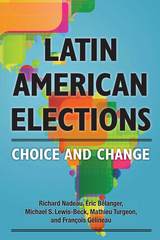 Latin American Elections: Choice and Change
Richard Nadeau, Éric Bélanger, Michael S. Lewis-Beck, Mathieu Turgeon, and François Gélineau
University of Michigan Press, 2017 The Michigan model, named after the institution where it was first articulated, has been used to explain voting behavior in North American and Western European democracies. In Latin American Elections, experts on Latin America join with experts on electoral studies to evaluate the model’s applicability in this region. Analyzing data from the AmericasBarometer, a scientific public opinion survey carried out in 18 Latin American nations from 2008 to 2012, the authors find that, like democratic voters elsewhere, Latin Americans respond to long-term forces, such as social class, political party ties, and political ideology while also paying attention to short-term issues, such as the economy, crime, corruption. Of course, Latin Americans differ from other Americans, and among themselves. Voters who have experienced left-wing populism may favor government curbs on freedom of expression, for example, while voters enduring high levels of economic deprivation or instability tend to vote against the party in power. The authors thus conclude that, to a surprising extent, the Michigan model offers a powerful explanatory model for voting behavior in Latin America.
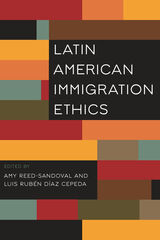 Latin American Immigration Ethics
Edited by Amy Reed-Sandoval Luis Rubén Díaz Cepeda
University of Arizona Press, 2021 Following an extended period of near silence on the subject, many social and political philosophers are now treating immigration as a central theme of the discipline. For the first time, this edited volume brings together original works by prominent philosophers writing about immigration ethics from within a Latin American context.
Without eschewing relevant conceptual resources derived from European and Anglo-American philosophies, the essays in this book emphasize Latin American and Latinx philosophies, decolonial and feminist theories, and Indigenous philosophies of Latin America, in the pursuit of an immigration ethics. The contributors explore the moral challenges of immigration that either arise within Latin America, or when Latin Americans and Latina/o/xs migrate to and reside within the United States. Uniquely, some chapters focus on south to south migration. Contributors also examine Latina/o/x experiences in the United States, addressing the lacuna of philosophical writing on migration, maternity, and childhood.
Latin American Immigration Ethics advances philosophical conversations and debates about immigration by theorizing migration from the Latin American and Latinx context.
Contributors
Luis Rubén Díaz Cepeda, Lori Gallegos, Margaret Griesse, Eduardo Mendieta, José Jorge Mendoza, Amos Nascimento, Carlos Pereda, Silvana Rabinovich, Amy Reed-Sandoval, Raúl Villarroel, Allison B. Wolf
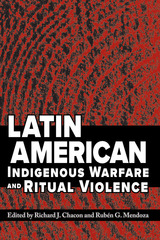 Latin American Indigenous Warfare and Ritual Violence
Edited by Richard J. Chacon and Rubén G. Mendoza
University of Arizona Press, 2007 This groundbreaking multidisciplinary book presents significant essays on historical indigenous violence in Latin America from Tierra del Fuego to central Mexico. The collection explores those uniquely human motivations and environmental variables that have led to the native peoples of Latin America engaging in warfare and ritual violence since antiquity. Based on an American Anthropological Association symposium, this book collects twelve contributions from sixteen authors, all of whom are scholars at the forefront of their fields of study.
All of the chapters advance our knowledge of the causes, extent, and consequences of indigenous violence—including ritualized violence—in Latin America. Each major historical/cultural group in Latin America is addressed by at least one contributor. Incorporating the results of dozens of years of research, this volume documents evidence of warfare, violent conflict, and human sacrifice from the fifteenth century to the twentieth, including incidents that occurred before European contact. Together the chapters present a convincing argument that warfare and ritual violence have been woven into the fabric of life in Latin America since remote antiquity.
For the first time, expert subject-area work on indigenous violence—archaeological, osteological, ethnographic, historical, and forensic—has been assembled in one volume. Much of this work has heretofore been dispersed across various countries and languages. With its collection into one English-language volume, all future writers—regardless of their discipline or point of view—will have a source to consult for further research.
CONTENTS
Acknowledgments
Introduction
Richard J. Chacon and Rubén G. Mendoza
1. Status Rivalry and Warfare in the Development and Collapse of Classic Maya Civilization
Matt O’Mansky and Arthur A. Demarest
2. Aztec Militarism and Blood Sacrifice: The Archaeology and Ideology of Ritual Violence
Rubén G. Mendoza
3. Territorial Expansion and Primary State Formation in Oaxaca, Mexico
Charles S. Spencer
4. Images of Violence in Mesoamerican Mural Art
Donald McVicker
5. Circum-Caribbean Chiefly Warfare
Elsa M. Redmond
6. Conflict and Conquest in Pre-Hispanic Andean South America: Archaeological Evidence from Northern Coastal Peru
John W. Verano
7. The Inti Raymi Festival among the Cotacachi and Otavalo of Highland Ecuador: Blood for the Earth
Richard J. Chacon, Yamilette Chacon, and Angel Guandinango
8. Upper Amazonian Warfare
Stephen Beckerman and James Yost
9. Complexity and Causality in Tupinambá Warfare
William Balée
10. Hunter-Gatherers’ Aboriginal Warfare in Western Chaco
Marcela Mendoza
11. The Struggle for Social Life in Fuego-Patagonia
Alfredo Prieto and Rodrigo Cárdenas
12. Ethical Considerations and Conclusions Regarding Indigenous Warfare and Ritual Violence in Latin America
Richard J. Chacon and Rubén G. Mendoza
References
About the Contributors
Index
Latin American Jewish Cultural Production
David William Foster
Vanderbilt University Press, 2008 Latin America is home to roughly half a million Jews, preponderantly Ashkenazic Jews. The majority are concentrated in Argentina, but Brazil and Mexico are also home to significant Jewish communities, as are major urban centers in other countries. Jews in Latin America, in addition to their prominent role in business, commerce, and finance, have a significant presence in cultural production and the arts. Like Hollywood, the Argentine and Mexican film industry is heavily Jewish, while the media--print journalism, radio, and television--have long been associated with Jewish interests. The open enrollment policies of many countries--Argentina, Brazil, and Mexico are notable here--have meant that Jews also have a considerable presence in academic and intellectual circles.
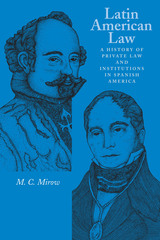 Latin American Law: A History of Private Law and Institutions in Spanish America
By M. C. Mirow
University of Texas Press, 2004 Private law touches every aspect of people's daily lives—landholding, inheritance, private property, marriage and family relations, contracts, employment, and business dealings—and the court records and legal documents produced under private law are a rich source of information for anyone researching social, political, economic, or environmental history. But to utilize these records fully, researchers need a fundamental understanding of how private law and legal institutions functioned in the place and time period under study. This book offers the first comprehensive introduction in either English or Spanish to private law in Spanish Latin America from the colonial period to the present. M. C. Mirow organizes the book into three substantial sections that describe private law and legal institutions in the colonial period, the independence era and nineteenth century, and the twentieth century. Each section begins with an introduction to the nature and function of private law during the period and discusses such topics as legal education and lawyers, legal sources, courts, land, inheritance, commercial law, family law, and personal status. Each section also presents themes of special interest during its respective time period, including slavery, Indian status, codification, land reform, and development and globalization.
 The Latin American Literary Boom and U.S. Nationalism during the Cold War
Deborah Cohn
Vanderbilt University Press, 2012 During the 1960s and 1970s, when writers such as Julio Cortazar, Carlos Fuentes, Gabriel Garcia Marquez, and Mario Vargas Llosa entered the international literary mainstream, Cold War cultural politics played an active role in disseminating their work in the United States. Deborah Cohn documents how U.S. universities, book and journal publishers, philanthropic organizations, cultural centers, and authors coordinated their efforts to bring Latin American literature to a U.S. reading public during this period, when interest in the region was heightened by the Cuban Revolution. She also traces the connections between the endeavors of private organizations and official foreign policy goals.
The high level of interest in Latin America paradoxically led the U.S. government to restrict these authors' physical presence in the United States through the McCarranWalter Act's immigration blacklist, even as cultural organizations cultivated the exchange of ideas with writers and sought to market translations of their work for the U.S. market.
Latin American Literature at the Millennium: Local Lives, Global Spaces
Cecily Raynor
Bucknell University Press, 2021 Latin American Literature at the Millennium: Local Lives, Global Spaces analyzes literary constructions of locality from the early 1990s to the mid 2010s. In this astute study, Raynor reads work by Roberto Bolaño, Valeria Luiselli, Luiz Ruffato, Bernardo Carvalho, João Gilberto Noll, and Wilson Bueno to reveal representations of the human experience that unsettle conventionally understood links between locality and geographical place. The book raises vital considerations for understanding the region’s transition into the twenty-first century, and for evaluating Latin American authors’ representations of everyday place and modes of belonging.
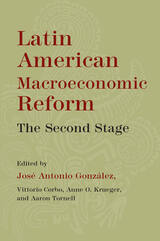 Latin American Macroeconomic Reforms: The Second Stage
Edited by José Antonio González, Vittorio Corbo, Anne O. Krueger, and Aaron Tornell
University of Chicago Press, 2003 Hidden behind a number of economic crises in the mid- to late 1990s-including Argentina's headline-grabbing monetary and political upheaval-is that fact that Latin American economies have, generally speaking, improved dramatically in recent years. Their success has been due, in large part, to macroeconomic reforms, and this book brings together prominent economists and policymakers to assess a decade of such policy shifts, highlighting both the many success stories and the areas in which further work is needed. Contributors offer both case studies of individual countries and regional overviews, covering monetary, financial, and fiscal policy.
Contributors also work to identify future concerns and erect clear signposts for future reforms. For instance, now that inflation rates have been stabilized, one suggested "second stage" monetary reform would be to focus on reducing rates from high to low single digits. Financial sector reforms, it is suggested, should center on improving regulation and supervision. And, contributors argue, since fiscal stability has already been achieved in most countries, new fiscal reforms need to concentrate on institutionalizing fiscal discipline, improving the efficiency and equity of tax collection, and modifying institutional arrangements to deal with increasingly decentralized federal systems.
The analysis and commentary in this volume-authored not only by academic observers but by key Latin American policymakers with decades of firsthand experience-will prove important to anyone with an interest in the future of Latin American's continuing economic development and reform.
Contributors to this volume:
José Antonio González, Stanford University
Anne O. Krueger, International Monetary Fund
Vittorio Corbo, Pontifical Catholic University, Chile
Klaus Schmidt-Hebbel, Central Bank of Chile
Alejandro Werner, Bank of Mexico
Márcio G. P. Garcia, Pontifical Catholic University, Rio
Tatiana Didier, World Bank
Gustavo H. B. Franco, former president, Central Bank of Brazil
Francisco Gil Díaz, Minister of the Treasury, Mexico
Roberto Zahler, former governor, Central Bank of Chile
Ricardo J. Caballero, Massachusetts Institute of Technology
Philip L. Brock, University of Washington
Stephen Haber, Stanford University
Pablo E. Guidotti, Universidad Torcuato Di Tella, Buenos Aires
Vito Tanzi, International Monetary Fund
Enrique Dávila, Ministry of Finance, Mexico
Santiago Levy, Mexican Social Security Institute
Ricardo Fenochietto, private consultant, Buenos Aires
Rogério L. F. Werneck, Pontifical Catholic University, Rio
Carola Pessino, Universidad Torcuato di Tella, Buenos Aires
Michael Michaely, Hebrew University of Jerusalem
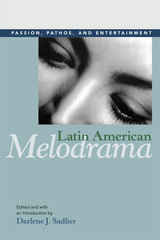 Latin American Melodrama: Passion, Pathos, and Entertainment
Edited and with an Introduction by Darlene J. Sadlier
University of Illinois Press, 2008 Like their Hollywood counterparts, Latin American film and TV melodramas have always been popular and highly profitable. The first of its kind, this anthology engages in a serious study of the aesthetics and cultural implications of Latin American melodramas. Written by some of the major figures in Latin American film scholarship, the studies range across seventy years of movies and television within a transnational context, focusing specifically on the period known as the "Golden Age" of melodrama, the impact of classic melodrama on later forms, and more contemporary forms of melodrama. An introductory essay examines current critical and theoretical debates on melodrama and places the essays within the context of Latin American film and media scholarship. Contributors are Luisela Alvaray, Mariana Baltar, Catherine L. Benamou, Marvin D’Lugo, Paula Félix-Didier, Andrés Levinson, Gilberto Perez, Darlene J. Sadlier, Cid Vasconcelos, and Ismail Xavier.
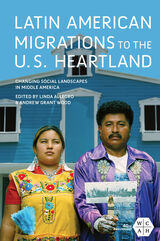 Latin American Migrations to the U.S. Heartland: Changing Social Landscapes in Middle America
Edited by Linda Allegro and Andrew Grant Wood
University of Illinois Press, 2019 This collection examines Latina/o immigrants and the movement of the Latin American labor force to the central states of Oklahoma, Kansas, Nebraska, Arkansas, Missouri, and Iowa. Contributors look at outside factors affecting migration, including corporate agriculture, technology, globalization, and government. They also reveal how cultural affinities like religion, strong family ties, farming, and cowboy culture attract these newcomers to the Heartland. Throughout, essayists point to how hostile neoliberal policy reforms have made it difficult for Latin American immigrants to find social and economic stability. Filled with varied and eye-opening perspectives, Latin American Migrations to the U.S. Heartland reveals how identities, economies, and geographies are changing as Latin Americans adjust to their new homes, jobs, and communities. Contributors: Linda Allegro, Tisa M. Anders, Scott Carter, Caitlin Didier, Miranda Cady Hallett, Edmund Hamann, Albert Iaroi, Errol D. Jones, Jane Juffer, László J. Kulcsár, Janelle Reeves, Jennifer F. Reynolds, Sandi Smith-Nonini, and Andrew Grant Wood.
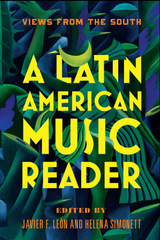 A Latin American Music Reader: Views from the South
Javier F Leon
University of Illinois Press, 2016 Javier F. León and Helena Simonett curate a collection of essential writings from the last twenty-five years of Latin American music studies. Chosen as representative, outstanding, and influential in the field, each article appears in English translation. A detailed new introduction by León and Simonett both surveys and contextualizes the history of Latin American ethnomusicology, opening the door for readers energized by the musical forms brought and nurtured by immigrants from throughout Latin America. Contributors include Marina Alonso Bolaños, Gonzalo Camacho Díaz, José Jorge de Carvalho, Claudio F. Díaz, Rodrigo Cantos Savelli Gomes, Juan Pablo González, Rubén López-Cano, Angela Lühning, Jorge Martínez Ulloa, Maria Ignêz Cruz Mello, Julio Mendívil, Carlos Miñana Blasco, Raúl R. Romero, Iñigo Sánchez Fuarros, Carlos Sandroni, Carolina Santamaría-Delgado, Rodrigo Torres Alvarado, and Alejandro Vera.
|
|

